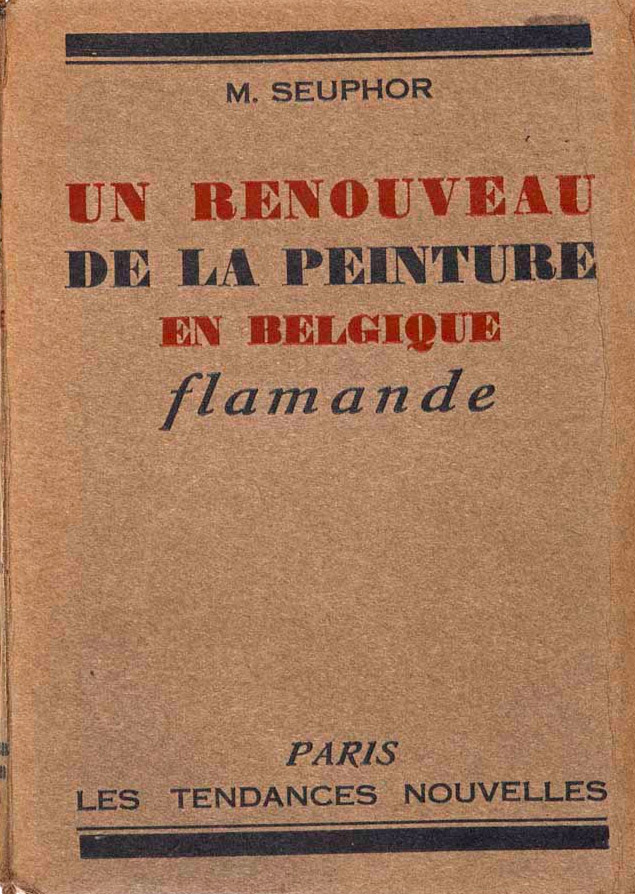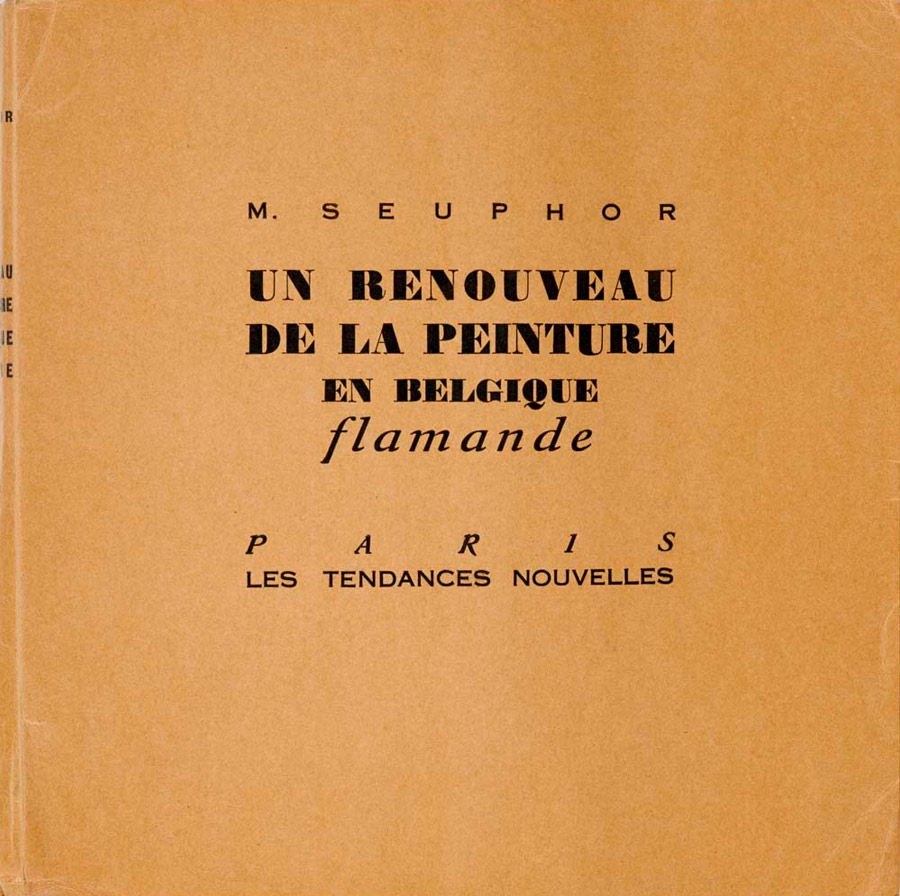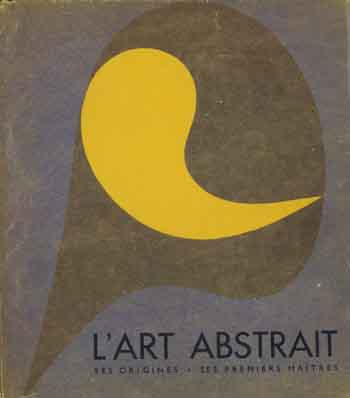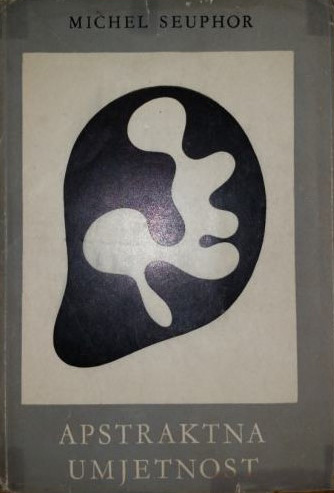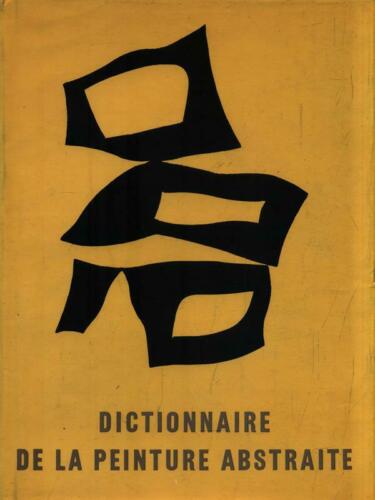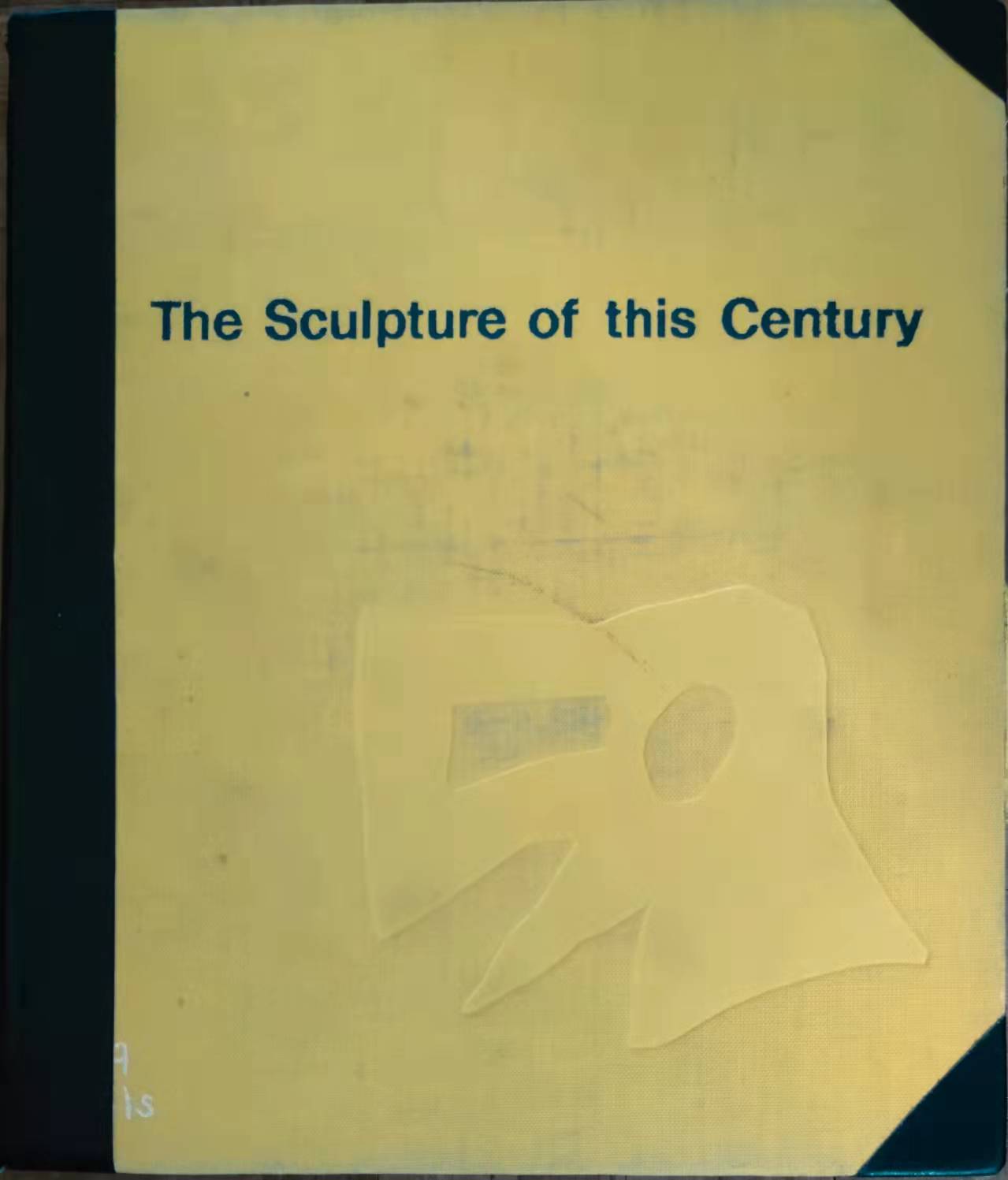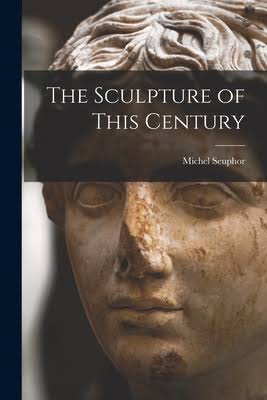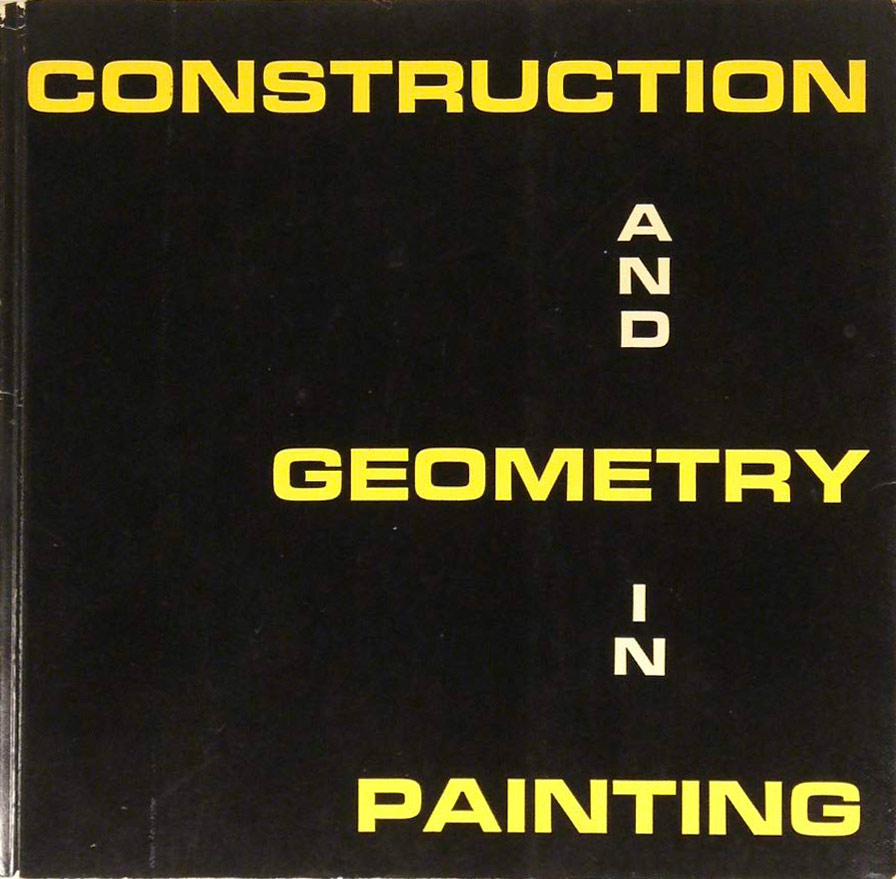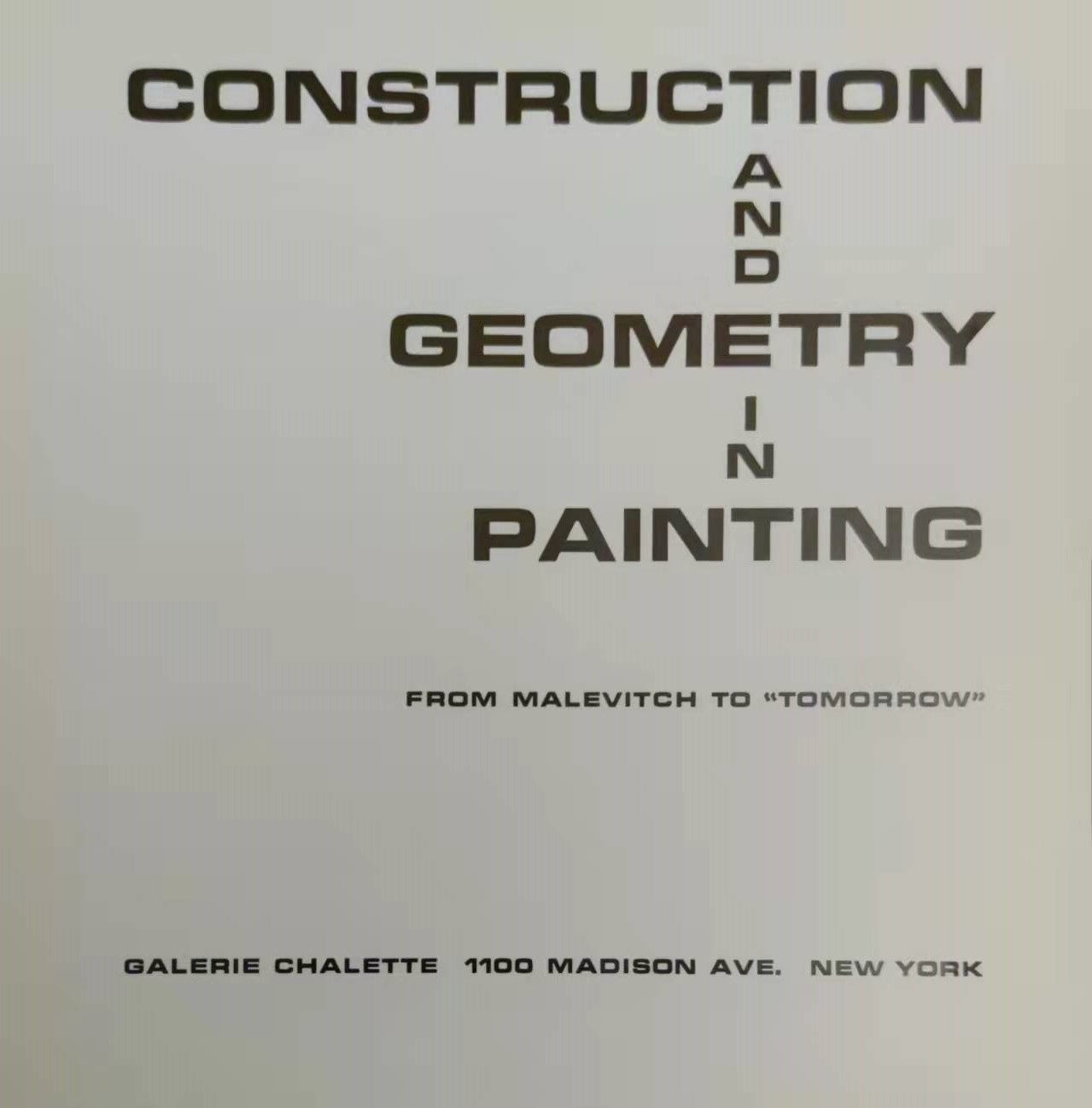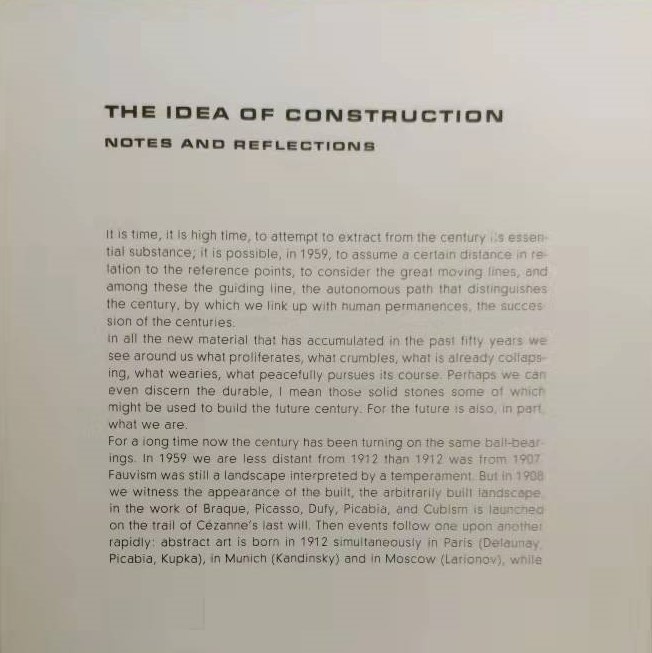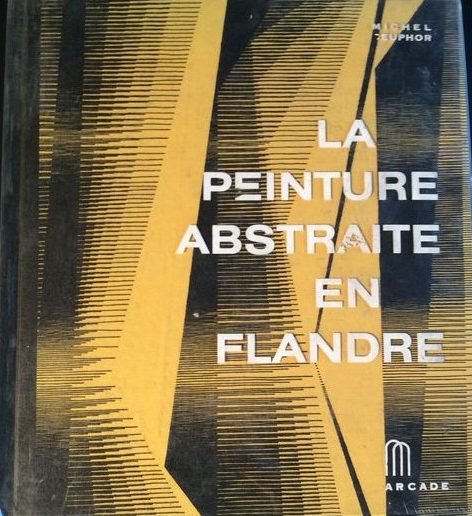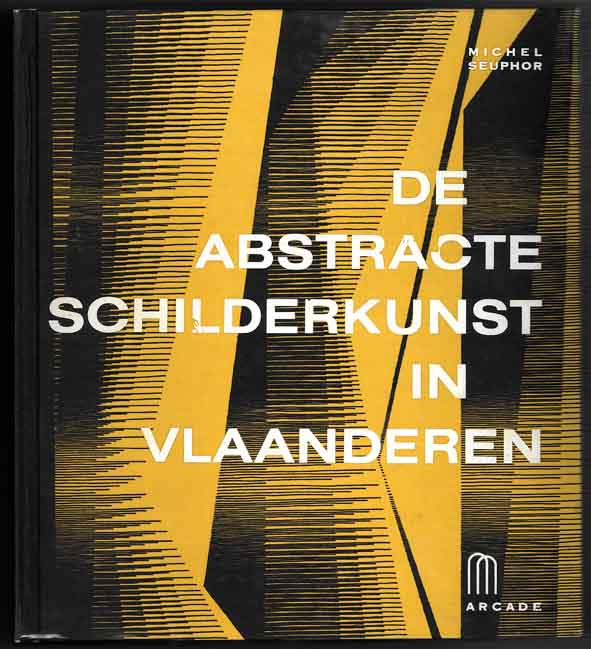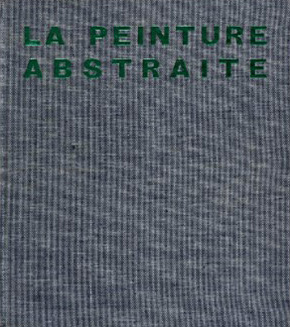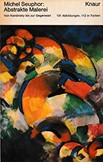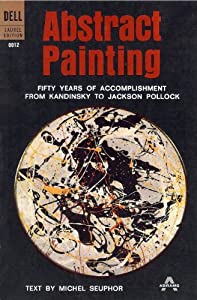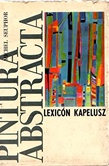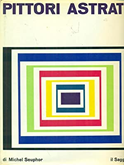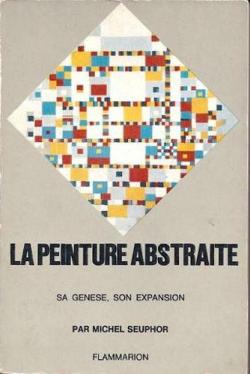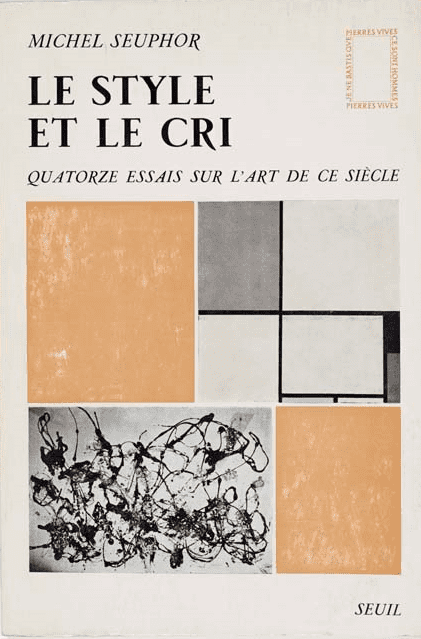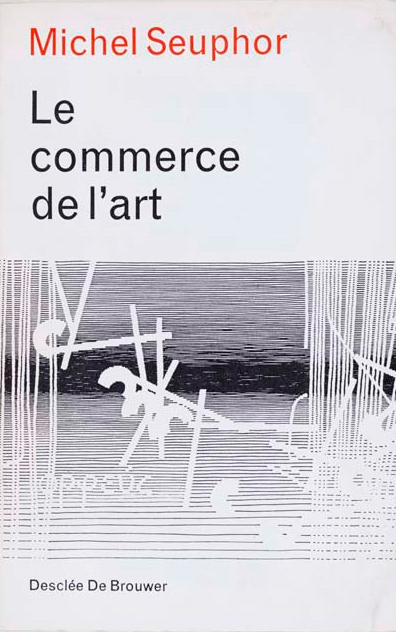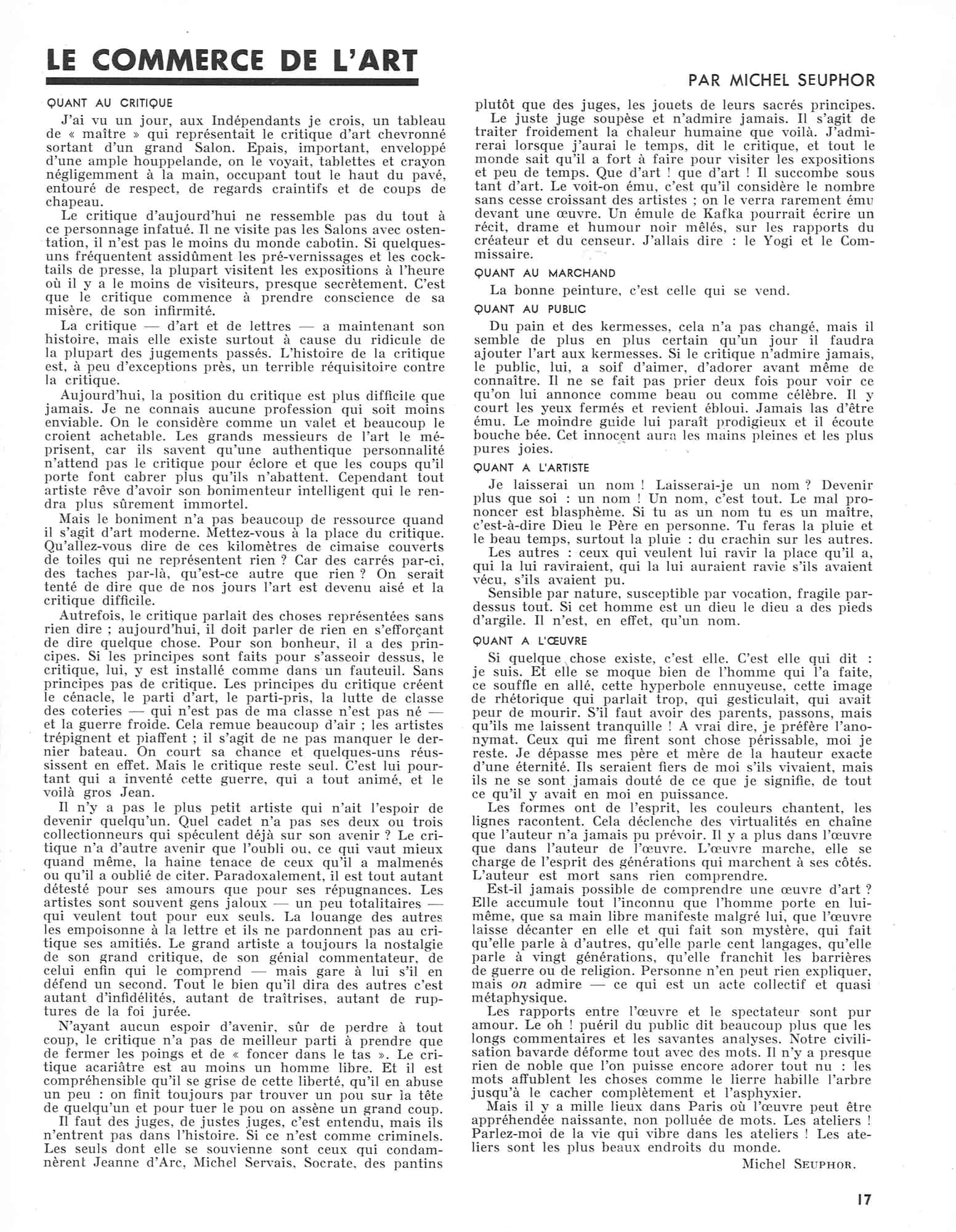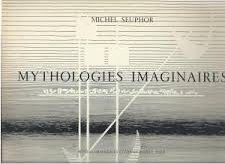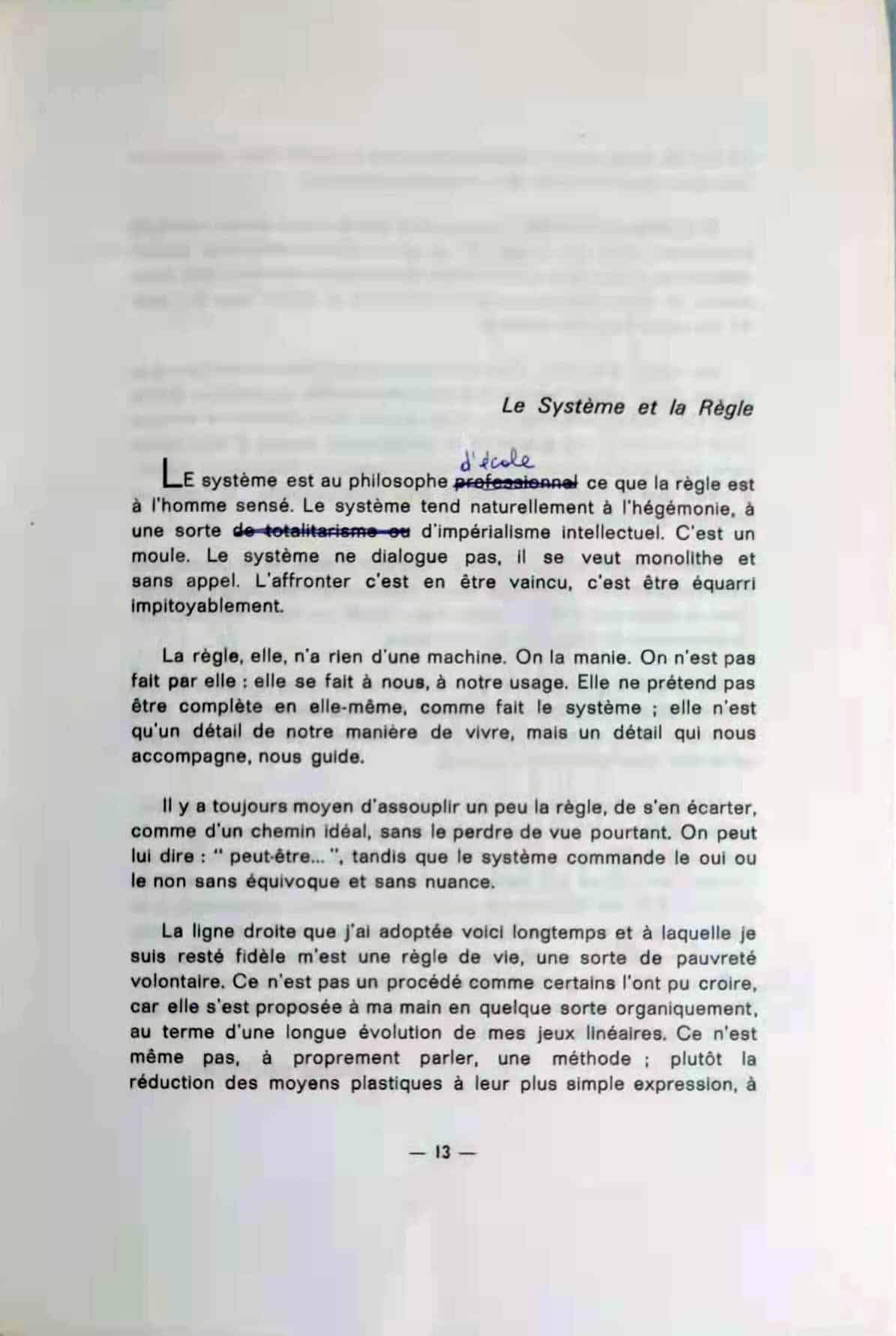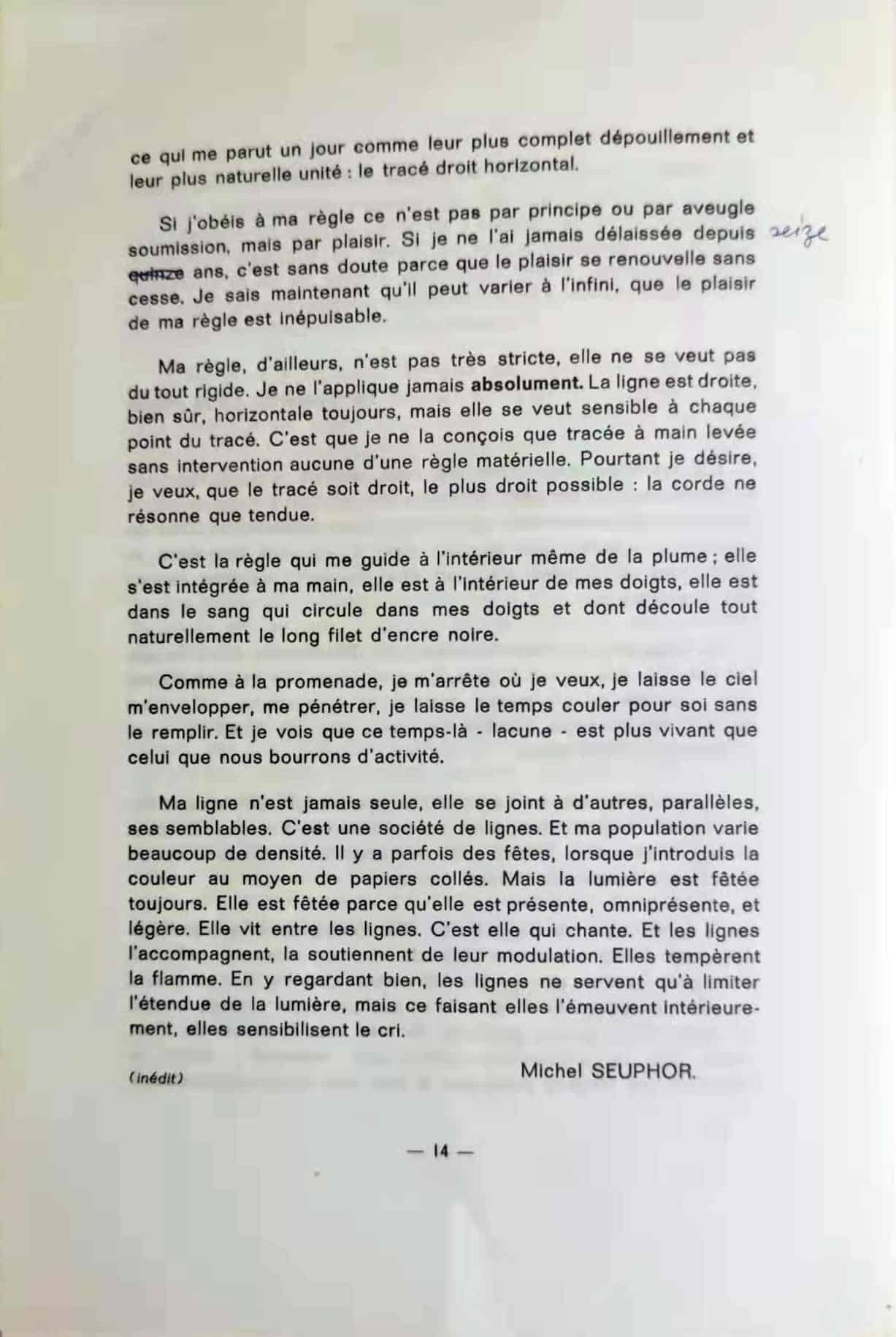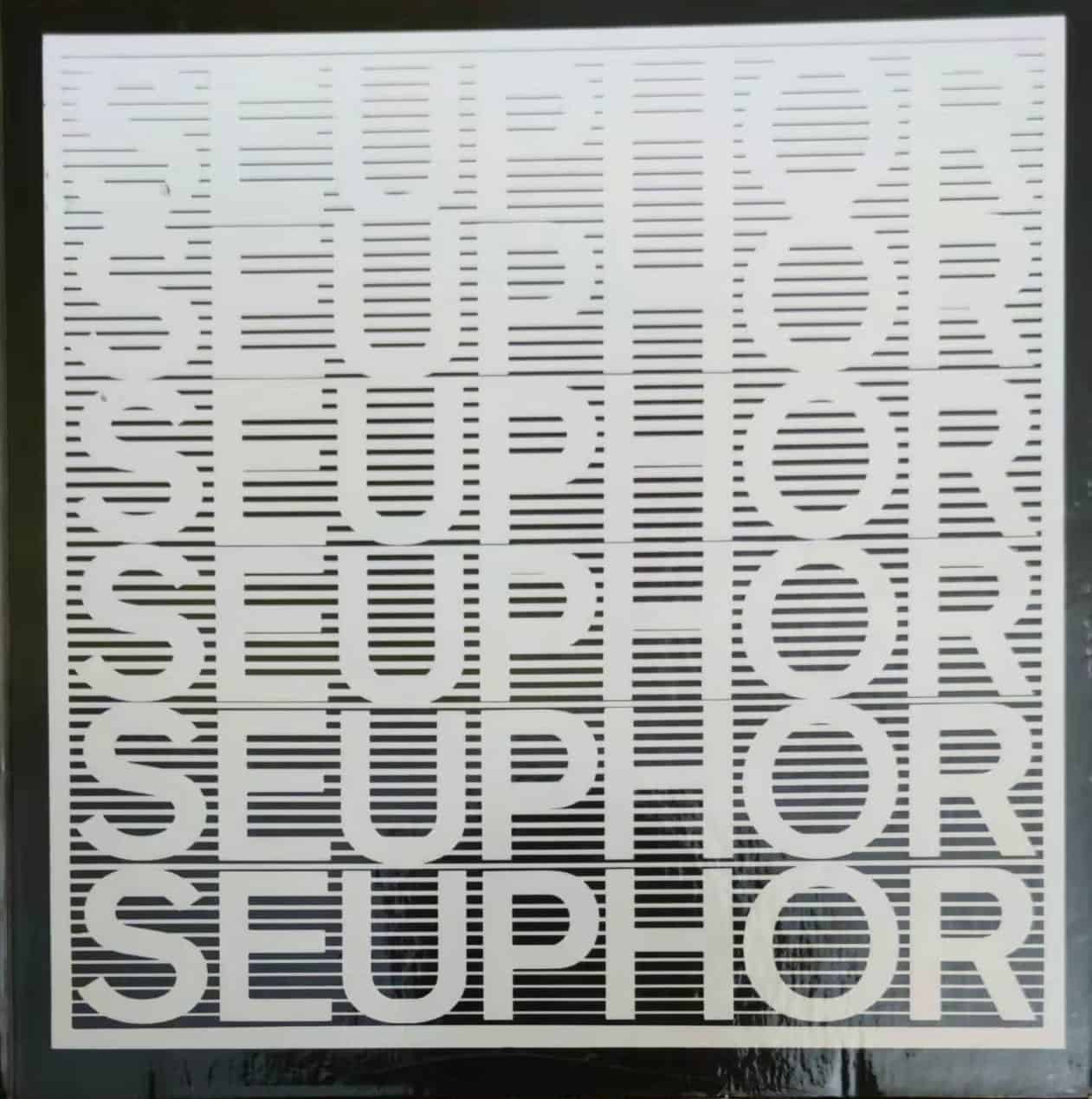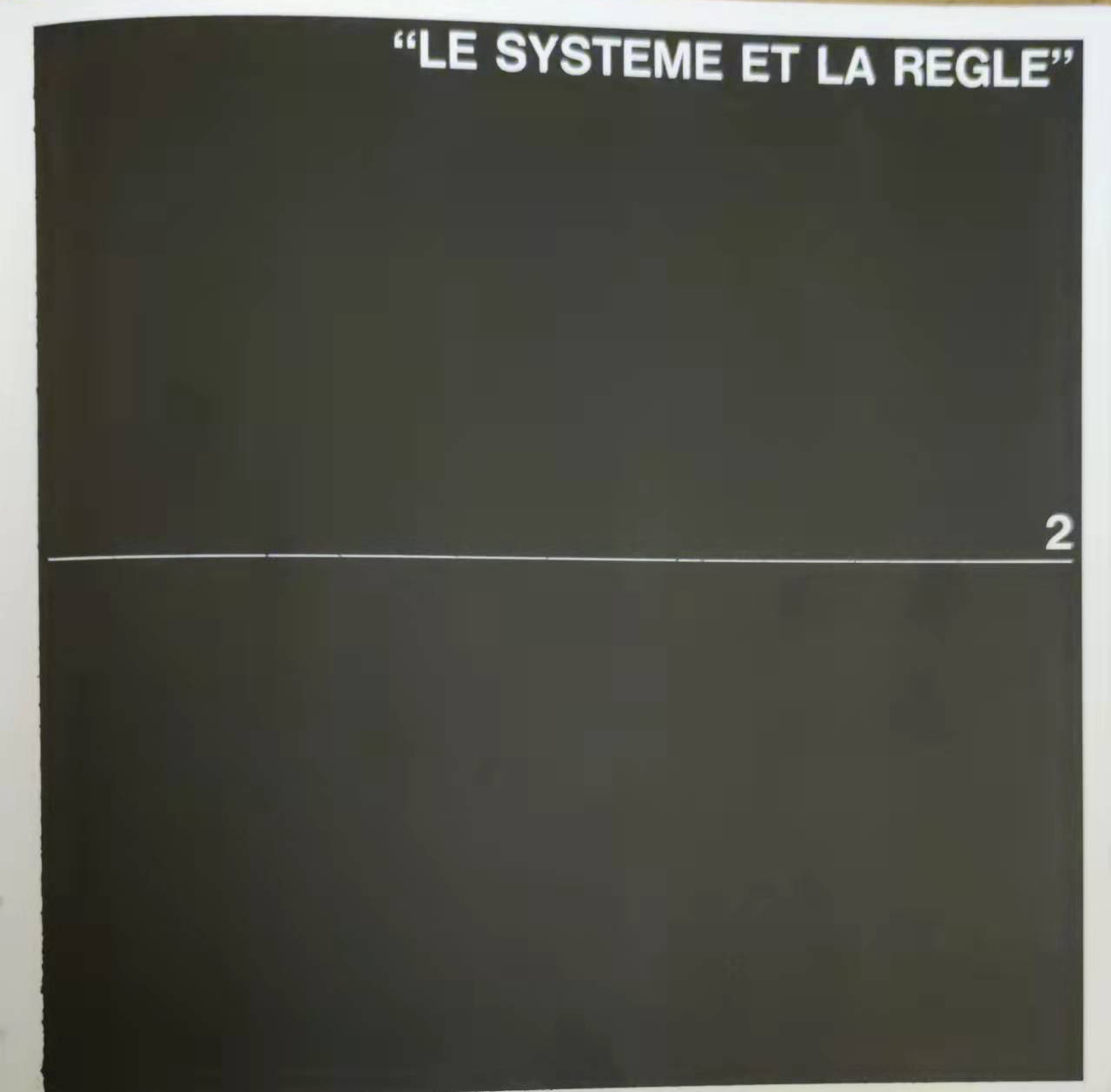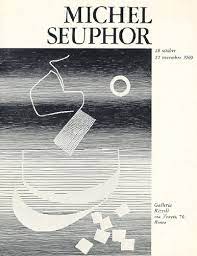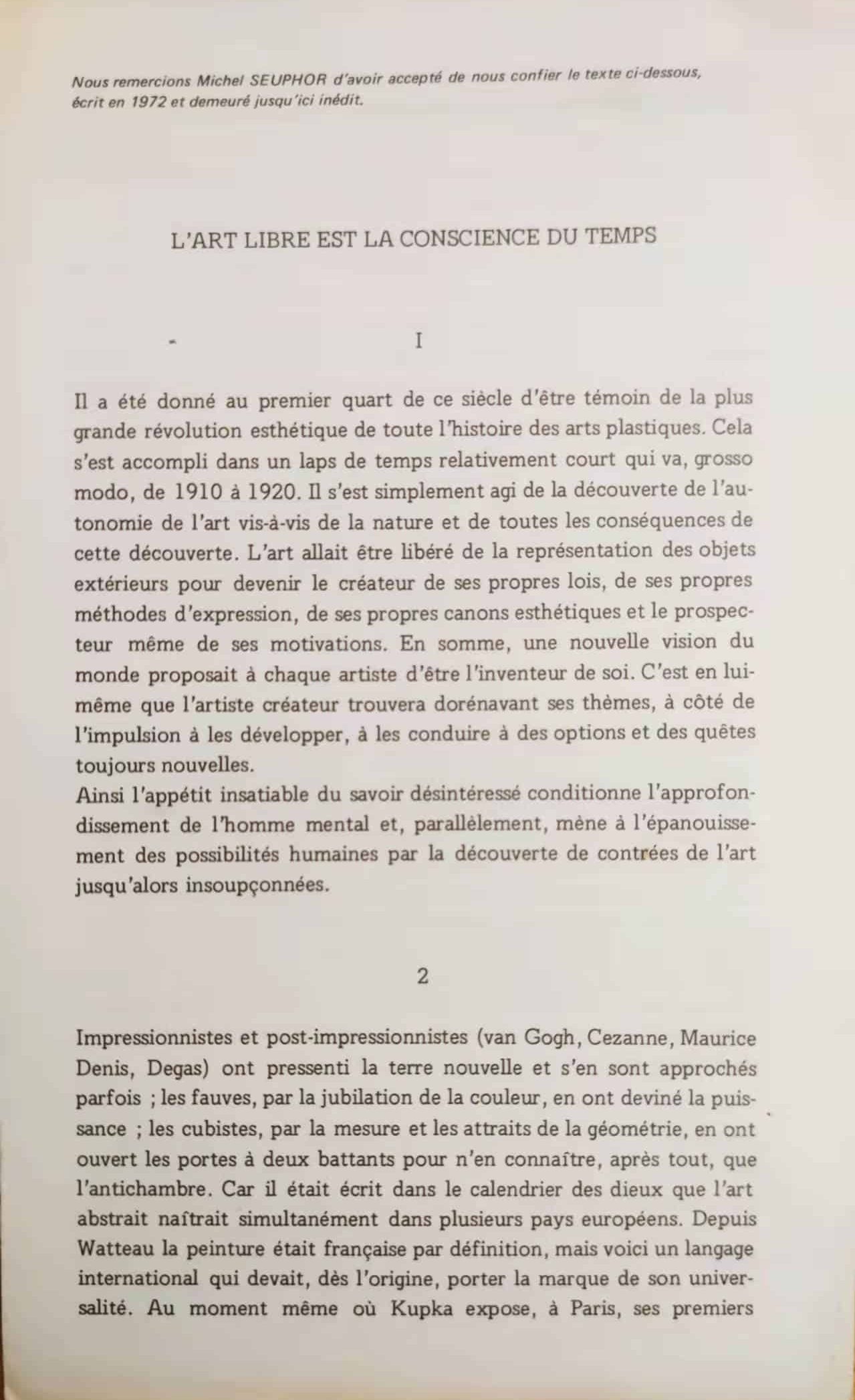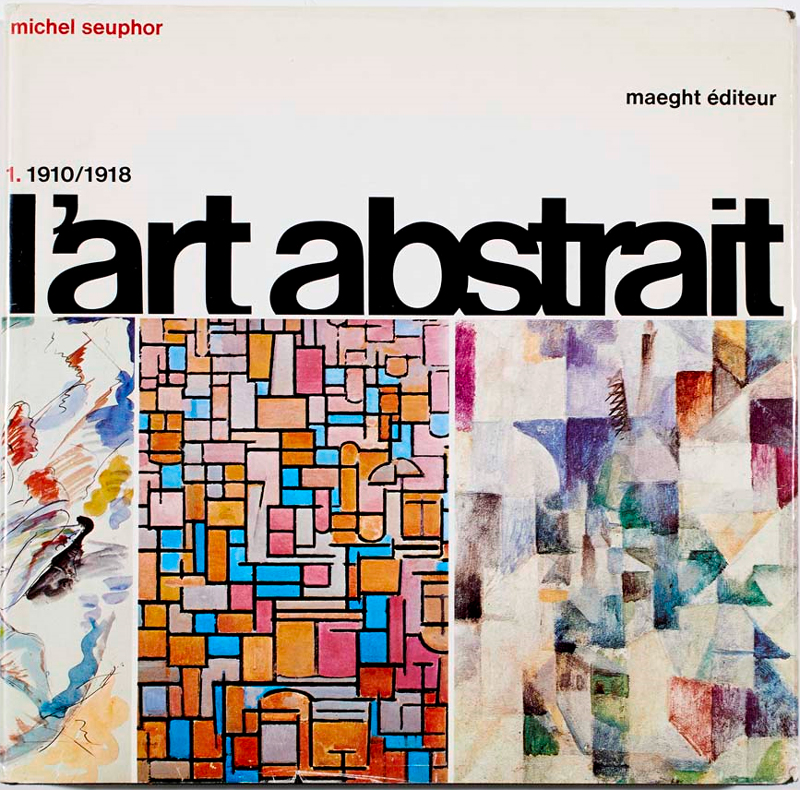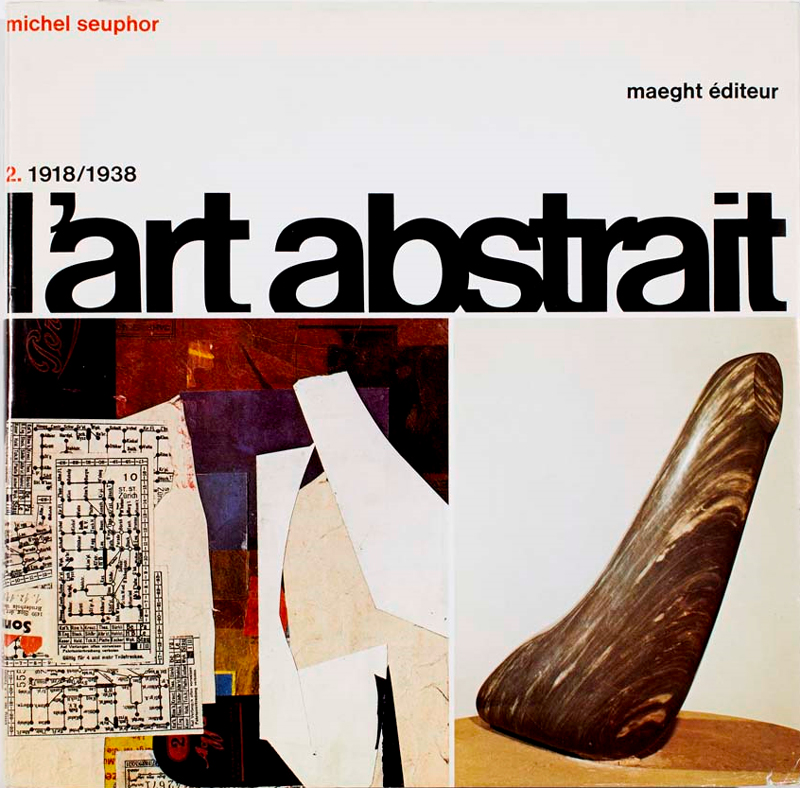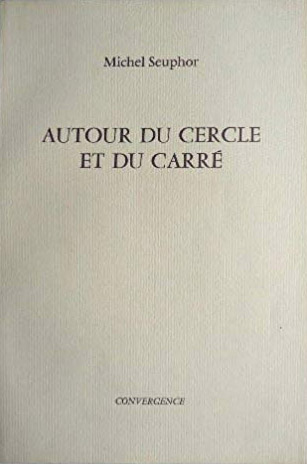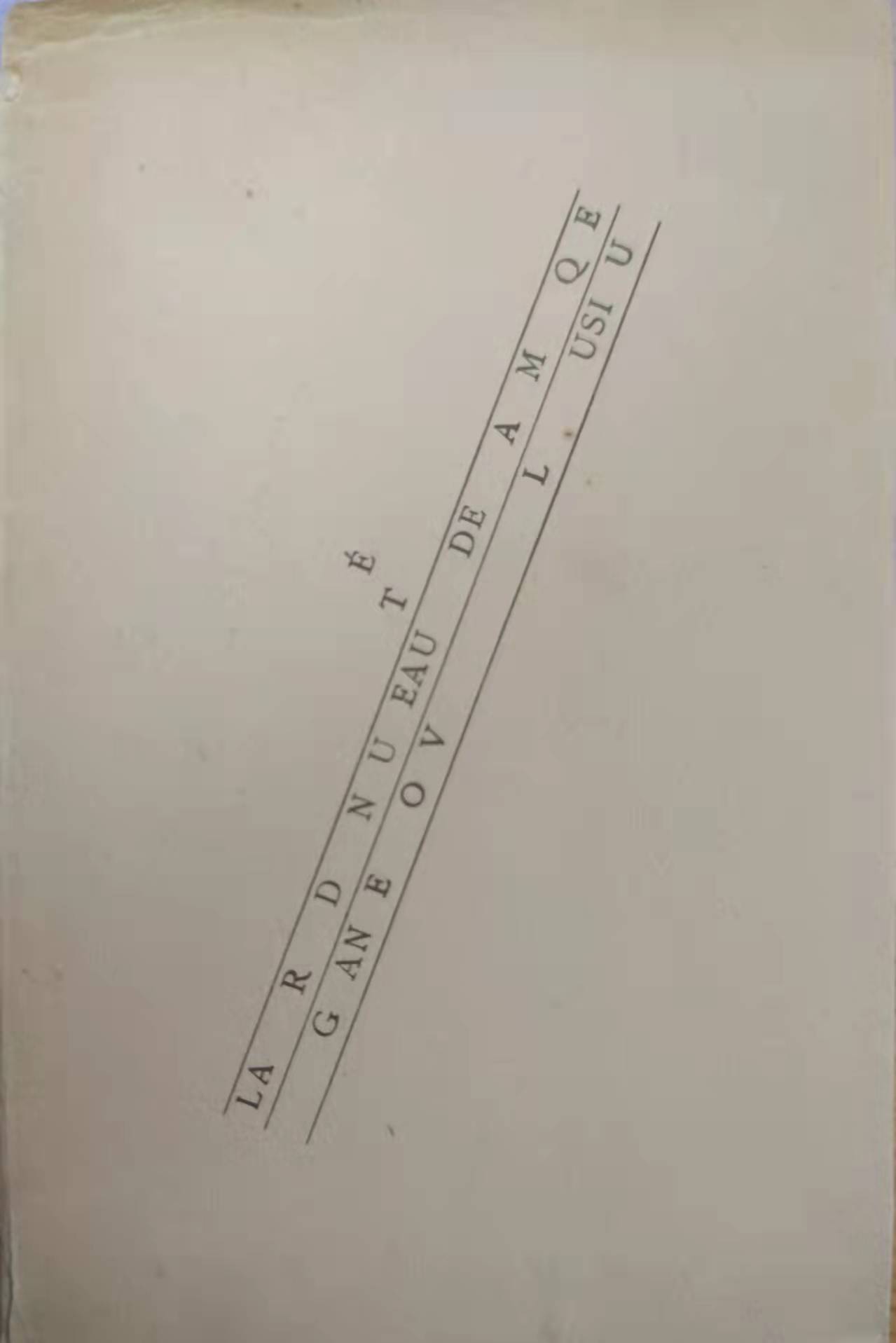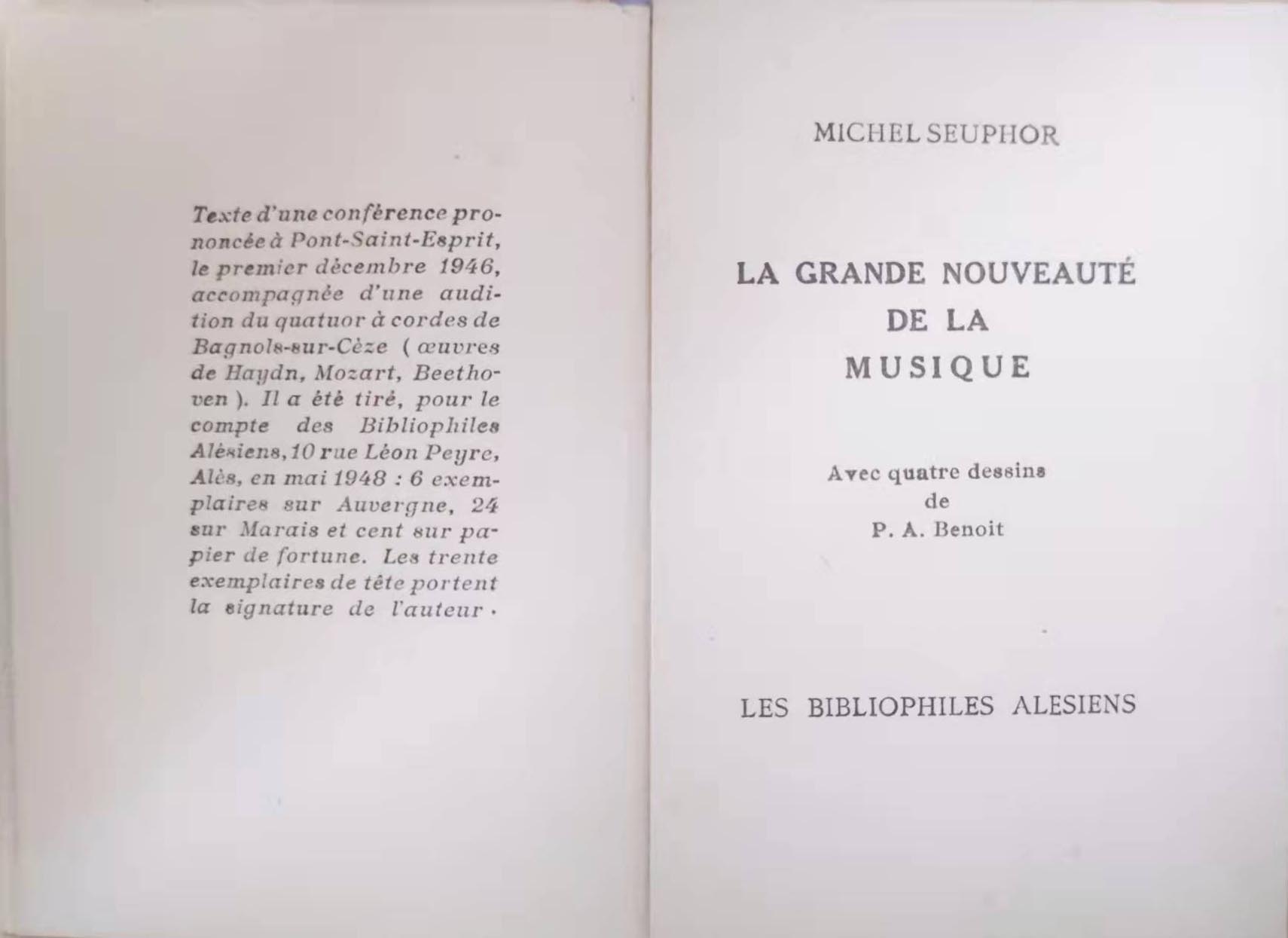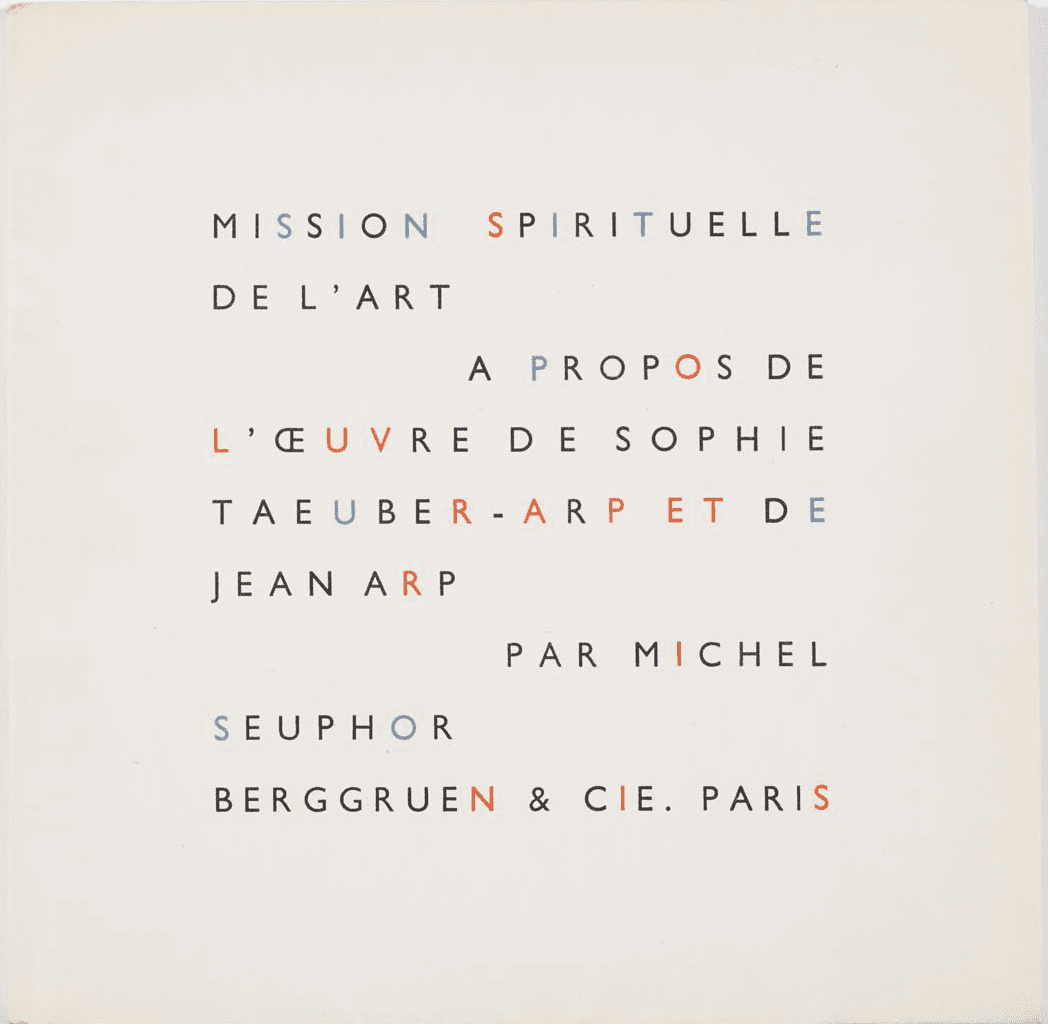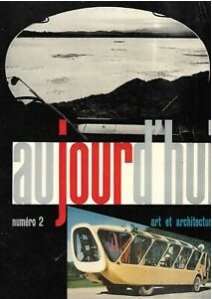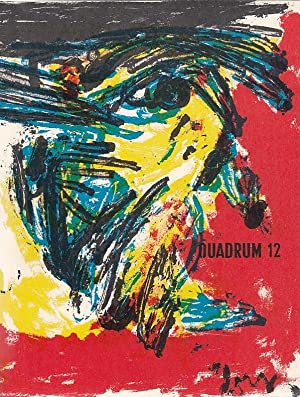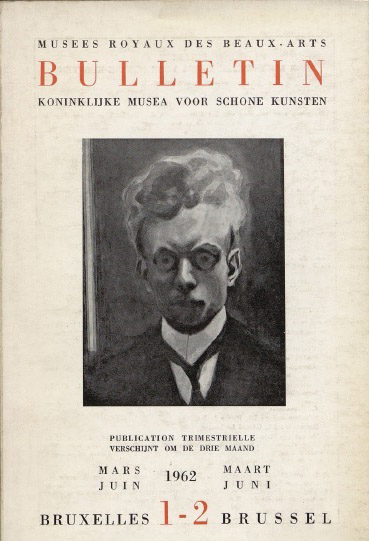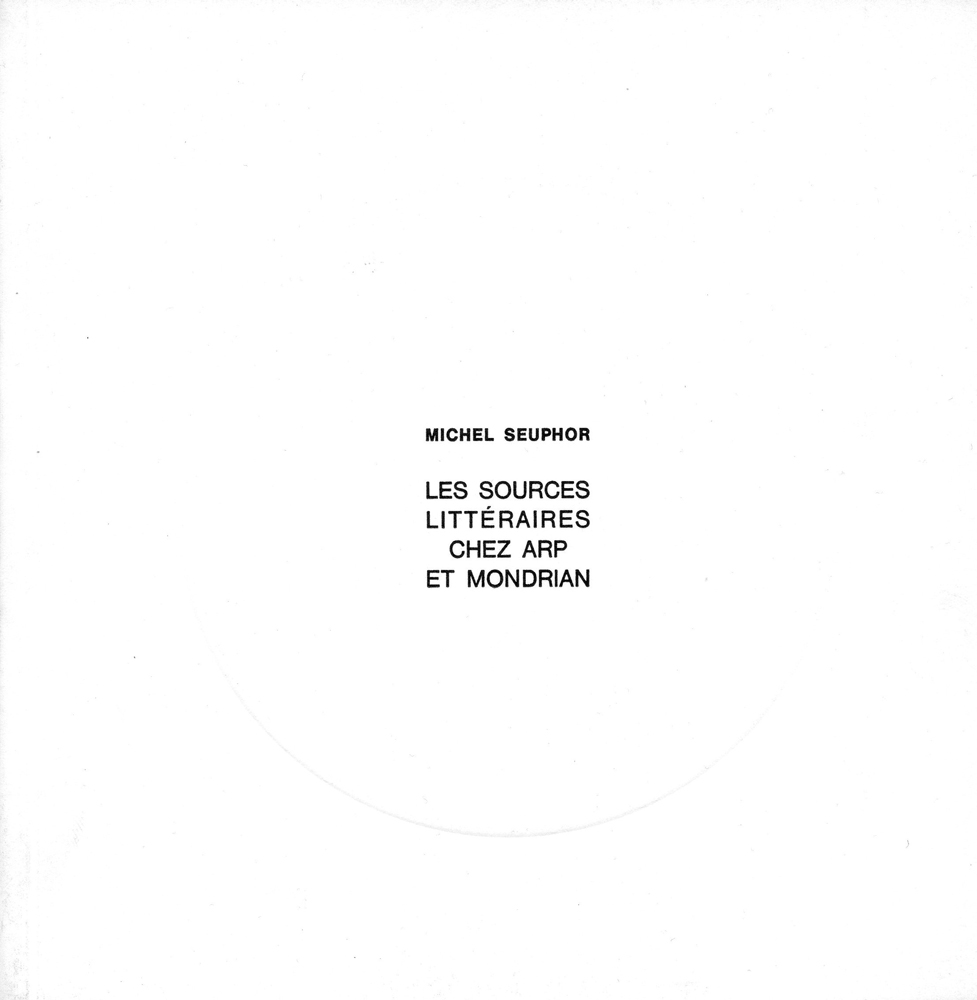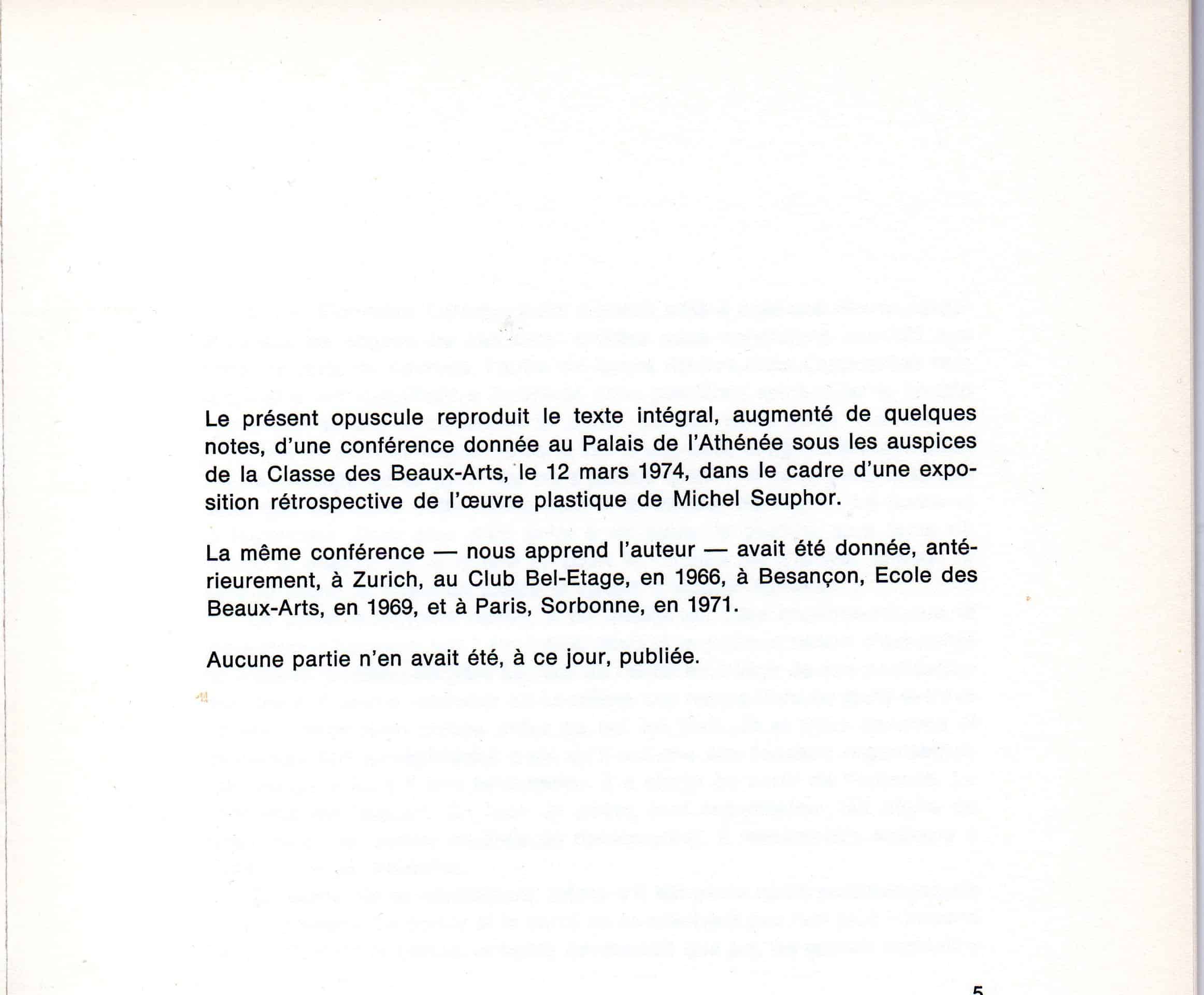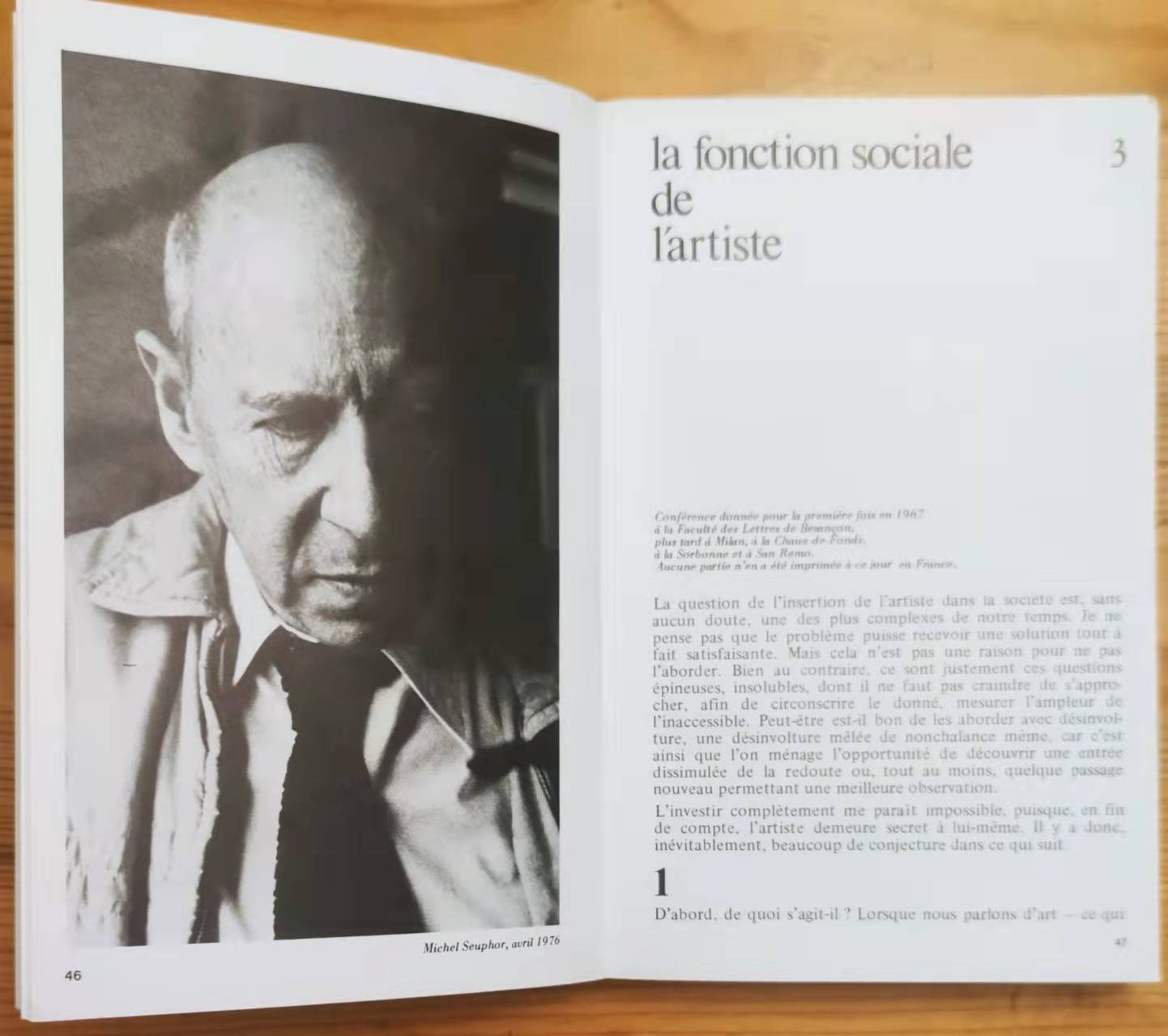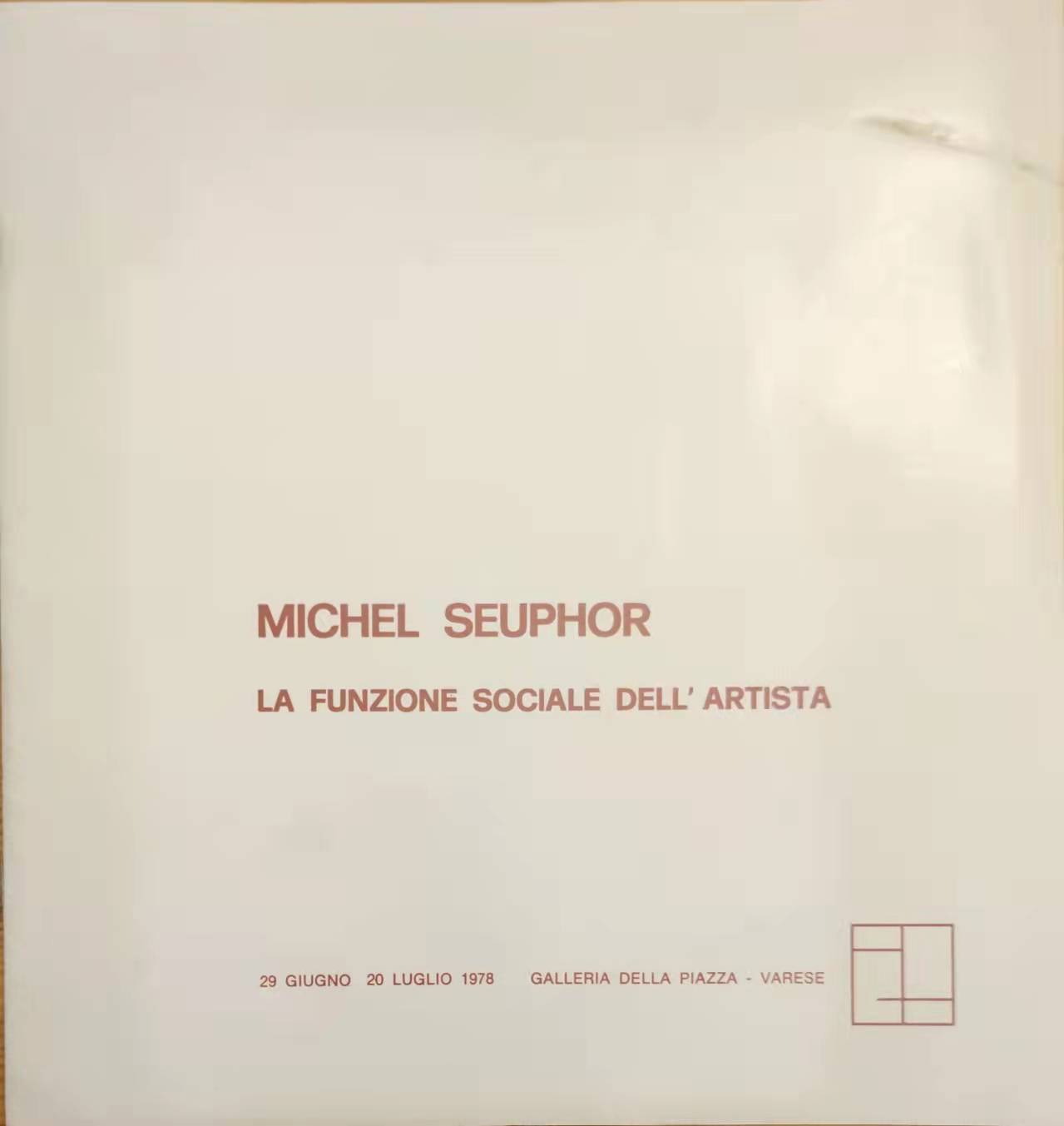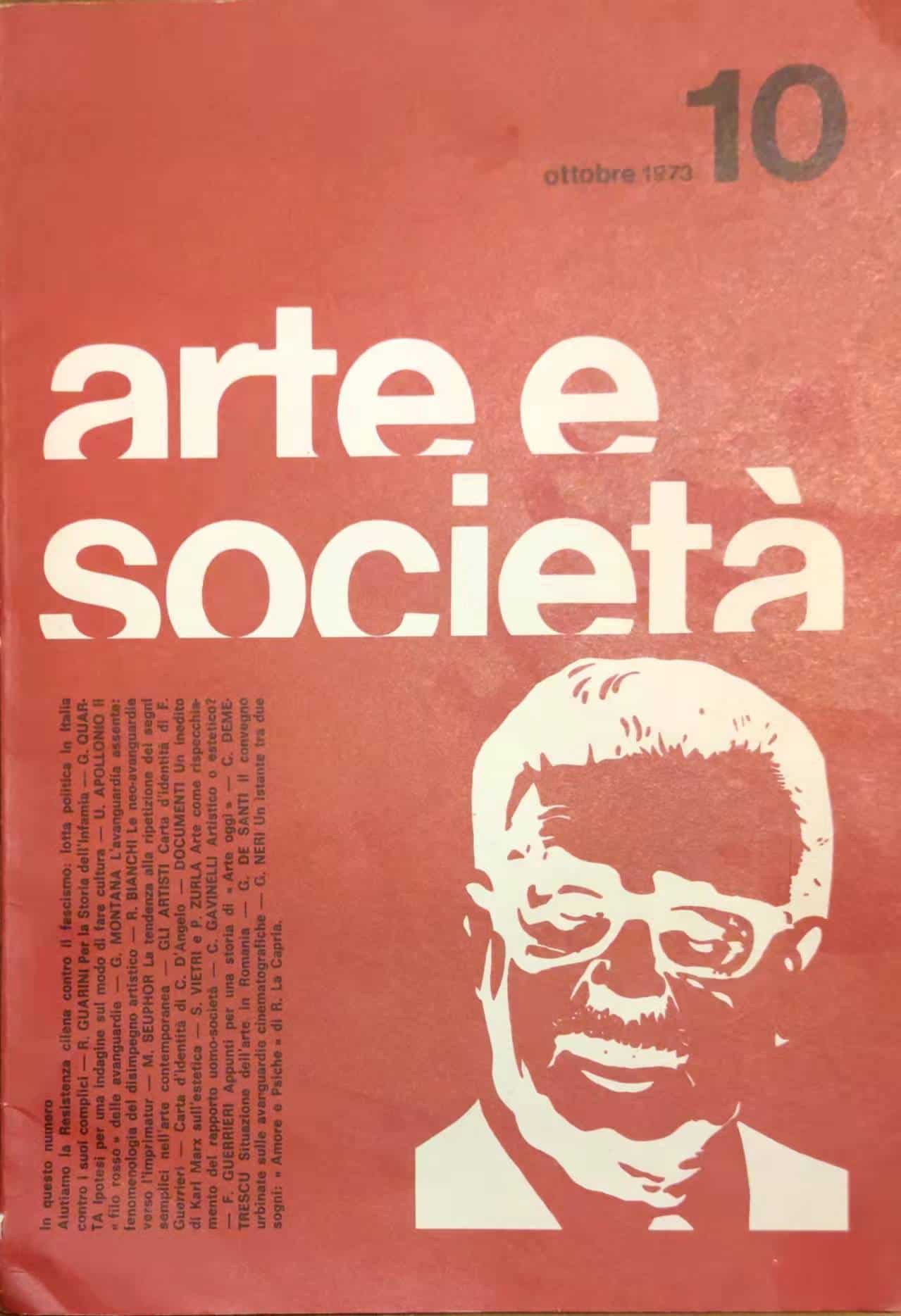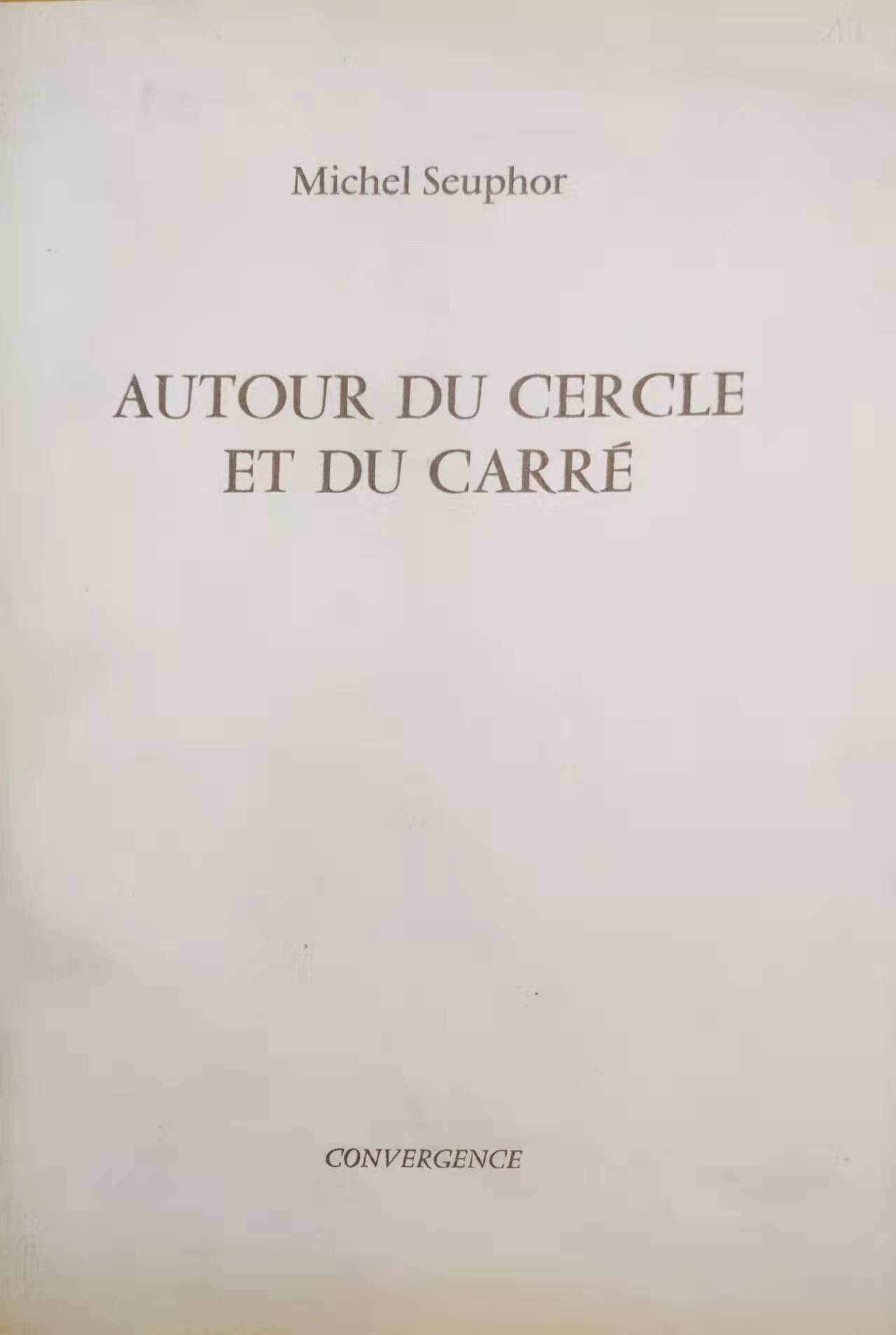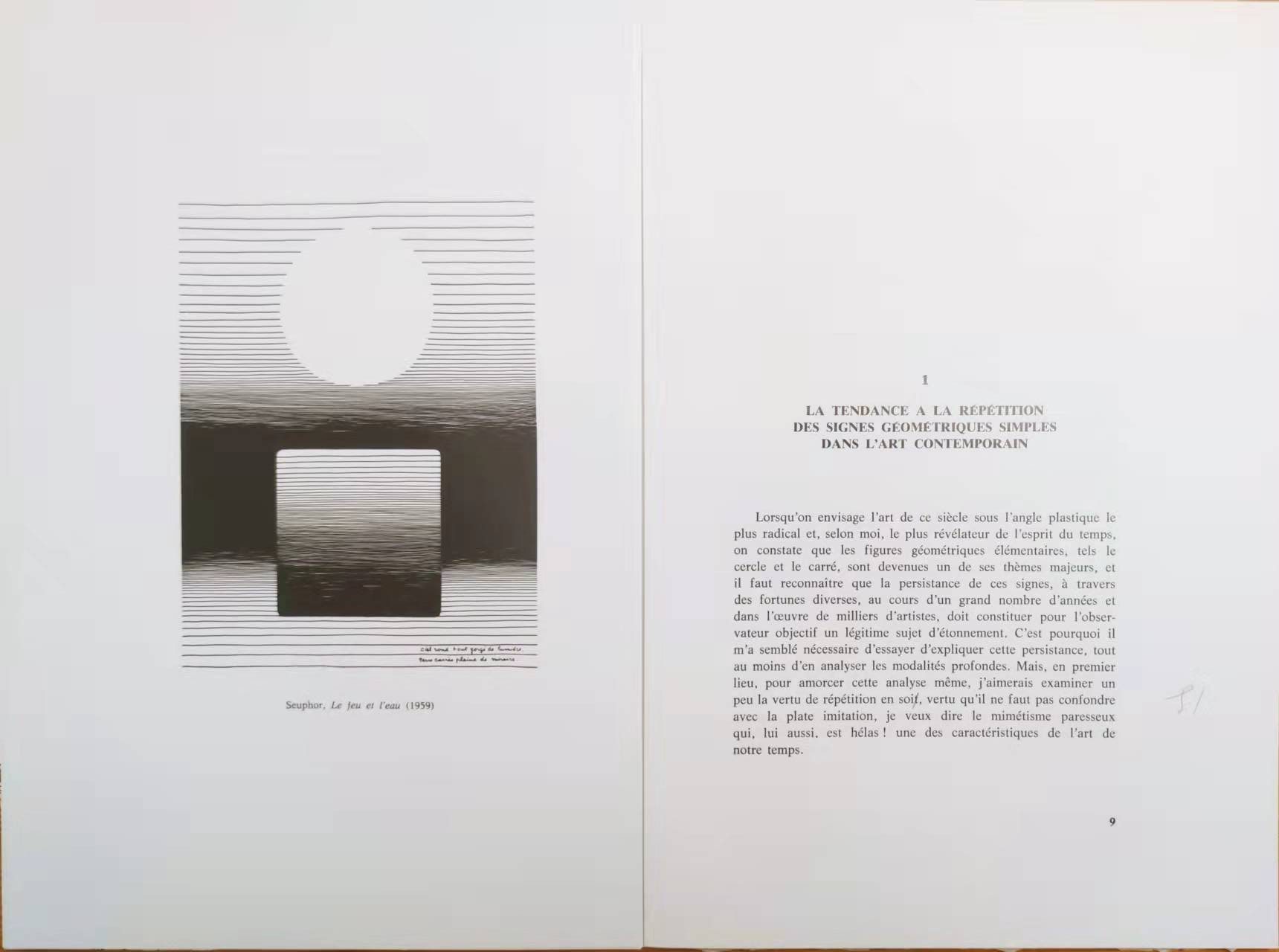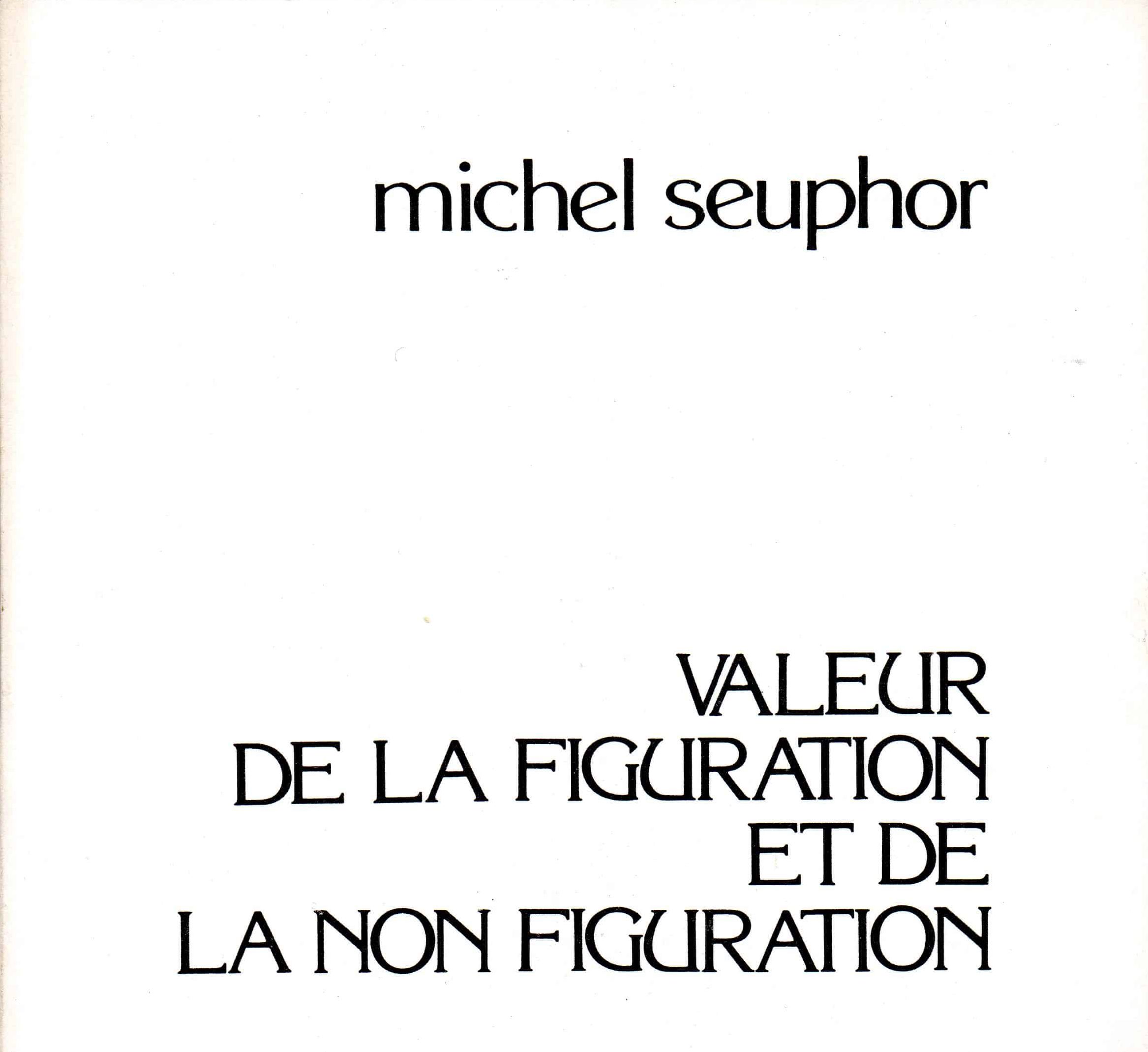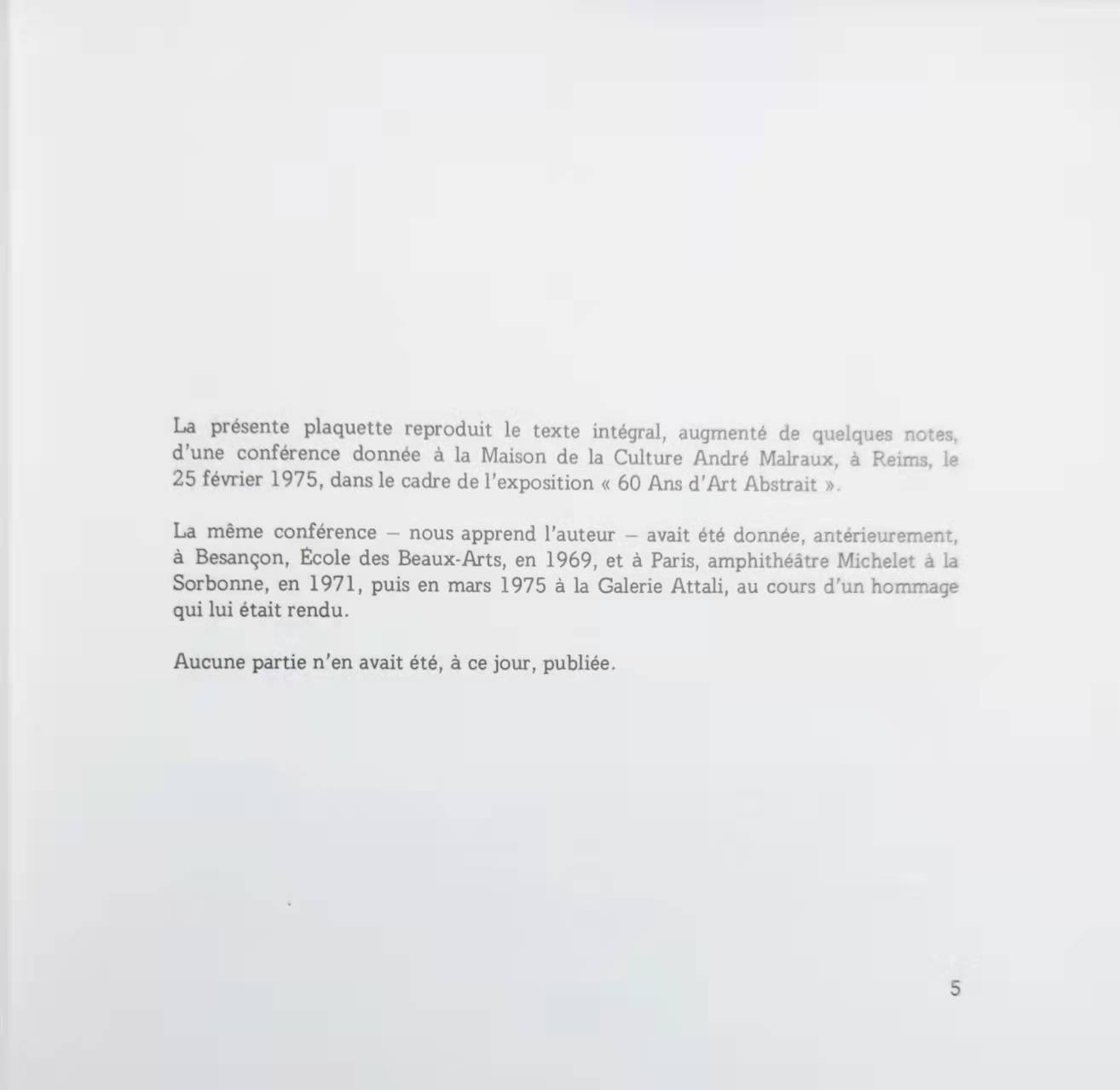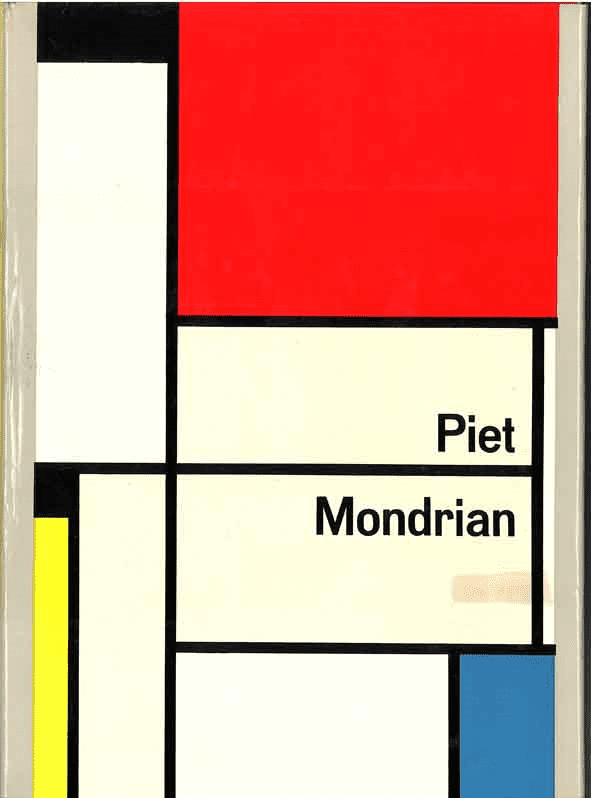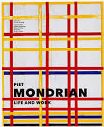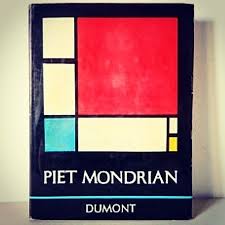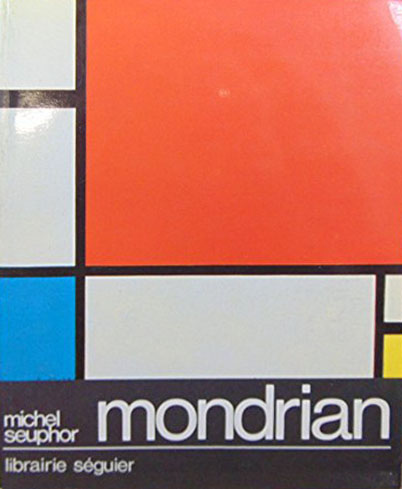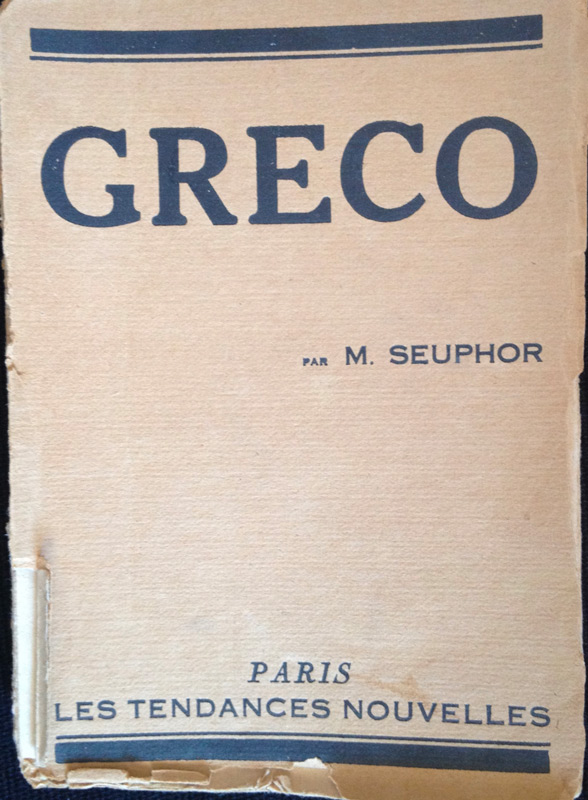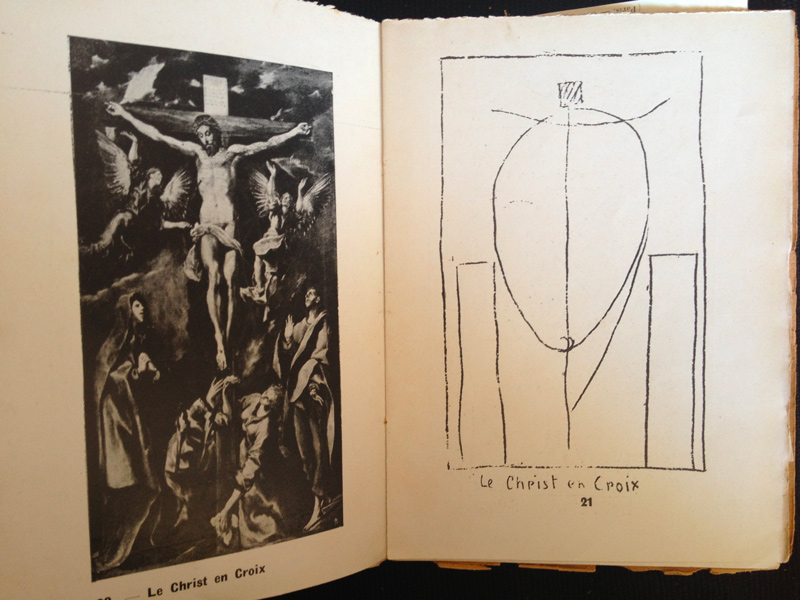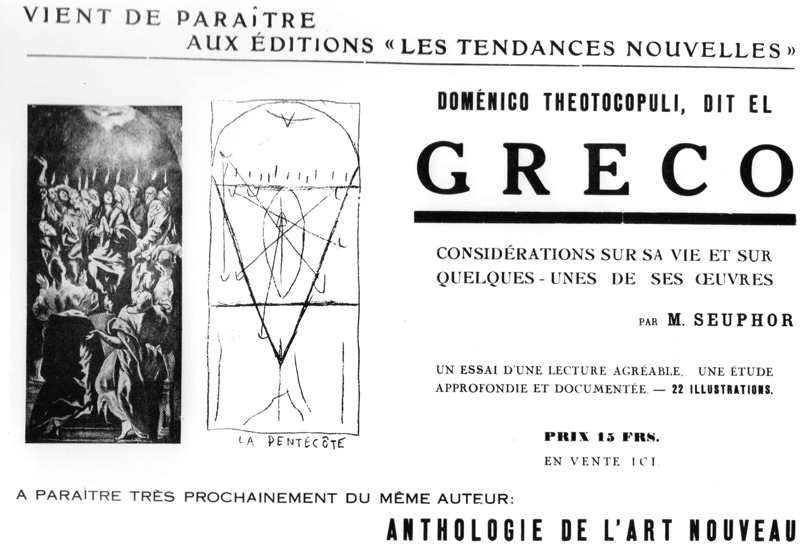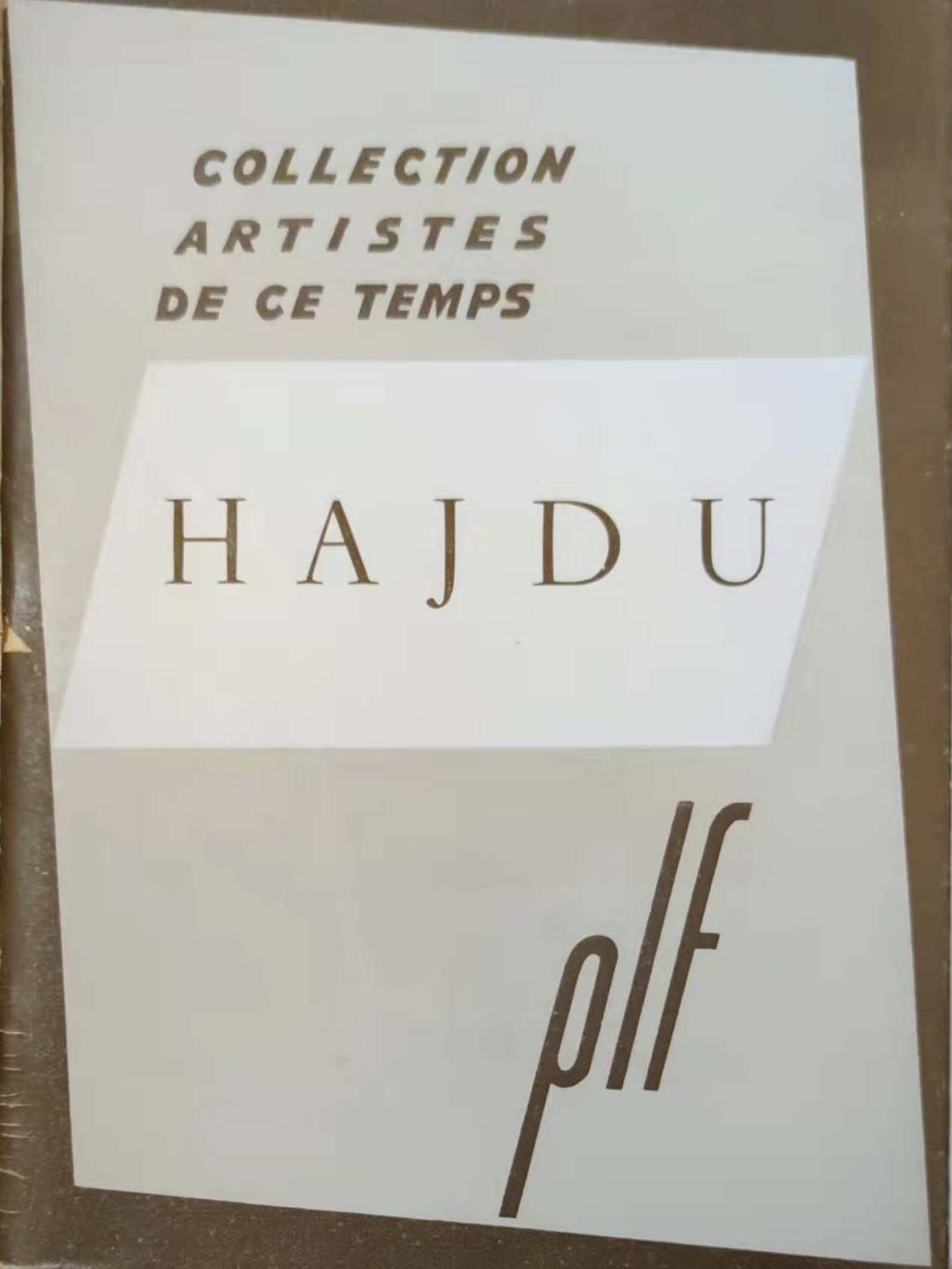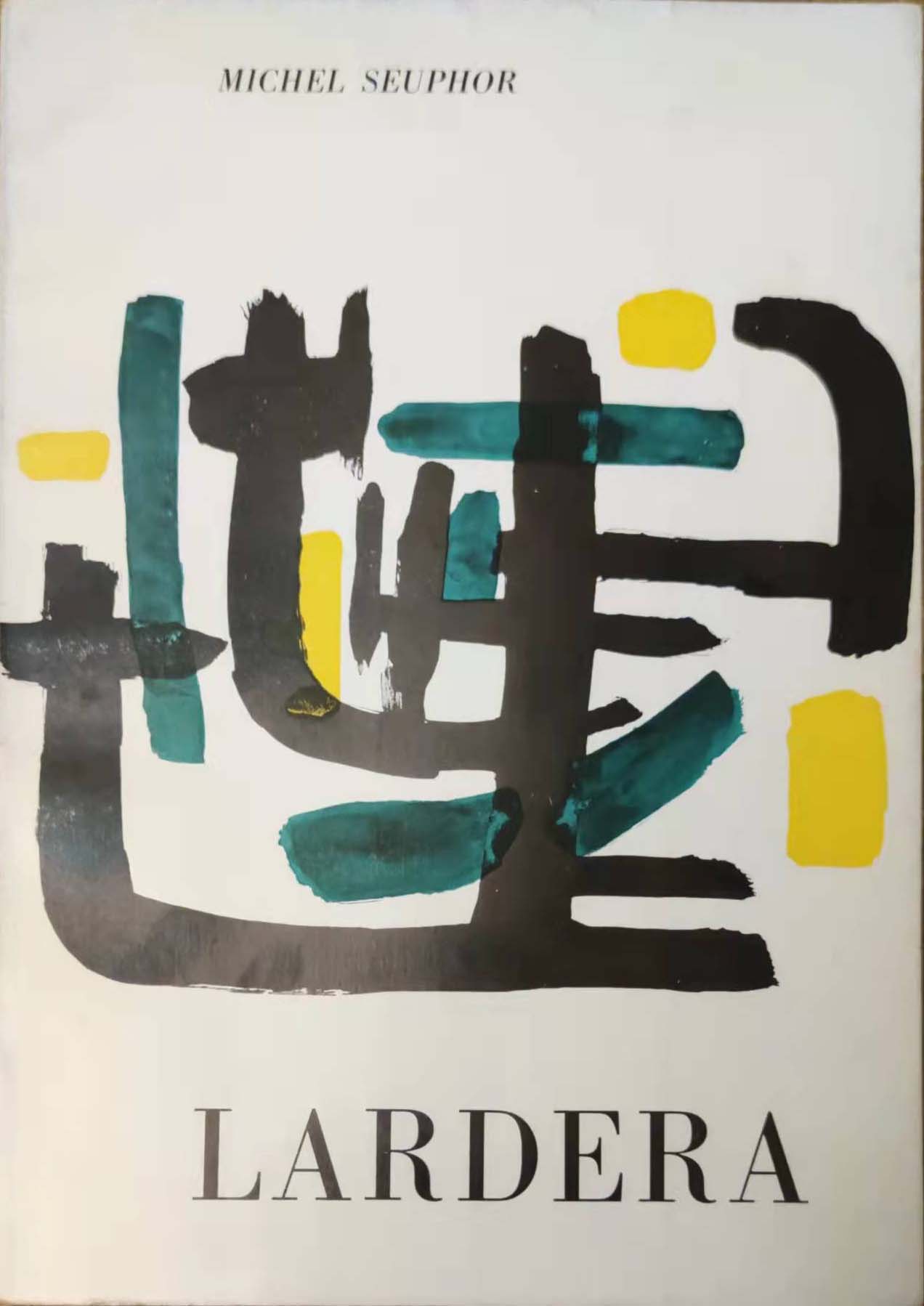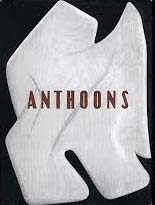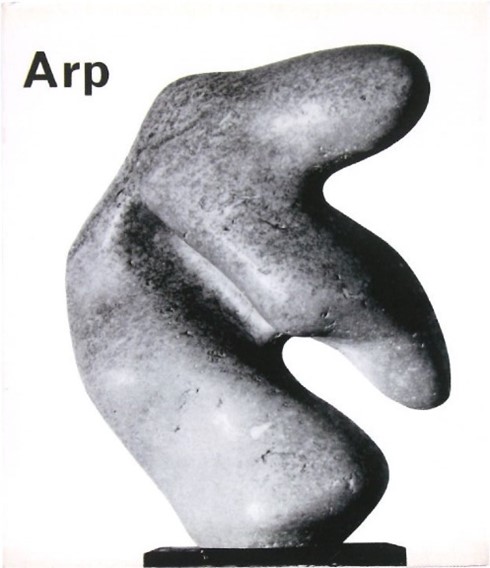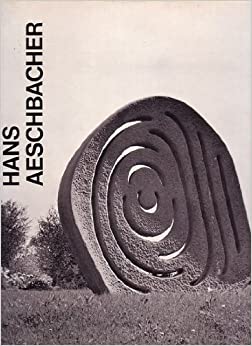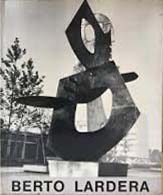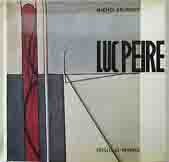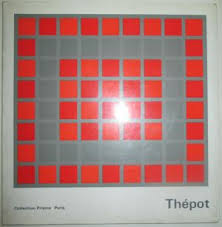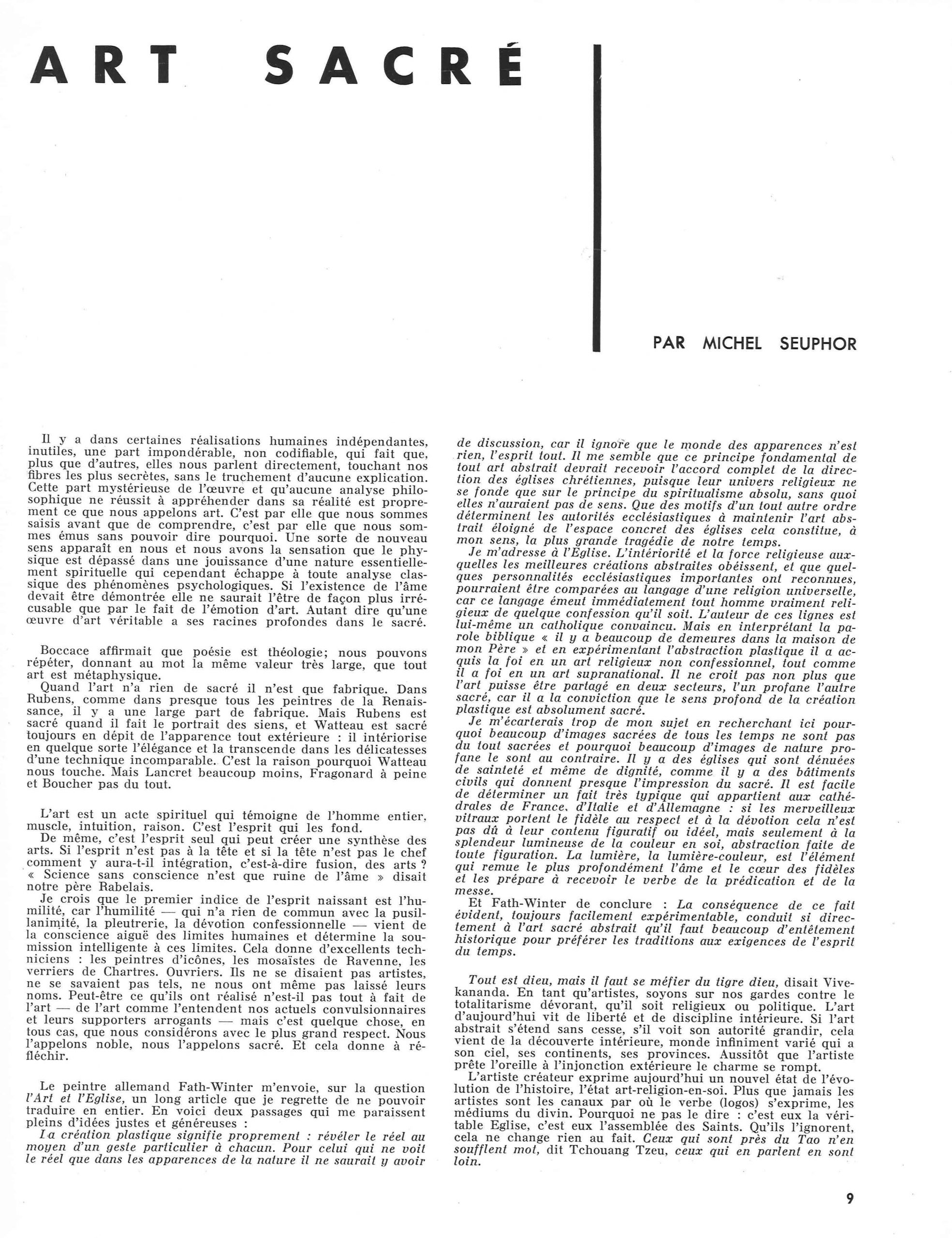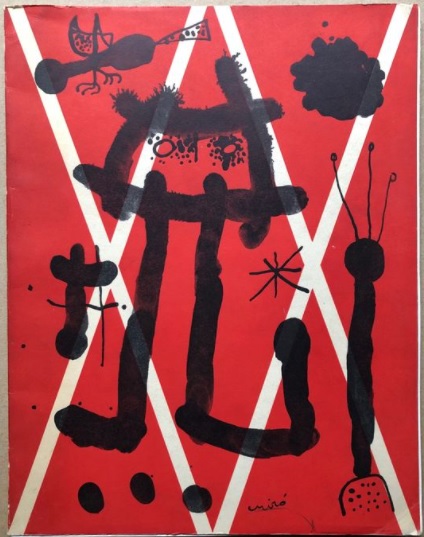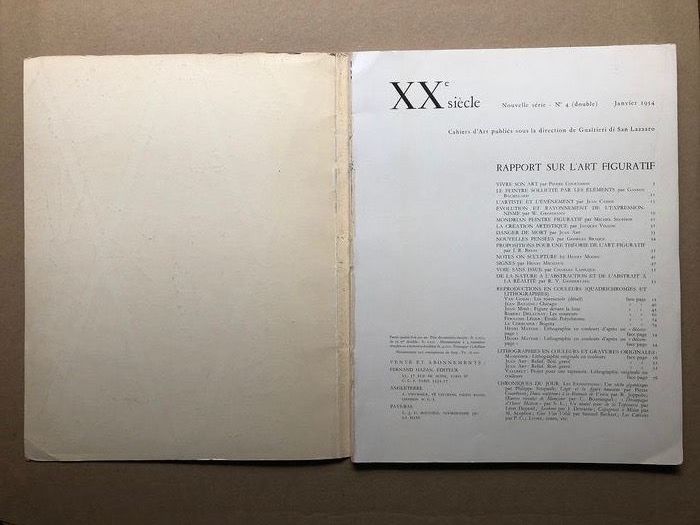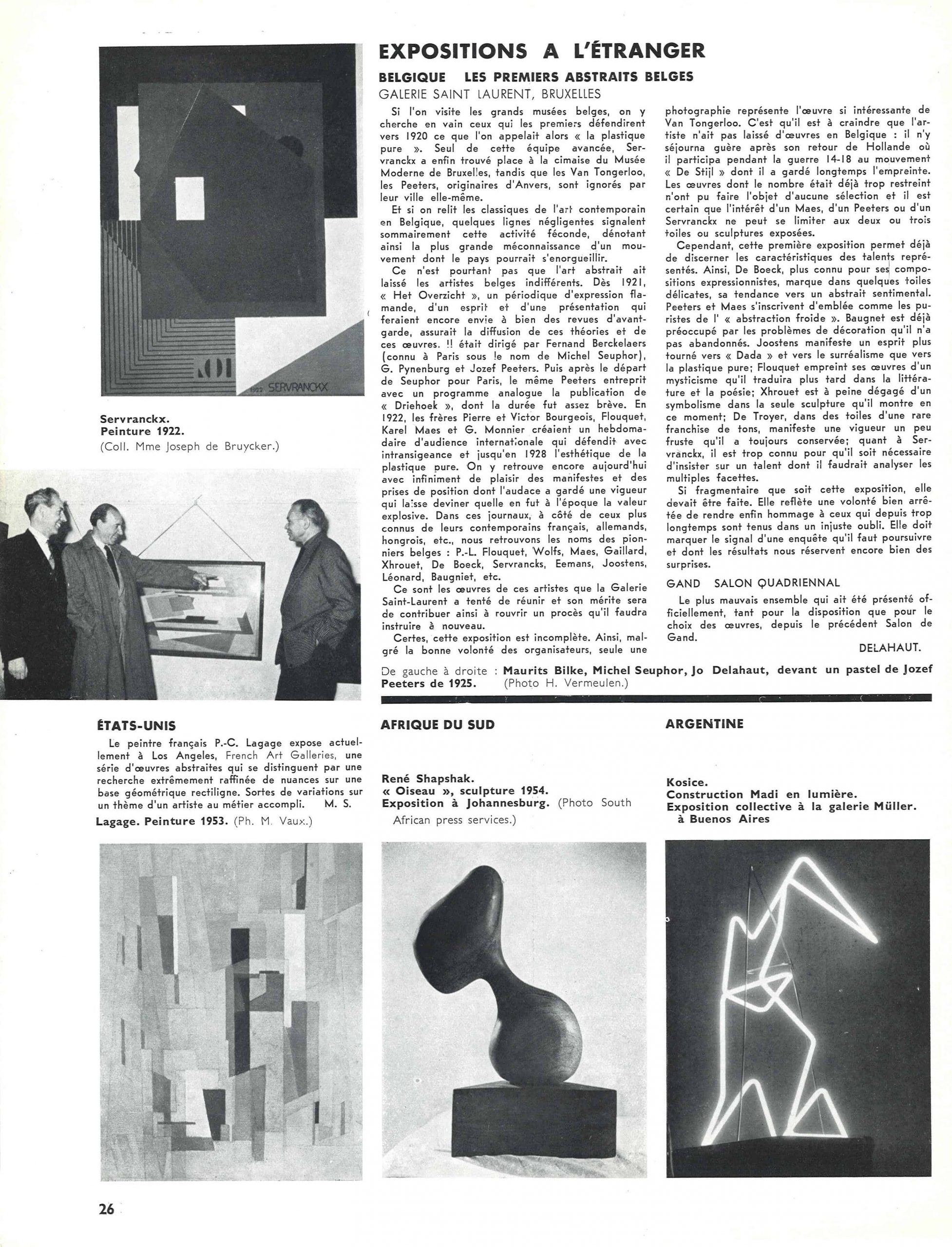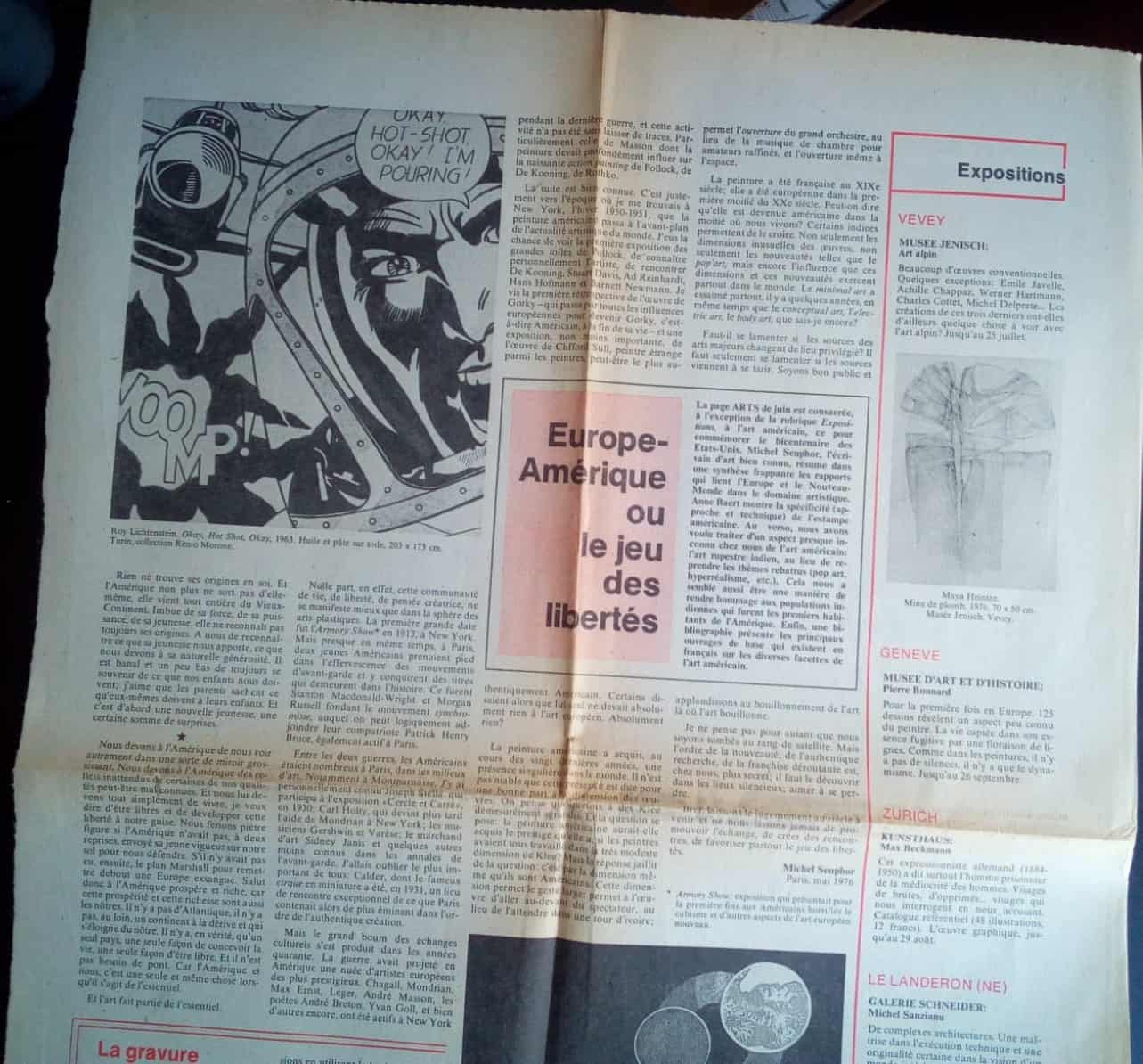BOOKS AND ESSAYS ABOUT ART
BOOKS AND ESSAYS ABOUT ART
« There are times when style alone dominates, others when the cry is very strongly heard. But if there is a movement back and forth from one to the other, it is undoubtedly because there is a secret presence of the cry in style, of style in the cry. »
↑
Michel Seuphor, Le style et le cri. Back cover.
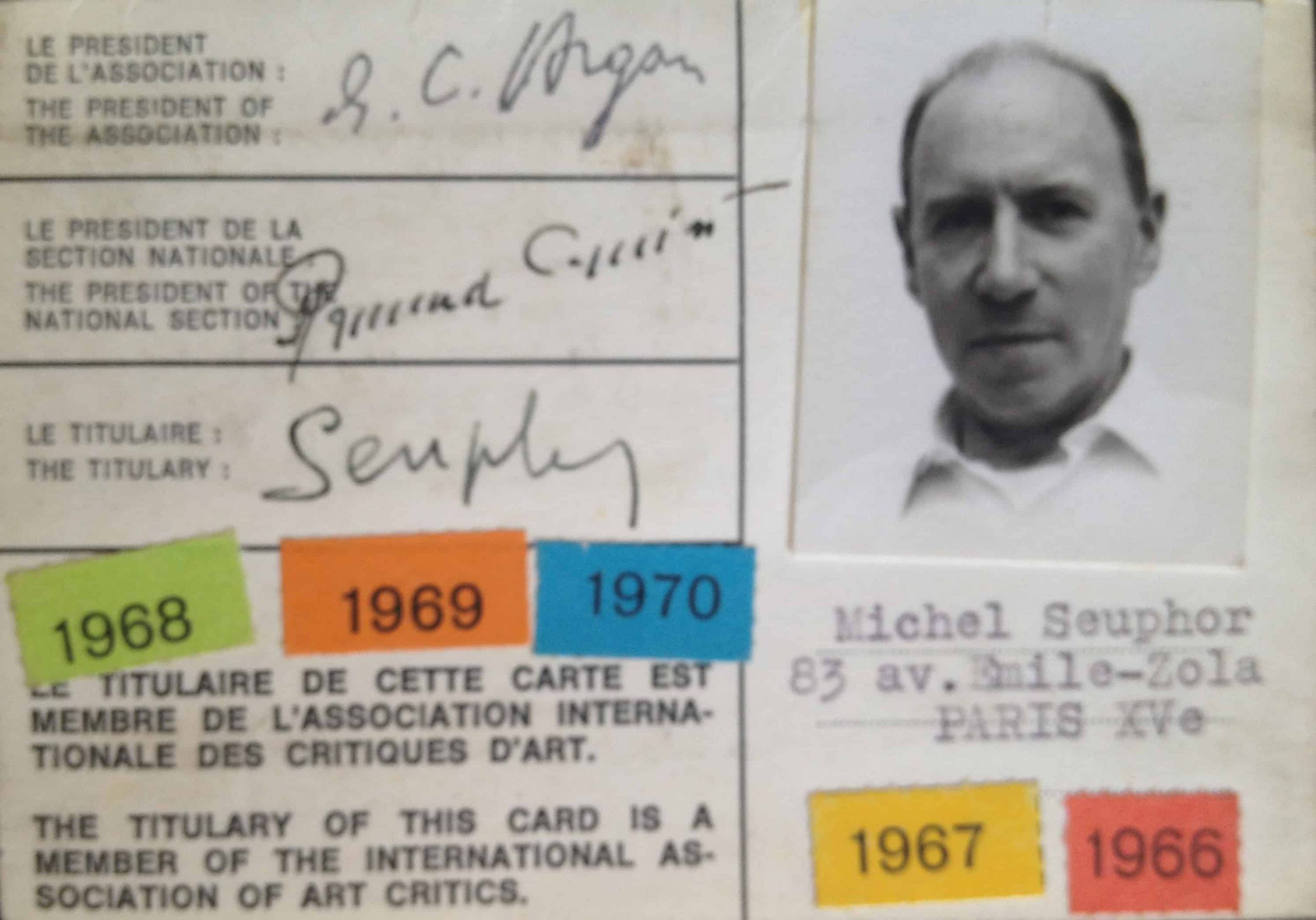
↑
Seuphor’s press card
« There are times when style alone dominates, others when the cry is very strongly heard. But if there is a movement back and forth from one to the other, it is undoubtedly because there is a secret presence of the cry in style, of style in the cry. »
↑
Michel Seuphor, Le style et le cri. Back cover.

↑
Seuphor’s press card
Books and essays about art
UN RENOUVEAU DE LA PEINTURE EN BELGIQUE FLAMANDE
A revival of painting in Flemish Belgium
The genesis of the book as told by Seuphor in Un siècle de libertés (p 181)
« One fine day he [Emil Zitya] told me that he was going to publish, and that he needed me to write, a book on the new art in Belgium, which was to be part of a collection that would also deal with new Art in Romania, etc. I began by refusing, because I was in Paris to forget Belgium. Moreover, the idea of Cercle et Carré was in the air, I saw Torres-Garcia a lot, and I didn’t really want to write a book that I hadn’t thought of myself. But then he announced that he was offering me… three thousand francs! A fortune, I could live for six months on such a sum. How could I refuse? I agreed and put my life in brackets for two months. I went to Belgium. I spent the first month traveling around the country, visiting all the painters’ and sculptors’ studios in Brussels, Antwerp, Ghent, etc. Then I settled in Lissewege, a small village near the coast, and spent the second month sitting at a table, writing. Then I went back to Paris with my manuscript under my arm. When I handed it to Zitya to get the rest of my money, he yelled: “What have you done? This is enough for a three-hundred-page book! What I need is a text for a thirty-two-page introduction, which I will place before the photographic reproductions. Cut your prose and reduce it to thirty-two pages!” Those thirty-two pages took a lot more work than the entire book I had written. It was very bad, the most horrible work I’ve ever done in my life … And it was a commission. The lesson is that you should never be subordinate to anyone. Also, ultimately the work was never published in this “reduced” form because Zitya went bankrupt. It was only two years later that another publisher became interested in the work and published it in its original version. »
Books and essays about art
UN RENOUVEAU DE LA PEINTURE EN BELGIQUE FLAMANDE
A revival of painting in Flemish Belgium
The genesis of the book as told by Seuphor in Un siècle de libertés (p 181)
« One fine day he [Emil Zitya] told me that he was going to publish, and that he needed me to write, a book on the new art in Belgium, which was to be part of a collection that would also deal with new Art in Romania, etc. I began by refusing, because I was in Paris to forget Belgium. Moreover, the idea of Cercle et Carré was in the air, I saw Torres-Garcia a lot, and I didn’t really want to write a book that I hadn’t thought of myself. But then he announced that he was offering me… three thousand francs! A fortune, I could live for six months on such a sum. How could I refuse? I agreed and put my life in brackets for two months. I went to Belgium. I spent the first month traveling around the country, visiting all the painters’ and sculptors’ studios in Brussels, Antwerp, Ghent, etc. Then I settled in Lissewege, a small village near the coast, and spent the second month sitting at a table, writing. Then I went back to Paris with my manuscript under my arm. When I handed it to Zitya to get the rest of my money, he yelled: “What have you done? This is enough for a three-hundred-page book! What I need is a text for a thirty-two-page introduction, which I will place before the photographic reproductions. Cut your prose and reduce it to thirty-two pages!” Those thirty-two pages took a lot more work than the entire book I had written. It was very bad, the most horrible work I’ve ever done in my life … And it was a commission. The lesson is that you should never be subordinate to anyone. Also, ultimately the work was never published in this “reduced” form because Zitya went bankrupt. It was only two years later that another publisher became interested in the work and published it in its original version. »
L’ART ABSTRAIT, SES ORIGINES, SES PREMIERS MAÎTRES
Abstract art, its origins, its first masters
Excerpts – Seuphor in Un siècle de liberté, p 257
« One evening, on the Boulevard Saint-Germain, we met Maeght with Seligman and Bazaine; “Oh Seuphor! Come, I invite you to have a drink at the Rhumerie Martiniquaise. » We sat down on the elevated terrace and Maeght said to me, « All that is said about the origins of abstract art is absurd. The newspapers are full of nonsense, we don’t know what happened, you do. You are going to write a book on the history of abstract art as you know it, as you have experienced it. I give you carte blanche, you can write whatever you want. Total freedom…. I’ll give you three minutes to think and three months to do it. » I didn’t let the three minutes pass. I said, « Okay ». All my stuff was in boxes at a storage facility. So, I had neither my documentation nor my essential books… I only had my memory, with which I wrote Abstract Art, its origins, and its first masters, helped also by some works lent to me by Larionov and Nina Kandinsky.
… there was nothing on the subject, except, as Maeght had said, articles and studies that mixed everything. I did the layout of the book myself on the little bed we had on Rue des Beaux-Arts, and with that I went to the Union printing house. There, I worked for at least three months as a laborer, so much so that one day Mr. Pascal, the foreman of the printing house, said to me: « Sir, this morning you were late, you were not there at nine o’clock! » Seeing my astonishment, he added: « You are an employee of the Maeght gallery, and the employees of Maeght, like my workers, must arrive on time! » Anyway, the book came out on time, with a cover drawn by Arp.
…The edition was sold out immediately. A second one was made, on thinner paper so that it would cost less, and it was dated 1950, while it was still 1949. And I even got some royalties. Not much. »
L’ART ABSTRAIT, SES ORIGINES, SES PREMIERS MAÎTRES
Abstract art, its origins, its first masters
Excerpts – Seuphor in Un siècle de liberté, p 257
« One evening, on the Boulevard Saint-Germain, we met Maeght with Seligman and Bazaine; “Oh Seuphor! Come, I invite you to have a drink at the Rhumerie Martiniquaise. » We sat down on the elevated terrace and Maeght said to me, « All that is said about the origins of abstract art is absurd. The newspapers are full of nonsense, we don’t know what happened, you do. You are going to write a book on the history of abstract art as you know it, as you have experienced it. I give you carte blanche, you can write whatever you want. Total freedom…. I’ll give you three minutes to think and three months to do it. » I didn’t let the three minutes pass. I said, « Okay ». All my stuff was in boxes at a storage facility. So, I had neither my documentation nor my essential books… I only had my memory, with which I wrote Abstract Art, its origins, and its first masters, helped also by some works lent to me by Larionov and Nina Kandinsky.
… there was nothing on the subject, except, as Maeght had said, articles and studies that mixed everything. I did the layout of the book myself on the little bed we had on Rue des Beaux-Arts, and with that I went to the Union printing house. There, I worked for at least three months as a laborer, so much so that one day Mr. Pascal, the foreman of the printing house, said to me: « Sir, this morning you were late, you were not there at nine o’clock! » Seeing my astonishment, he added: « You are an employee of the Maeght gallery, and the employees of Maeght, like my workers, must arrive on time! » Anyway, the book came out on time, with a cover drawn by Arp.
…The edition was sold out immediately. A second one was made, on thinner paper so that it would cost less, and it was dated 1950, while it was still 1949. And I even got some royalties. Not much. »
↑
Dictionnaire de la peinture abstraite.
éditions Hazan, Paris 1957. Traduit et publié en anglais sous le titre Dictionary of abstract painting, éditions Tudor Publishing Company, New York, 1957
Translated and published in English under the title Dictionary of abstract painting, Tudor Publishing Company, New York, 1957
DICTIONNAIRE DE LA PEINTURE ABSTRAITE
Dictionary of abstract painting
Genesis of the work told by Seuphor in Un siècle de liberté (p 133)
« I had met the director of the Hyperion publishing house – now closed – whose specialty was publications on art. This rather nervous man desperately wanted to make a dictionary with me, the first on abstract art. A sensational book, he said, exhaustive, unsurpassable! I thought it was an excellent idea, and we met almost every day to discuss it. He gave me instructions that I understood more or less well, he was in fact very disordered in his ideas, but very voluntary, so I started to write. But a few months later, he got sick and died. What I had done for him was there in bulk, useless. Sometime later, I was asked to collaborate on a dictionary on modern painting being prepared by Fernand Hazan. Very naturally, my work for a dictionary on abstract art allowed me to start the second dictionary, this one entirely devoted to abstraction.
… I didn’t really look for many sources, because I had been interested in abstraction since its beginnings and, as a great reader of magazines and somewhat confidential works, I knew all the movements and the initiators of this painting. It is, moreover, a very formative exercise for the eye and the mind. Combined with my travels to New York in the same circles, my knowledge of many people like Dorothée Miller, the secretary of Alfred Barr, curator of the MoMA, and of Sidney Janis, meant that at the end of the fifties I had a good overview – and a great deal of documentation – on abstract art. The rest was a matter of choice, sorting and objectivity within … subjectivity. I talked about Pollock, whom naturally I treated with the importance he has, although my views of him are different from that of most observers. I talked about many painters, many of whom, I believe, have been forgotten. So, when you flip through this book today, there are things that may seem odd, but as far as the essentials are concerned, I don’t think anything is missing.»
DICTIONNAIRE DE LA PEINTURE ABSTRAITE
Dictionary of abstract painting
Genesis of the work told by Seuphor in Un siècle de liberté (p 133)
« I had met the director of the Hyperion publishing house – now closed – whose specialty was publications on art. This rather nervous man desperately wanted to make a dictionary with me, the first on abstract art. A sensational book, he said, exhaustive, unsurpassable! I thought it was an excellent idea, and we met almost every day to discuss it. He gave me instructions that I understood more or less well, he was in fact very disordered in his ideas, but very voluntary, so I started to write. But a few months later, he got sick and died. What I had done for him was there in bulk, useless. Sometime later, I was asked to collaborate on a dictionary on modern painting being prepared by Fernand Hazan. Very naturally, my work for a dictionary on abstract art allowed me to start the second dictionary, this one entirely devoted to abstraction.
… I didn’t really look for many sources, because I had been interested in abstraction since its beginnings and, as a great reader of magazines and somewhat confidential works, I knew all the movements and the initiators of this painting. It is, moreover, a very formative exercise for the eye and the mind. Combined with my travels to New York in the same circles, my knowledge of many people like Dorothée Miller, the secretary of Alfred Barr, curator of the MoMA, and of Sidney Janis, meant that at the end of the fifties I had a good overview – and a great deal of documentation – on abstract art. The rest was a matter of choice, sorting and objectivity within … subjectivity. I talked about Pollock, whom naturally I treated with the importance he has, although my views of him are different from that of most observers. I talked about many painters, many of whom, I believe, have been forgotten. So, when you flip through this book today, there are things that may seem odd, but as far as the essentials are concerned, I don’t think anything is missing.»
↑
Dictionnaire de la peinture abstraite.
éditions Hazan, Paris 1957. Traduit et publié en anglais sous le titre Dictionary of abstract painting, éditions Tudor Publishing Company, New York, 1957
Translated and published in English under the title Dictionary of abstract painting, Tudor Publishing Company, New York, 1957
LA SCULPTURE DE CE SIÈCLE
THE SCULPTURE OF THIS CENTURY
Dictionary of modern sculpture
Introduction in the book Jacket.
« Since the beginning of the century, all the interest, all the infatuation of the public and of art lovers has focused on painting. It is hardly if, on the eve of the last war, one could have named three or four great sculptors whose names were known worldwide. Until five or six years ago, sculpture was considered as the poor child of the art of our time. What miracle has taken place to bring it out of obscurity? The outlook has changed, almost suddenly, in the whole world. Great open-air exhibitions have greatly contributed to this exposure, to this better understanding. At the same time, the number of sculptors is increasing rapidly, the disciplines are becoming richer and more diverse every day. Today’s sculpture is considered everywhere as a great art of the future. The need was thus felt for a book dealing with the sculpture of this century as a whole. Here it is. After a parallel with current painting, which was necessary, one will find a historical account of sculpture, extending from Rodin to the latest developments in the main countries of the world. The problem of the relief is then addressed, as well as that of the relationship between sculpture and architecture. Finally, a biographical dictionary of 432 sculptors completes the work. The book is illustrated with 411 carefully chosen pictures. A sum on sculpture? In any case, a sum of information unequalled to date on the sculpture of this century.
LA SCULPTURE DE CE SIÈCLE
THE SCULPTURE OF THIS CENTURY
Dictionary of modern sculpture
Introduction in the book Jacket.
« Since the beginning of the century, all the interest, all the infatuation of the public and of art lovers has focused on painting. It is hardly if, on the eve of the last war, one could have named three or four great sculptors whose names were known worldwide. Until five or six years ago, sculpture was considered as the poor child of the art of our time. What miracle has taken place to bring it out of obscurity? The outlook has changed, almost suddenly, in the whole world. Great open-air exhibitions have greatly contributed to this exposure, to this better understanding. At the same time, the number of sculptors is increasing rapidly, the disciplines are becoming richer and more diverse every day. Today’s sculpture is considered everywhere as a great art of the future. The need was thus felt for a book dealing with the sculpture of this century as a whole. Here it is. After a parallel with current painting, which was necessary, one will find a historical account of sculpture, extending from Rodin to the latest developments in the main countries of the world. The problem of the relief is then addressed, as well as that of the relationship between sculpture and architecture. Finally, a biographical dictionary of 432 sculptors completes the work. The book is illustrated with 411 carefully chosen pictures. A sum on sculpture? In any case, a sum of information unequalled to date on the sculpture of this century.
The idea of Construction
Extract
« There is no more specifically human task than to build. Everything that is is constructed, from the atom to the flower, from the Chinese ideogram to the cathedral, from the prehistoric tool to a Mozart quartet. To be sure, the passive acquiescence in the established order calls forth the reaction of man’s vital forces that seek a beyond that is ever new. But there is no more urgent battle today than the about-face needed to push back the disintegration that is everywhere gaining ground.
There will always be lies to demolish, diseases to cure by cutting into the living flesh, faults to denounce, hatreds to overcome in ourselves. There will always be the destructive spirit to destroy in ourselves. But it is still by constructing that man destroys best and most surely. This was what the cubist painters did: by building the painting, in spite of the subject, they destroyed the latter and gave pure form the possibility of coming into being. »
The idea of Construction
Extract
« There is no more specifically human task than to build. Everything that is is constructed, from the atom to the flower, from the Chinese ideogram to the cathedral, from the prehistoric tool to a Mozart quartet. To be sure, the passive acquiescence in the established order calls forth the reaction of man’s vital forces that seek a beyond that is ever new. But there is no more urgent battle today than the about-face needed to push back the disintegration that is everywhere gaining ground.
There will always be lies to demolish, diseases to cure by cutting into the living flesh, faults to denounce, hatreds to overcome in ourselves. There will always be the destructive spirit to destroy in ourselves. But it is still by constructing that man destroys best and most surely. This was what the cubist painters did: by building the painting, in spite of the subject, they destroyed the latter and gave pure form the possibility of coming into being. »
LA PEINTURE ABSTRAITE EN FLANDRE
Abstract painting in Flanders
Genesis of the work told by Michel Seuphor in Une vie à angle droit (p 145)
« At the beginning of the sixties, I got involved with my former country, Belgium, and Flanders in particular. Maurice Naessens, director of the Bank of Paris and the Netherlands in Brussels, wanted to meet me and asked me to write a book on abstract art in Belgium, that is to say in Flanders. At first, I refused, feeling that I had been in Paris too long to know what was going on in Belgium. I knew more about New York than about Flanders. But during our conversation, Naessens showed me that I knew more than I thought. I agreed, but I asked for the assistance of three collaborators, which he gave me. It was Maurits Bilcke, Sosset and Wallravens. We made this book, which took two years of work and multiple trips to Flanders where I visited all the artists, all the studios. We had innumerable working meetings, one of which lasted sixteen hours, with two meals in restaurants, during which we were still discussing. Naessens, a remarkable character, followed all this, it was his sport. The man was extraordinary. He became a very dear friend. One day, he mentioned the inclusion of my works in this book. At first, I opposed it, because I was the book’s author. But my three colleagues considered that I should be included. Naessens asked them to make a choice, in my studio, without my presence.
In this book, I expressed myself with a total independence. It was difficult to publish such a work there, where a provincial spirit reigns. It was not well received, I was almost insulted, and the critics were very bad. Nevertheless, it was published in four languages: French for the original edition, English, German and Dutch. Despite its poor reception, it was quickly sold out and it is one of the few books published by the Bank, of the 40 it has published, to be reprinted. »
LA PEINTURE ABSTRAITE EN FLANDRE
Abstract painting in Flanders
Genesis of the work told by Michel Seuphor in Une vie à angle droit (p 145)
« At the beginning of the sixties, I got involved with my former country, Belgium, and Flanders in particular. Maurice Naessens, director of the Bank of Paris and the Netherlands in Brussels, wanted to meet me and asked me to write a book on abstract art in Belgium, that is to say in Flanders. At first, I refused, feeling that I had been in Paris too long to know what was going on in Belgium. I knew more about New York than about Flanders. But during our conversation, Naessens showed me that I knew more than I thought. I agreed, but I asked for the assistance of three collaborators, which he gave me. It was Maurits Bilcke, Sosset and Wallravens. We made this book, which took two years of work and multiple trips to Flanders where I visited all the artists, all the studios. We had innumerable working meetings, one of which lasted sixteen hours, with two meals in restaurants, during which we were still discussing. Naessens, a remarkable character, followed all this, it was his sport. The man was extraordinary. He became a very dear friend. One day, he mentioned the inclusion of my works in this book. At first, I opposed it, because I was the book’s author. But my three colleagues considered that I should be included. Naessens asked them to make a choice, in my studio, without my presence.
In this book, I expressed myself with a total independence. It was difficult to publish such a work there, where a provincial spirit reigns. It was not well received, I was almost insulted, and the critics were very bad. Nevertheless, it was published in four languages: French for the original edition, English, German and Dutch. Despite its poor reception, it was quickly sold out and it is one of the few books published by the Bank, of the 40 it has published, to be reprinted. »
LA PEINTURE ABSTRAITE,
sa genèse, son expansion
Abstract painting,
its genesis, its expansion
Introduction de l’édition originale
« After having published several works on abstract art of which he was, in 1949, the first historian, Michel Seuphor, without in any way repeating himself, brushes here, with a lively hand, a complete panorama of this vast movement. Nothing is left in the shade, neither the beginnings of abstract painting in cubism and futurism, nor the struggles of the obscure years between the two wars, nor the triumphant bloom since 1950. »
« This major document by Michel SEUPHOR, writes J.M. Campagne, is a new page that will be difficult to tear out of the history of contemporary art. »
And Raymond Cogniat: « we have never had a history as accurate and as alive. »
131 illustrations, most in color, complete the presentation with examples carefully chosen among the artists of the main countries of the world.
LA PEINTURE ABSTRAITE,
sa genèse, son expansion
Abstract painting,
its genesis, its expansion
Introduction de l’édition originale
« After having published several works on abstract art of which he was, in 1949, the first historian, Michel Seuphor, without in any way repeating himself, brushes here, with a lively hand, a complete panorama of this vast movement. Nothing is left in the shade, neither the beginnings of abstract painting in cubism and futurism, nor the struggles of the obscure years between the two wars, nor the triumphant bloom since 1950. »
« This major document by Michel SEUPHOR, writes J.M. Campagne, is a new page that will be difficult to tear out of the history of contemporary art. »
And Raymond Cogniat: « we have never had a history as accurate and as alive. »
131 illustrations, most in color, complete the presentation with examples carefully chosen among the artists of the main countries of the world.
LE STYLE ET LE CRI
quatorze essais sur l’art de ce siècle
The style and the cry
fourteen essays on the art of this century
Preamble by the author
« A book is a climate. I have assembled these fourteen essays for those who have enjoyed the spirit of my previous works and ask me for new readings. Some of the texts that make up the volume were previously published in art magazines. They have all been recast and significantly enriched.
The six chapters of the first part want to be a historical portal, from which some of the fundamental beginnings of the art of the first third of this century start. If cubism and surrealism are absent, it is because very good works exist on these movements. I did not have a personal point of view to add.
The essays in the second part try to show the interaction of ideas and works. Into these developments of abstract thoughts, two short monographs are inserted as concrete examples: Arp and Mondrian. I wanted to do this not only because, among the artists of the last forty years, they are the ones I have most closely approached, but also because their works have exerted a major influence on the spirit of the century and are still growing.
After these presentations, the third part, which gives its title to the book, is presented as a second porch, a sort of enlarged projection of the first. Dialectic of the art of this time by pinches of ideas, which do not pretend to exhaust the problems nor to establish laws, but wish to open, as largely as possible, the accesses to the reflection to the reader, so that he puts himself in this endless discursive field. »
LE STYLE ET LE CRI
quatorze essais sur l’art de ce siècle
The style and the cry
fourteen essays on the art of this century
Preamble by the author
« A book is a climate. I have assembled these fourteen essays for those who have enjoyed the spirit of my previous works and ask me for new readings. Some of the texts that make up the volume were previously published in art magazines. They have all been recast and significantly enriched.
The six chapters of the first part want to be a historical portal, from which some of the fundamental beginnings of the art of the first third of this century start. If cubism and surrealism are absent, it is because very good works exist on these movements. I did not have a personal point of view to add.
The essays in the second part try to show the interaction of ideas and works. Into these developments of abstract thoughts, two short monographs are inserted as concrete examples: Arp and Mondrian. I wanted to do this not only because, among the artists of the last forty years, they are the ones I have most closely approached, but also because their works have exerted a major influence on the spirit of the century and are still growing.
After these presentations, the third part, which gives its title to the book, is presented as a second porch, a sort of enlarged projection of the first. Dialectic of the art of this time by pinches of ideas, which do not pretend to exhaust the problems nor to establish laws, but wish to open, as largely as possible, the accesses to the reflection to the reader, so that he puts himself in this endless discursive field. »
LE COMMERCE DE L’ART
The art trade
Back cover
« Artistic life has become a social phenomenon: there is no one, today, who cannot, in one way or another, have some business with art. For many, we owe this to the critic; it creates the fashion, mobilizes the crowds, and rare are the current painters who do not owe it something. This absolute power has its excesses, but its role remains important: there is no culture without discussion, without controversy, without tumult. But the critic as well as the artist have become professionals; the amateur is a free man. Anyone is a potential art lover. Finally, there the merchant for whom the good painting is the one that sells. Here, the movement accelerates: fifty years for the impressionists to reach considerable prices, but only thirty for the cubists, ten for the abstracts, five for the informals. Only one season to bring pop art to its zenith… and then everything changes: behind the art lover, the speculator appears. However, we can feel that artistic creation remains beyond these phenomena: there is always a part of it that escapes the reason, that escapes any discursive analysis. The artist, who does not want to prove anything, surrenders to the reader, to the contemplator, and awakens lights that are inside him. Art is a vertical communion, a certain happiness of being and wanting which is perhaps the deep consciousness of the world, and, as such, is free from any program as well as from the hold of time. »
LE COMMERCE DE L’ART
The art trade
Back cover
« Artistic life has become a social phenomenon: there is no one, today, who cannot, in one way or another, have some business with art. For many, we owe this to the critic; it creates the fashion, mobilizes the crowds, and rare are the current painters who do not owe it something. This absolute power has its excesses, but its role remains important: there is no culture without discussion, without controversy, without tumult. But the critic as well as the artist have become professionals; the amateur is a free man. Anyone is a potential art lover. Finally, there the merchant for whom the good painting is the one that sells. Here, the movement accelerates: fifty years for the impressionists to reach considerable prices, but only thirty for the cubists, ten for the abstracts, five for the informals. Only one season to bring pop art to its zenith… and then everything changes: behind the art lover, the speculator appears. However, we can feel that artistic creation remains beyond these phenomena: there is always a part of it that escapes the reason, that escapes any discursive analysis. The artist, who does not want to prove anything, surrenders to the reader, to the contemplator, and awakens lights that are inside him. Art is a vertical communion, a certain happiness of being and wanting which is perhaps the deep consciousness of the world, and, as such, is free from any program as well as from the hold of time. »
LE JEU ET LA RÈGLE
The game of the rule
Excerpt
« The system is to the professional philosopher what the rule is to the sensible man. The system naturally tends to hegemony, to a kind of intellectual imperialism. It is a mold. The system does not dialogue, it aims to be monolithic and unquestionable. To confront it is to be defeated by it, to be ruthlessly squared.
The rule is not a machine. One handles it. We are not made by it: it is made for us, for our use. It does not pretend to be self-contained as the system does; it is only a detail of our way of life, but a detail that accompanies us, guides us. There is always a way to soften the rule a little, to deviate from it, as one deviates from an ideal path, without losing sight of it. We can say « maybe…» to it, whereas the system commands yes or no without equivocation and without nuance. »
LE JEU ET LA RÈGLE
The game of the rule
Excerpt
« The system is to the professional philosopher what the rule is to the sensible man. The system naturally tends to hegemony, to a kind of intellectual imperialism. It is a mold. The system does not dialogue, it aims to be monolithic and unquestionable. To confront it is to be defeated by it, to be ruthlessly squared.
The rule is not a machine. One handles it. We are not made by it: it is made for us, for our use. It does not pretend to be self-contained as the system does; it is only a detail of our way of life, but a detail that accompanies us, guides us. There is always a way to soften the rule a little, to deviate from it, as one deviates from an ideal path, without losing sight of it. We can say « maybe…» to it, whereas the system commands yes or no without equivocation and without nuance. »
LE SYSTÈME ET LA RÈGLE
The system and the rule
Excerpt
« The system is to the professional philosopher what the rule is to the sensible man. The system naturally tends to hegemony, to a kind of intellectual imperialism. It is a mold. The system does not dialogue, it aims to be monolithic and unquestionable. To confront it is to be defeated by it, to be ruthlessly squared.
The rule is not a machine. One handles it. We are not made by it: it is made for us, for our use. It does not pretend to be self-contained as the system does; it is only a detail of our way of life, but a detail that accompanies us, guides us. There is always a way to soften the rule a little, to deviate from it, as one deviates from an ideal path, without losing sight of it. We can say « maybe…» to it, whereas the system commands yes or no without equivocation and without nuance. »
LE SYSTÈME ET LA RÈGLE
The system and the rule
Excerpt
« The system is to the professional philosopher what the rule is to the sensible man. The system naturally tends to hegemony, to a kind of intellectual imperialism. It is a mold. The system does not dialogue, it aims to be monolithic and unquestionable. To confront it is to be defeated by it, to be ruthlessly squared.
The rule is not a machine. One handles it. We are not made by it: it is made for us, for our use. It does not pretend to be self-contained as the system does; it is only a detail of our way of life, but a detail that accompanies us, guides us. There is always a way to soften the rule a little, to deviate from it, as one deviates from an ideal path, without losing sight of it. We can say « maybe…» to it, whereas the system commands yes or no without equivocation and without nuance. »
CERCLE ET CARRÉ
circle and square
Excerpt from the introductory text by Michel Seuphor entitled « pour faire le point» in the book Cercle et Carré-Michel SEUPHOR, Editions Pierre Belfond, 1971 (Pages 27-28)
« What should we think today of the texts assembled in the three numbers of the magazine that have been here rescued from rarity? In a some ways, we can consider Cercle et carré as a big intellectual construction site in the process of organizing its first foundations. We can already see cranes of all powers. Some of them do not live up to the promise of their apparent strength. In saying this, I am thinking especially of my own text in the first issue. I find it simplistic in thought, far too dense in expression. Its doctrinal Jacobism satisfied, at the time, most of the members of the group, so much so that it served as our manifesto. But I cannot endorse it today. My current wording would be much more nuanced*. To tell the truth, I professed this violent rationalism only during the few months of the group’s existence (perhaps in opposition to the more labile thinking of Torrès-Garcia), and it is not to be found anywhere, I think, in my earlier or later writings. Perhaps this harsh and peremptory tone was necessary to create the impact on the minds and to give substance to a mental attitude diametrically opposed to the troubled climate of surrealism. I see clearly, today, that in fighting the clerical dogmatism of the surrealists we were in danger of falling into an antinomic affirmation no less dogmatic and clerical**.
Whatever one may judge, Cercle et carré is now a moment of the history that nobody can think of ignoring or rejecting anymore. Its importance comes, once again, from the amplification of its echoes in the successive events of artistic life. And, in this sense, its action were indeed truly liberating.
*We can read, on this subject, the remarks at the end of Le style et le cri, pp 245-274
**I have defended geometrical art a lot during my already long life – to the point that I have been accused of sectarianism – but I do not hesitate to say that if, by some political aberration, one were to set up the circle and the square as an obligatory aesthetic system to the exclusion of all others, I would immediately rise up to condemn this art that I love. Freedom, first served!
CERCLE ET CARRÉ
circle and square
Excerpt from the introductory text by Michel Seuphor entitled « pour faire le point» in the book Cercle et Carré-Michel SEUPHOR, Editions Pierre Belfond, 1971 (Pages 27-28)
« What should we think today of the texts assembled in the three numbers of the magazine that have been here rescued from rarity? In a some ways, we can consider Cercle et carré as a big intellectual construction site in the process of organizing its first foundations. We can already see cranes of all powers. Some of them do not live up to the promise of their apparent strength. In saying this, I am thinking especially of my own text in the first issue. I find it simplistic in thought, far too dense in expression. Its doctrinal Jacobism satisfied, at the time, most of the members of the group, so much so that it served as our manifesto. But I cannot endorse it today. My current wording would be much more nuanced*. To tell the truth, I professed this violent rationalism only during the few months of the group’s existence (perhaps in opposition to the more labile thinking of Torrès-Garcia), and it is not to be found anywhere, I think, in my earlier or later writings. Perhaps this harsh and peremptory tone was necessary to create the impact on the minds and to give substance to a mental attitude diametrically opposed to the troubled climate of surrealism. I see clearly, today, that in fighting the clerical dogmatism of the surrealists we were in danger of falling into an antinomic affirmation no less dogmatic and clerical**.
Whatever one may judge, Cercle et carré is now a moment of the history that nobody can think of ignoring or rejecting anymore. Its importance comes, once again, from the amplification of its echoes in the successive events of artistic life. And, in this sense, its action were indeed truly liberating.
*We can read, on this subject, the remarks at the end of Le style et le cri, pp 245-274
**I have defended geometrical art a lot during my already long life – to the point that I have been accused of sectarianism – but I do not hesitate to say that if, by some political aberration, one were to set up the circle and the square as an obligatory aesthetic system to the exclusion of all others, I would immediately rise up to condemn this art that I love. Freedom, first served!
L’ART LIBRE EST LA CONSCIENCE DU TEMPS
FREE ART IS THE CONSCIENCE OF TIME
Essay published for the exhibition 60 years of abstract art at the Maison de la culture de Reims, 1975.
Excerpt
« The first quarter of this century was given the opportunity to witness the greatest aesthetic revolution in the history of the plastic arts. This was accomplished in a relatively short period of time that extends, roughly speaking, from 1910 to 1920. It was no less than the discovery of the autonomy of art from nature and all the consequences of this discovery. Art was to be freed from the representation of external objects to become the creator of its own laws, its own methods of expression, its own aesthetic canons and the very prospector of its own motivations. In short, a new vision of the world was proposing to each artist to be its own inventor. It is in himself that the creative artist will henceforth find his own themes, next to the impulse to develop them, to lead them towards ever new options and quests. »
L’ART LIBRE EST LA CONSCIENCE DU TEMPS
FREE ART IS THE CONSCIENCE OF TIME
Essay published for the exhibition 60 years of abstract art at the Maison de la culture de Reims, 1975.
Excerpt
« The first quarter of this century was given the opportunity to witness the greatest aesthetic revolution in the history of the plastic arts. This was accomplished in a relatively short period of time that extends, roughly speaking, from 1910 to 1920. It was no less than the discovery of the autonomy of art from nature and all the consequences of this discovery. Art was to be freed from the representation of external objects to become the creator of its own laws, its own methods of expression, its own aesthetic canons and the very prospector of its own motivations. In short, a new vision of the world was proposing to each artist to be its own inventor. It is in himself that the creative artist will henceforth find his own themes, next to the impulse to develop them, to lead them towards ever new options and quests. »
L’ART ABSTRAIT
ABSTRACT ART
General ntroduction
« In 1949, Michel Seuphor published with Maeght editor the first large study on the origins and beginnings of abstract art. This work, which has become a landmark, has been the reference book for all subsequent studies undertaken on this subject by critics and art historians. The great revolutionary movement of the twentieth century in the plastic arts has developed, has been enriched by the contribution of new generations, has overflowed the limits of the old continent and has spread to the whole world. Michel Seuphor composed the first two volumes of this great history of abstract art, truly the sum of the basic works of the most important current of the art of the twentieth century; for volumes 3 and 4, he collaborated with Michel Ragon, each one treating the subjects and countries of which they had the deepest knowledge ( later, Michel Ragon edited a fifth volume with Marcelin Pleynet).»
Introductions of each volume
Volume 1:
« The first volume devoted to the origins and first masters of abstract art was composed by Michel Seuphor, whose penetrating essay studies in depth this period of fertile discoveries. No one was more qualified to do so than Mondrian’s friend and biographer, the leader of the « Cercle et Carré « group, the author of numerous works on non-figurative artists, a painter himself and a clear-sighted observer, since 1922, of the successive conquests of abstraction. Michel Seuphor’s historical and critical study is completed by texts and testimonies from Kandinsky, Arp, Picabia, Delaunay, Mondrian, Malevitch, Van Doesburg, Magnelli, Joseph Delteil and Guy Habasque. The illustrations include 63 color plates and 195 black reproductions.»
Volume 2:
« During the period between the two world wars, the subject of this second volume, abstract art took on a new momentum. It deepened and strengthened thanks to the theoretical research of painters, particularly Kandinsky, and through the practice of artists in painting, sculpture and all branches of art. Fruitful exchanges were established, research and teaching centers were created, such as the famous Bauhaus in Weimar and Dessau. Numerous magazines and publications appeared, exhibitions of non-figurative works multiplied, and groups such as « Cercle et Carré « and « Abstraction-Création « enabled artists to combine their efforts and to disseminate their works and ideas. The movement grew richer and more diverse, spreading to all European countries, the United States, Brazil and Japan.
Michel Seuphor presents a vivid panorama of these 20 years of intense creative activity in which he was closely involved. His analyses are completed by texts written at the time, notably by van Doesburg, Georges Valmier, Schwitters and Joseph Freeman. Finally, a biographical section presents more than 120 notes on the artists, most of them illustrated with a work or a portrait. The illustrations include 65 color plates and 270 black reproductions.»
Volume 3:
« The period following the end of World War II saw the triumph of abstract art in all countries, after very lively struggles and controversies and through personalities of diverse and often opposing currents. Several phases followed one another and several aesthetics confronted one another under the sign of the abstraction, which proved to be extraordinary fertile.
For this volume, Michel Seuphor helps us discover what emerged and was built in France from 1939 to 1950. He then draws up a first panorama of the forms and currents that developed, until 1968, in Belgium, Germany, Switzerland, Austria, Great Britain and Ireland, Iceland, Italy, Portugal, and Poland. The illustrations in this third volume include 77 color plates and 311 black reproductions.»
Volume 4:
« After two volumes devoted to abstract art from 1910 to 1918 and a volume presenting European abstract art from 1939 to the present, Michel Ragon and Michel Seuphor have once again joined forces to analyze the contribution of other continents. America, Africa, Asia and Oceania during the same period, and thus achieve the most complete and precise picture of abstract art.
The work is supplemented with biographical notes on each of the artists present in this volume and in the previous one, as well as a complete bibliography of abstract art from its origins to the present day.»
L’ART ABSTRAIT
ABSTRACT ART
General ntroduction
« In 1949, Michel Seuphor published with Maeght editor the first large study on the origins and beginnings of abstract art. This work, which has become a landmark, has been the reference book for all subsequent studies undertaken on this subject by critics and art historians. The great revolutionary movement of the twentieth century in the plastic arts has developed, has been enriched by the contribution of new generations, has overflowed the limits of the old continent and has spread to the whole world. Michel Seuphor composed the first two volumes of this great history of abstract art, truly the sum of the basic works of the most important current of the art of the twentieth century; for volumes 3 and 4, he collaborated with Michel Ragon, each one treating the subjects and countries of which they had the deepest knowledge ( later, Michel Ragon edited a fifth volume with Marcelin Pleynet).»
Introductions of each volume
Volume 1:
« The first volume devoted to the origins and first masters of abstract art was composed by Michel Seuphor, whose penetrating essay studies in depth this period of fertile discoveries. No one was more qualified to do so than Mondrian’s friend and biographer, the leader of the « Cercle et Carré « group, the author of numerous works on non-figurative artists, a painter himself and a clear-sighted observer, since 1922, of the successive conquests of abstraction. Michel Seuphor’s historical and critical study is completed by texts and testimonies from Kandinsky, Arp, Picabia, Delaunay, Mondrian, Malevitch, Van Doesburg, Magnelli, Joseph Delteil and Guy Habasque. The illustrations include 63 color plates and 195 black reproductions.»
Volume 2:
« During the period between the two world wars, the subject of this second volume, abstract art took on a new momentum. It deepened and strengthened thanks to the theoretical research of painters, particularly Kandinsky, and through the practice of artists in painting, sculpture and all branches of art. Fruitful exchanges were established, research and teaching centers were created, such as the famous Bauhaus in Weimar and Dessau. Numerous magazines and publications appeared, exhibitions of non-figurative works multiplied, and groups such as « Cercle et Carré « and « Abstraction-Création « enabled artists to combine their efforts and to disseminate their works and ideas. The movement grew richer and more diverse, spreading to all European countries, the United States, Brazil and Japan.
Michel Seuphor presents a vivid panorama of these 20 years of intense creative activity in which he was closely involved. His analyses are completed by texts written at the time, notably by van Doesburg, Georges Valmier, Schwitters and Joseph Freeman. Finally, a biographical section presents more than 120 notes on the artists, most of them illustrated with a work or a portrait. The illustrations include 65 color plates and 270 black reproductions.»
Volume 3:
« The period following the end of World War II saw the triumph of abstract art in all countries, after very lively struggles and controversies and through personalities of diverse and often opposing currents. Several phases followed one another and several aesthetics confronted one another under the sign of the abstraction, which proved to be extraordinary fertile.
For this volume, Michel Seuphor helps us discover what emerged and was built in France from 1939 to 1950. He then draws up a first panorama of the forms and currents that developed, until 1968, in Belgium, Germany, Switzerland, Austria, Great Britain and Ireland, Iceland, Italy, Portugal, and Poland. The illustrations in this third volume include 77 color plates and 311 black reproductions.»
Volume 4:
« After two volumes devoted to abstract art from 1910 to 1918 and a volume presenting European abstract art from 1939 to the present, Michel Ragon and Michel Seuphor have once again joined forces to analyze the contribution of other continents. America, Africa, Asia and Oceania during the same period, and thus achieve the most complete and precise picture of abstract art.
The work is supplemented with biographical notes on each of the artists present in this volume and in the previous one, as well as a complete bibliography of abstract art from its origins to the present day.»
AUTOUR DU CERCLE ET DU CARRÉ
AROUND THE CIRCLE AND THE SQUARE
This book edits the text of the lecture on the tendency to repeat simple geometric signs in contemporary art, the 31 reflections on style and cry, and unpublished notes from 1959 on The True, the Beautiful, and from1963 on Style and Cry.
Excerpt
« The real beauty of a work of art lies behind its aesthetic appearance. It resides in the human truth which accompanied its creation and which remains in it secretly: passion, patience, strength, reserve, suffering, joy, technical difficulties to be overcome, gambles, all that plays out, gets tied up and untied inside the man.» The true, the beautiful, (unpublished notes from 1959)
AUTOUR DU CERCLE ET DU CARRÉ
AROUND THE CIRCLE AND THE SQUARE
This book edits the text of the lecture on the tendency to repeat simple geometric signs in contemporary art, the 31 reflections on style and cry, and unpublished notes from 1959 on The True, the Beautiful, and from1963 on Style and Cry.
Excerpt
« The real beauty of a work of art lies behind its aesthetic appearance. It resides in the human truth which accompanied its creation and which remains in it secretly: passion, patience, strength, reserve, suffering, joy, technical difficulties to be overcome, gambles, all that plays out, gets tied up and untied inside the man.» The true, the beautiful, (unpublished notes from 1959)
conferences
LA GRANDE NOUVEAUTÉ DE LA MUSIQUE
THE GREAT NOVELTY OF MUSIC
Excerpt
« In music I love the fire, everything is turned into fire, a moving fire like the sea, a sea of fire that sets everything on fire but consumes nothing.»
Conference given in Pont Saint-Esprit in 1946.
Published with four drawings by Pierre-André Benoit by Les Bibliophiles Alésiens, in Alès, in 1948.
↑
La grande nouveauté de la musique, Les Bibliophiles Alésiens, Alès, 1948
conferences
LA GRANDE NOUVEAUTÉ DE LA MUSIQUE
THE GREAT NOVELTY OF MUSIC
Excerpt
« In music I love the fire, everything is turned into fire, a moving fire like the sea, a sea of fire that sets everything on fire but consumes nothing.»
Conference given in Pont Saint-Esprit in 1946.
Published with four drawings by Pierre-André Benoit by Les Bibliophiles Alésiens, in Alès, in 1948.
↑
La grande nouveauté de la musique, Les Bibliophiles Alésiens, Alès, 1948
MISSION SPIRITUELLE DE L’ART
THE SPIRITUAL MISSION OF ART
Conference given in Liege in 1953.
Published by the Berggruen Gallery, Paris, in 1953, then in English by the Chalette Gallery, New-York, in 1960.
↑
Mission spirituelle de l'art, A propos de l'oeuvre de Sophie Taeuber - Arp et de Jean Arp
Excerpt
« It is in the cult of beauty that all these people come to communiate, and beauty is much more than beauty. By no means a new panacea, by no means an ersatz for religion, but something that manifests the most secret intimacy of every man, that interests his most typically human instinct: an intellectual love coupled with the purest of detachments. And this, it is religion itself.
Yes, art is the expression of a disinterested love, a free fervor that gives itself to the absolute without any counterpart, a tropism if you will, blind in appearance, but endowed with an occult clairvoyance which sooner or later, beyond the disparaged and indifference, becomes visible in the work of art. »
MISSION SPIRITUELLE DE L’ART
THE SPIRITUAL MISSION OF ART
Conference given in Liege in 1953.
Published by the Berggruen Gallery, Paris, in 1953, then in English by the Chalette Gallery, New-York, in 1960.
↑
Mission spirituelle de l'art, A propos de l'oeuvre de Sophie Taeuber - Arp et de Jean Arp
Excerpt
« It is in the cult of beauty that all these people come to communiate, and beauty is much more than beauty. By no means a new panacea, by no means an ersatz for religion, but something that manifests the most secret intimacy of every man, that interests his most typically human instinct: an intellectual love coupled with the purest of detachments. And this, it is religion itself.
Yes, art is the expression of a disinterested love, a free fervor that gives itself to the absolute without any counterpart, a tropism if you will, blind in appearance, but endowed with an occult clairvoyance which sooner or later, beyond the disparaged and indifference, becomes visible in the work of art. »
LA NOTION D’ARCHITECTURE DANS LA PEINTURE CONTEMPORAINE
THE NOTION OF ARCHITECTURE IN CONTEMPORARY PAINTING
Conference given in Brussels, Bruges, Ghent and Zagreb in 1961.
Published in Bulletin Royal Museum of Fine Arts, Brussels, number 1-2 of May-June 1962, pp 127-147
↑
La notion d’architecture dans la peinture contemporaine
Excerpt
« It seems to me that one could define architecture as the commonplace of all things. We have known for a long time that it is the crossroads where all the arts meet. But it is more than that.
There is no created object that does not have its architecture, from the infinitely small to the infinitely large, passing through the three kingdoms of sentient nature.»
LA NOTION D’ARCHITECTURE DANS LA PEINTURE CONTEMPORAINE
THE NOTION OF ARCHITECTURE IN CONTEMPORARY PAINTING
Conference given in Brussels, Bruges, Ghent and Zagreb in 1961.
Published in Bulletin Royal Museum of Fine Arts, Brussels, number 1-2 of May-June 1962, pp 127-147
↑
La notion d’architecture dans la peinture contemporaine
Excerpt
« It seems to me that one could define architecture as the commonplace of all things. We have known for a long time that it is the crossroads where all the arts meet. But it is more than that.
There is no created object that does not have its architecture, from the infinitely small to the infinitely large, passing through the three kingdoms of sentient nature.»
LES SOURCES LITTÉRAIRES CHEZ ARP ET MONDRIAN
THE LITERARY SOURCES OF ARP AND MONDRIAN
Conference given in Zurich in 1966, in Besançon in 1969, in Paris (Sorbonne) in 1971-72 and in Geneva in 1974. Published by the Fine Arts Class, Palais de l’Athénée, Geneva, 1974.
↑
Les sources littéraires chez Arp et Mondrian
LES SOURCES LITTÉRAIRES CHEZ ARP ET MONDRIAN
THE LITERARY SOURCES OF ARP AND MONDRIAN
Conference given in Zurich in 1966, in Besançon in 1969, in Paris (Sorbonne) in 1971-72 and in Geneva in 1974. Published by the Fine Arts Class, Palais de l’Athénée, Geneva, 1974.
↑
Les sources littéraires chez Arp et Mondrian
LA FONCTION SOCIALE DE L’ARTISTE
THE SOCIAL FUNCTION OF THE ARTIST
Conference given in Besançon in 1966, in Milan in 1968, in La Chaux-de-Fonds in 1970, in Paris in 1971/72, and in San Remo in 1975.
Published in Michel Seuphor, écrits, œuvres, documents et témoignages, éditions Carmen Martinez, Paris, 1976. Subsequently published in Italian by the Galerie Della Piazza in Varese, Italy, in 1978.
Excerpt
« …each time that we have pretended to give art or the artist a well-defined social status, we have ended up with something lame whose effects were two-edged, and which more often than not have cut precisely where they should not.»
LA FONCTION SOCIALE DE L’ARTISTE
THE SOCIAL FUNCTION OF THE ARTIST
Conference given in Besançon in 1966, in Milan in 1968, in La Chaux-de-Fonds in 1970, in Paris in 1971/72, and in San Remo in 1975.
Published in Michel Seuphor, écrits, œuvres, documents et témoignages, éditions Carmen Martinez, Paris, 1976. Subsequently published in Italian by the Galerie Della Piazza in Varese, Italy, in 1978.
Excerpt
« …each time that we have pretended to give art or the artist a well-defined social status, we have ended up with something lame whose effects were two-edged, and which more often than not have cut precisely where they should not.»
LA TENDANCE À LA RÉPÉTITION DES SIGNES GÉOMÉTRIQUES SIMPLES DANS L’ART CONTEMPORAIN
THE TENDENCY TO REPEAT SIMPLE GEOMETRIC SIGNS IN CONTEMPORARY ART
Conference given in Besançon in 1966, in Lodz in 1967, and in Paris (Sorbonne) in 1971/72.
Published in Italian in the review Arte e societa, number 10 of October 1973, pages 22-27; then in the original text in French in Autour du cercle et du carré, éditions Convergence, 1984
Excerpt
« The emergence of the basic elements of geometry in contemporary plastic art indicates, in the artists, an attraction towards the elementary means, a search for the source, a will of asceticism.
(…) It is not a fortuitous thing or a passing event: since Mondrian, Delaunay and Malevitch inaugurated the geometrical themes, sixty-five years have passed. If these themes persist today, as young as in their beginnings, as determining in their infinite variations, if in each new generation a great number of new artists find in these same themes the affirmation of their personality and the satisfaction of their plastic needs, it means that we are in the presence, not of some avant-garde movement, but of an institution of the spirit, of a function of the inner space of man.»
LA TENDANCE À LA RÉPÉTITION DES SIGNES GÉOMÉTRIQUES SIMPLES DANS L’ART CONTEMPORAIN
THE TENDENCY TO REPEAT SIMPLE GEOMETRIC SIGNS IN CONTEMPORARY ART
Conference given in Besançon in 1966, in Lodz in 1967, and in Paris (Sorbonne) in 1971/72.
Published in Italian in the review Arte e societa, number 10 of October 1973, pages 22-27; then in the original text in French in Autour du cercle et du carré, éditions Convergence, 1984
Excerpt
« The emergence of the basic elements of geometry in contemporary plastic art indicates, in the artists, an attraction towards the elementary means, a search for the source, a will of asceticism.
(…) It is not a fortuitous thing or a passing event: since Mondrian, Delaunay and Malevitch inaugurated the geometrical themes, sixty-five years have passed. If these themes persist today, as young as in their beginnings, as determining in their infinite variations, if in each new generation a great number of new artists find in these same themes the affirmation of their personality and the satisfaction of their plastic needs, it means that we are in the presence, not of some avant-garde movement, but of an institution of the spirit, of a function of the inner space of man.»
VALEUR DE LA FIGURATION ET DE LA NON FIGURATION
VALUE OF FIGURATION AND NON-FIGURATION
Conference given in Besançon in 1969, in La Chaux-de-Fonds in 1971, in Paris (Sorbonne) in 1971/72, and in Reims and Paris (Attali gallery) in 1975.
Published by the Maison de la Culture André Malraux, in Reims, in 1975.
VALEUR DE LA FIGURATION ET DE LA NON FIGURATION
VALUE OF FIGURATION AND NON-FIGURATION
Conference given in Besançon in 1969, in La Chaux-de-Fonds in 1971, in Paris (Sorbonne) in 1971/72, and in Reims and Paris (Attali gallery) in 1975.
Published by the Maison de la Culture André Malraux, in Reims, in 1975.
BOOKS DEDICATED TO ARTISTS
Piet Mondrian
Sa vie, son œuvre
Piet Mondrian
His life, his work
Original French edition published by Flammarion, Paris, 1957, translated and published in German under the title Piet Mondrian, DuMont editions, Cologne, summer 1956, in English under the title Piet Mondrian. Life and Work, Abrams Editions, New York, December 1956, and then in Italian by Mondadori Editions.
The French version was republished by Flammarion in 1970, then in 1988 by Séguier.
Extract from the colophon
p1
« « Twelve years after Mondrian’s death, his work is still very controversial. Of all the modern painters, he went the furthest in abstraction. His simplicity reaches a kind of absolute that makes his paintings -which he himself called neoplasticism- the icons of a new age. But before reaching this « bone of certainty» the painter traveled a long path whose stages cross all the zones of traditional painting. His slow evolution from figuration to abstraction is uniquely eloquent in the art of this century. Retrospective exhibitions in various capitals (New York, Amsterdam, Zurich, The Hague, London, Rome) and, recently, an important section at the Venice Biennale have introduced Mondrian’s work to the general public. However, no book had yet been published on this work (which some consider to be on a par with Picasso, Klee and Matisse) and little is known about his life. This double gap is now filled. The author, Michel Seuphor, who was the painter’s best friend in the Parisian years (1919-1938) was, without a doubt, the most qualified man to carry out this work. By adding important texts by the painter himself – his notebooks, the great dialogue Natural Reality and Abstract Reality, which is one of the cornerstones of abstract art – as well as a very thorough attempt at a complete catalog of the work of art, we have sought to provide modern art lovers with an almost exhaustive amount of information. The editors and the author have spared no effort to create a monument of art literature. The number of illustrations is 650, of which 35 are in color. »
Genesis of the work told by Seuphor in Le jeu de je
« Our material situation was not improving. The public success of Art Abstrait had not brought us comfort, far from it. The Éditions du Pavois had gone bankrupt. There was no publisher in sight for my large manuscript Le monde est plein d’oiseaux, nor for a mass of aphorisms and small essays. It was then that I received an astonishing request from America to write, for a lump sum, an exhaustive book on Mondrian. A committee had met in New York to discuss the need for such a book, and I was chosen as the only possible author. Louis Carré, Carl Holty, Sidney Janis, Guitou Knoop and John Senior Junior were on the committee. I accepted without hesitation, and the very next day I entered the execution phase. I was well acquainted with the period of Mondrian’s life from the founding of the Stijl to my departure from Paris in 1934, but I needed reliable information about everything else, both life and work. I went looking for it in Holland, America and London.
In Holland, I was able to see all of Mondrian’s old friends and relatives who were still alive. The harvest was abundant and very valuable, and it became the basis of my report on the painter’s youth.
I was equally happy in London and New York (…)
The book on Mondrian was written in a very short time, in the autumn of 1951, and immediately sent, complete with texts and documents, to Alfred Barr. He wanted to publish the book under the auspices of the Museum of Modem Art in New York. I expected an answer by return of mail, at least an acknowledgement of my celerity. But It was not until the following spring that I received a pencil-written letter, mailed in the South of France and signed by Barr. My text was not bad in itself, but it was very different from what was expected of an art critic. Barr thought it was « a little too metaphysical» . I never understood what the word metaphysics meant here under the pen of the eminent American
Several more months passed, and then I was informed that the work was to be published in three volumes, the first being my text, the second a text by James Johnson Sweeney, and the third grouping my material with Sweeney’s, all with commentary by Barr himself. I refused. I asked for the immediate return of my manuscript and the accompanying illustrations. Nothing came, no answer. Sweeney was the former director of the Museum of Modern Art in New York. He had been promising an important book on Mondrian since 1945, but never got around to writing it. Mortified by my well-completed work, he had gone to express his bitterness to his successor, Alfred Barr. He could not be humiliated like that! Hence the idea of the three volumes. Sweeney was given six months to complete his book, which had been announced so many times as ready for publication. When the deadline passed, nothing was done. Then Barr turned to me and assured me that everything would be done as I wished, that not a comma of my text would be touched, and that all the material would be attributed to me. It was too late. With a letter from me and a lot of nerve, Fritz Glarner had managed to get a secretary to give him my text and the precious documentation during the school vacation period. Hans Richter brought everything back to me in Paris. Nothing was missing, but I had no desire to go back. In spite of all my sympathy for Alfred Barr, I could only tell him to publish Sweeney.
For more than four years, I was at a standstill with this book that was said to be so eagerly awaited.
(…) Through all sorts of vicissitudes, the Mondrian finally found its publisher thanks to a word incidentally spoken by my old and dear friend Willi Baumeister. DuMont-Schauberg, which was then still a large printing house, decided to become a publisher of art books, and mine was to be one of the first to be published. Mr. Neven-DuMont, director of this house, came to see me in Paris with several of his colleagues. As we were leaving the Regina Hotel together, he took me by the arm, breathed with satisfaction « the so piquant air of Paris» , and said: « We earn too much money, dear Sir, we only work and earn money. Now we want to do something that gives us pleasure» (etwas woran wir Spass haben). Looking at everything that the DuMont-Schauberg publishing house has published since this statement, I have to conclude that the « pleasure» program has been well fulfilled and that they have not stopped making money. Otherwise they would have gone bankrupt long ago. Whoever honestly serves the love of art serves a good master.
The American edition was prepared with feverish haste. The book had to be out by the end of November, so that it would be in place at the bookstores for the Christmas holidays. It was expected to be a success, but everything depended on the presentation of the book by the Sunday Times, a key publication in America, especially for the sale of art books during the Christmas season. Then there was a hiatus. The art critic assigned to talk about the Mondrian was Thomas B. Hess, who was telling everyone that he was going to give me a good thrashing in revenge for a mockery of him that he had spotted in an article I had written. It was a disaster. The Abrams publishing house, the American co-publishers of the book, made it a matter of life or death. The noise of their screams came to me, and I couldn’t help but laugh. What did I care about a demolishing article? The book was there, and it had its own value, even if it was full of mistakes, nothing could be changed. But the management of the Abrams publishing house did not have the slightest bit of fatalism in its service and their sense of humor was a long way off! It was necessary to force the Sunday Times to choose another collaborator. But no amount of direct action or cunning could change that. Weeks passed, and Christmas, and New Year’s Day. On January 6, at last, an article appeared in that tough newspaper. It was by Howard Devree and it was all positive. And here’s where the humor comes in with a bit of a giggle: there wasn’t a single copy of my book left, it was all sold out.
I hope that I will be forgiven for this little story of the history of my books, there are so many others that I have not mentioned. This one has the merit of being typical of a certain nervousness, which is also very American.»
BOOKS DEDICATED TO ARTISTS
Piet Mondrian
Sa vie, son œuvre
Piet Mondrian
His life, his work
Original French edition published by Flammarion, Paris, 1957, translated and published in German under the title Piet Mondrian, DuMont editions, Cologne, summer 1956, in English under the title Piet Mondrian. Life and Work, Abrams Editions, New York, December 1956, and then in Italian by Mondadori Editions.
The French version was republished by Flammarion in 1970, then in 1988 by Séguier.
Extract from the colophon
p1
« « Twelve years after Mondrian’s death, his work is still very controversial. Of all the modern painters, he went the furthest in abstraction. His simplicity reaches a kind of absolute that makes his paintings -which he himself called neoplasticism- the icons of a new age. But before reaching this « bone of certainty» the painter traveled a long path whose stages cross all the zones of traditional painting. His slow evolution from figuration to abstraction is uniquely eloquent in the art of this century. Retrospective exhibitions in various capitals (New York, Amsterdam, Zurich, The Hague, London, Rome) and, recently, an important section at the Venice Biennale have introduced Mondrian’s work to the general public. However, no book had yet been published on this work (which some consider to be on a par with Picasso, Klee and Matisse) and little is known about his life. This double gap is now filled. The author, Michel Seuphor, who was the painter’s best friend in the Parisian years (1919-1938) was, without a doubt, the most qualified man to carry out this work. By adding important texts by the painter himself – his notebooks, the great dialogue Natural Reality and Abstract Reality, which is one of the cornerstones of abstract art – as well as a very thorough attempt at a complete catalog of the work of art, we have sought to provide modern art lovers with an almost exhaustive amount of information. The editors and the author have spared no effort to create a monument of art literature. The number of illustrations is 650, of which 35 are in color. »
Genesis of the work told by Seuphor in Le jeu de je
« Our material situation was not improving. The public success of Art Abstrait had not brought us comfort, far from it. The Éditions du Pavois had gone bankrupt. There was no publisher in sight for my large manuscript Le monde est plein d’oiseaux, nor for a mass of aphorisms and small essays. It was then that I received an astonishing request from America to write, for a lump sum, an exhaustive book on Mondrian. A committee had met in New York to discuss the need for such a book, and I was chosen as the only possible author. Louis Carré, Carl Holty, Sidney Janis, Guitou Knoop and John Senior Junior were on the committee. I accepted without hesitation, and the very next day I entered the execution phase. I was well acquainted with the period of Mondrian’s life from the founding of the Stijl to my departure from Paris in 1934, but I needed reliable information about everything else, both life and work. I went looking for it in Holland, America and London.
In Holland, I was able to see all of Mondrian’s old friends and relatives who were still alive. The harvest was abundant and very valuable, and it became the basis of my report on the painter’s youth.
I was equally happy in London and New York (…)
The book on Mondrian was written in a very short time, in the autumn of 1951, and immediately sent, complete with texts and documents, to Alfred Barr. He wanted to publish the book under the auspices of the Museum of Modem Art in New York. I expected an answer by return of mail, at least an acknowledgement of my celerity. But It was not until the following spring that I received a pencil-written letter, mailed in the South of France and signed by Barr. My text was not bad in itself, but it was very different from what was expected of an art critic. Barr thought it was « a little too metaphysical» . I never understood what the word metaphysics meant here under the pen of the eminent American
Several more months passed, and then I was informed that the work was to be published in three volumes, the first being my text, the second a text by James Johnson Sweeney, and the third grouping my material with Sweeney’s, all with commentary by Barr himself. I refused. I asked for the immediate return of my manuscript and the accompanying illustrations. Nothing came, no answer. Sweeney was the former director of the Museum of Modern Art in New York. He had been promising an important book on Mondrian since 1945, but never got around to writing it. Mortified by my well-completed work, he had gone to express his bitterness to his successor, Alfred Barr. He could not be humiliated like that! Hence the idea of the three volumes. Sweeney was given six months to complete his book, which had been announced so many times as ready for publication. When the deadline passed, nothing was done. Then Barr turned to me and assured me that everything would be done as I wished, that not a comma of my text would be touched, and that all the material would be attributed to me. It was too late. With a letter from me and a lot of nerve, Fritz Glarner had managed to get a secretary to give him my text and the precious documentation during the school vacation period. Hans Richter brought everything back to me in Paris. Nothing was missing, but I had no desire to go back. In spite of all my sympathy for Alfred Barr, I could only tell him to publish Sweeney.
For more than four years, I was at a standstill with this book that was said to be so eagerly awaited.
(…) Through all sorts of vicissitudes, the Mondrian finally found its publisher thanks to a word incidentally spoken by my old and dear friend Willi Baumeister. DuMont-Schauberg, which was then still a large printing house, decided to become a publisher of art books, and mine was to be one of the first to be published. Mr. Neven-DuMont, director of this house, came to see me in Paris with several of his colleagues. As we were leaving the Regina Hotel together, he took me by the arm, breathed with satisfaction « the so piquant air of Paris» , and said: « We earn too much money, dear Sir, we only work and earn money. Now we want to do something that gives us pleasure» (etwas woran wir Spass haben). Looking at everything that the DuMont-Schauberg publishing house has published since this statement, I have to conclude that the « pleasure» program has been well fulfilled and that they have not stopped making money. Otherwise they would have gone bankrupt long ago. Whoever honestly serves the love of art serves a good master.
The American edition was prepared with feverish haste. The book had to be out by the end of November, so that it would be in place at the bookstores for the Christmas holidays. It was expected to be a success, but everything depended on the presentation of the book by the Sunday Times, a key publication in America, especially for the sale of art books during the Christmas season. Then there was a hiatus. The art critic assigned to talk about the Mondrian was Thomas B. Hess, who was telling everyone that he was going to give me a good thrashing in revenge for a mockery of him that he had spotted in an article I had written. It was a disaster. The Abrams publishing house, the American co-publishers of the book, made it a matter of life or death. The noise of their screams came to me, and I couldn’t help but laugh. What did I care about a demolishing article? The book was there, and it had its own value, even if it was full of mistakes, nothing could be changed. But the management of the Abrams publishing house did not have the slightest bit of fatalism in its service and their sense of humor was a long way off! It was necessary to force the Sunday Times to choose another collaborator. But no amount of direct action or cunning could change that. Weeks passed, and Christmas, and New Year’s Day. On January 6, at last, an article appeared in that tough newspaper. It was by Howard Devree and it was all positive. And here’s where the humor comes in with a bit of a giggle: there wasn’t a single copy of my book left, it was all sold out.
I hope that I will be forgiven for this little story of the history of my books, there are so many others that I have not mentioned. This one has the merit of being typical of a certain nervousness, which is also very American.»
Greco
Genesis of the work told by Seuphor in Un siècle de liberté (p 104-105)
p1
« I could not leave without seeing the Prado. So I went there to admire the paintings of Velázquez and, incidentally, of El Greco. I had read a few things about the latter, not very flattering things, such as that he was mad, I had also seen reproductions of his works. I considered him to be a minor painter, with a dubious je-ne-sais-quoi that I did not like at all. I was mainly confused about him, whereas I like clear ideas. So I went into the Greco room, on the run, I thought as I entered… But I stopped in front of the Baptism of Christ and then in front of The Pentecost, and I left the Prado on a cloud. I wasn’t myself anymore. I even had to sit on a bench, where I stayed for a long time. I came back several times to see all these paintings again, I was like possessed! Extraordinary! A painting that I had never seen before, with this looseness of the brush, this touch that seems to float, combined with a rigor of composition, a strength in the organization of the painting. Without forgetting the colors, that were singing. It was no longer painting, but poetry (…
I began to take notes and notes. I had to see the other paintings of El Greco. So I went to Toledo and then to Seville, where I stayed for three weeks, sick as a dog, locked in a room, watched over by an old maid and fed with a cup of tea and a piece of bread…. I did not pay for this room, I did not have a penny. I came back to Paris by small steps, very tired, but always possessed by El Greco! As soon as I got back on my feet, I rushed to the National Library and read everything, absolutely everything that had been written about El Greco, to reach one conclusion: There was nothing written about El Greco! I had to write a book about this painter. Which is what I did by locking myself up for a month in Menton with a friend.
.. I sent my manuscript to André Suares, who found it remarkable and advised me to send it to Emile-Paul, a publisher likely to publish it. The latter refused. Another one, about to accept, finally gave me the same answer after meeting me. Reason : too young ! I needed a beard and years of age to be credible! Two years passed, during which I founded Cercle et Carré, fell ill and then became a page designer and proofreader in a French-Polish printing house. There, at ease, I was free to do what I wanted. I created a publishing house, Les Tendances nouvelles, and I published my Greco myself. A thousand copies were printed… and sold out in fifteen days. »
Greco
Genesis of the work told by Seuphor in Un siècle de liberté (p 104-105)
p1
« I could not leave without seeing the Prado. So I went there to admire the paintings of Velázquez and, incidentally, of El Greco. I had read a few things about the latter, not very flattering things, such as that he was mad, I had also seen reproductions of his works. I considered him to be a minor painter, with a dubious je-ne-sais-quoi that I did not like at all. I was mainly confused about him, whereas I like clear ideas. So I went into the Greco room, on the run, I thought as I entered… But I stopped in front of the Baptism of Christ and then in front of The Pentecost, and I left the Prado on a cloud. I wasn’t myself anymore. I even had to sit on a bench, where I stayed for a long time. I came back several times to see all these paintings again, I was like possessed! Extraordinary! A painting that I had never seen before, with this looseness of the brush, this touch that seems to float, combined with a rigor of composition, a strength in the organization of the painting. Without forgetting the colors, that were singing. It was no longer painting, but poetry (…
I began to take notes and notes. I had to see the other paintings of El Greco. So I went to Toledo and then to Seville, where I stayed for three weeks, sick as a dog, locked in a room, watched over by an old maid and fed with a cup of tea and a piece of bread…. I did not pay for this room, I did not have a penny. I came back to Paris by small steps, very tired, but always possessed by El Greco! As soon as I got back on my feet, I rushed to the National Library and read everything, absolutely everything that had been written about El Greco, to reach one conclusion: There was nothing written about El Greco! I had to write a book about this painter. Which is what I did by locking myself up for a month in Menton with a friend.
.. I sent my manuscript to André Suares, who found it remarkable and advised me to send it to Emile-Paul, a publisher likely to publish it. The latter refused. Another one, about to accept, finally gave me the same answer after meeting me. Reason : too young ! I needed a beard and years of age to be credible! Two years passed, during which I founded Cercle et Carré, fell ill and then became a page designer and proofreader in a French-Polish printing house. There, at ease, I was free to do what I wanted. I created a publishing house, Les Tendances nouvelles, and I published my Greco myself. A thousand copies were printed… and sold out in fifteen days. »
OTHER WORKS TO WHICH SEUPHOR HAS CONTRIBUTED (IN CHRONOLOGICAL ORDER)
OTHER WORKS TO WHICH SEUPHOR HAS CONTRIBUTED (IN CHRONOLOGICAL ORDER)
ARTICLES PUBLISHED IN ART MAGAZINES
(list established from the bibliography of the Monographie Seuphor de Mercator Fonds, 1976)
1922
- Derde kongres voor modern kunst. Brugge 5 en 6 oogst 1922. Het Overzicht, numéro 11-12. Anvers, 1922
- De Natuur, Zij, De Mens, Hij. Het Overzicht, numéro 14, décembre 1922
- Toneel. Het Overzicht, numéro 14, décembre 1922
1923
- Bij de Ontwerpen van Dr Berlage. Het Overzicht, numéro 15, Mars-Avril 1923
- Toneelkronijk, Het Overzicht, numéro 16, May-Juin 1923
- Parijsse Letterkundigen. Het Overzicht, numéro 17, septembre 1923
1924
- Over Kunst in 12 punt, Het Overzicht, numéro 20, Janvier 1924
- Hollandse Dichters van 1923, Het Overzicht, numéro 20, Janvier 1924
- Kronijk uit Parijs. Het Overzicht, numéro 21, avril 1924
1930
- Pour la défense d’une architecture (Manifeste), Cercle et Carré, 1, Paris, 1930.
- Poétique nouvelle, Cercle et Carré, 3, Paris, 1930.
1936
- Le poète et son temps, Les cahiers du journal des poètes, série Enquêtes, n°16, p 51 à 55
1937
- Christen-calvinist (article sur Mondrian), Opbouwen,
1947
- Le dessin suit son idée, dessin de Survage, Les Bibliophiles alésiens
- Cubistes et abstraits sont les hôtes du Palais des Papes, Cévennes (Alès), VIll.
- Peinture, Faune et Flore à Monaco, Cévennes (Alès), IX.
- Picasso à Antibes, Cévennes (Alès), 22.
1948
- L’exposition des arguments, Saisie motivée des principaux peintres de ce 1. De Matisse à Miro, 2. De Dufy à Lurat, 3. Ensor et notes, Les Bibliophiles alésiens
- La grande nouveauté de la musique, Les Bibliophiles alésiens
- Claire et Yvan Goll, L’Aube,I.
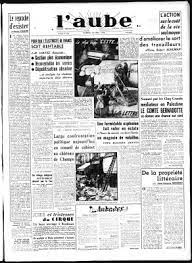
- La destinée de Piet Mondrian, L’Aube, 1.
- “Mon Faust” de Valery, L’Aube, VI.
- Lucien Fugrihe, L’Aube, VII.
- Braque, Picasso et Sophie Taeuber-Arp, L’Aube, VIII.
- Les Réalités Nouvelles n’admettent pas … , L’Aube, 4. VIII.
- Artaud et van Gogh, L’Aube, 22. IX.
- En 1648 naquit, dans l’atelier de Rembrandt … L’Aube, 2. IX.
- Le tricentenaire de l’Emmaüs de Rembrandt, L’Aube, IX.
- Le Christ à Emmaüs, Arts, X.
- Jeunesse de Picabia, Arts, 19.
- Revue “Courrier”, 10 no’s (juillet 1947 – décembre. 1948) (textes de e. M. Seuphor, R.A. Benoit, R. Toulouse, Max Jacob, Survage, Jean Arp, Kandinsky, Lurat, Francis Picabia), Les Bibliophiles alésiens
- Les Arts en province, 5 numéros, Les Bibliophiles alésiens
1949
- Les révolutions sont des ballons d’essai, Derrière le miroir,
- Piet Mondrian et les origines du néoplasticisme, Art d’Aujourd’hui, n°5 1ères série,2 pages.
- Promenade autour de Vieira da Silva, Cahiers d’art
- Les Jobards, Cévennes, 11.
- Les débuts de l’art abstrait, Amis de l’art 8
- George Koskas, Derrière le miroir 22, X.
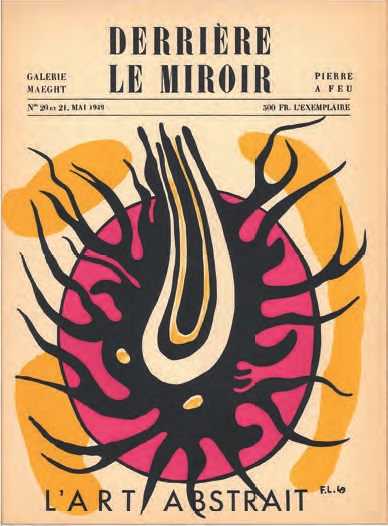
- Le mur, Art d’Aujourd’hui, n°1, 1ère série n.p
- Bazaine, Art d’Aujourd’hui n° 6, XII
1950
- Sophie Taeuber-Arp, Jean Arp, Art d’Aujourd’hui, n° 10/11, 1ère série juin 1950 p 28 à 33
- L’Orphisme, Art d’Aujourd’hui n°7/8, 1ère série, p25 et 26.
- Henri Davring, Art d’Aujourd’hui n°9, 1ère série, p 23
- Leo Maillet, Art d’Aujourd’hui n°10/11, 1ère série, p24
- Schöffer, Art d’Aujourd’hui n°10/11,1ère série, p 24
- Les Muses fonctionnaires, Art d’Aujourd’hui, n°1, 2ème série, p 19.
- Suprématisme et néoplasticisme, Art d’Aujourd’hui n°7/8, p 22 à 24.
- Les Sonnets de Jean Cassou, L’Aube, 17.
- Painting in France, Magazine of Art 43
- Mondrian, Art d’Aujourd’hui, n°6, 1ère série, n.p
1951
- Temps héroïques et survivance de l’art abstrait, Spazio, , Roma
- Paris-New York, Art d’Aujourd’hui, n°6, 2ème série, numéro spécial sur La peinture aux Etats-Unis. P 4 à 15.
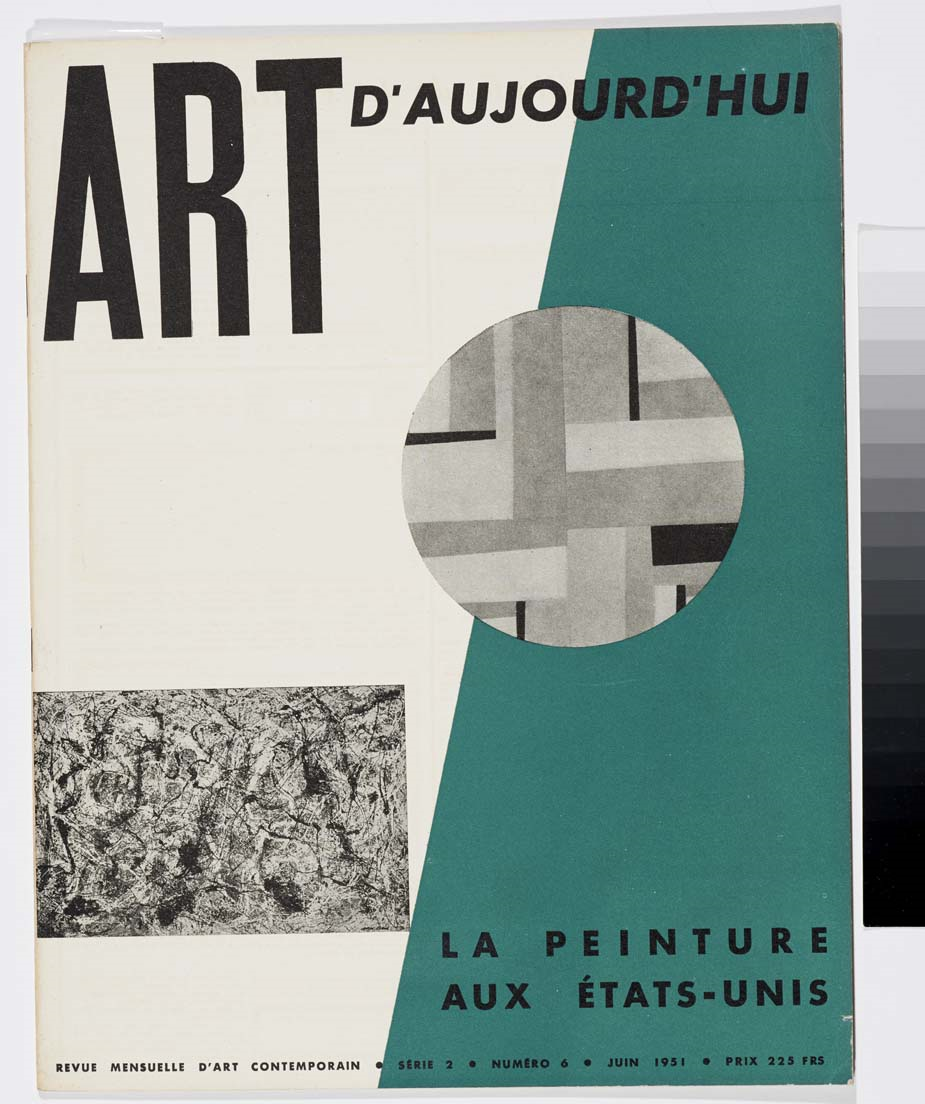
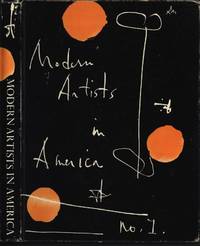
- Le peintre Van der Leck, Werk, , Winthertur
- Véhémences confrontées, Art d’Aujourd’hui 2e no. 5, IV. / V.
- Espace animé, Art d’Aujourd’hui, n°5, 2ème série, 2ème de couverture.
- Robert Delaunay, Art d’Aujourd’hui, n°8, 2ème série p12-13
- Exposition “De Stijl”, Museum Amsterdam, Art d’aujourd’hui, n°8, 2ème série, p 26
- Anthoons, Art d’Aujourd’hui, n°8, 2ème série, p 32
- Lapicque, Art d’Aujourd’hui, n°7, 2ème série, p 32
- Pink, Art d’Aujourd’hui, n°5, 3ème série, p 29
1952
- Le vide actif, XXe siècle n°2
- Histoire sommaire du Tableau-poème, XXe siècle, n°3, p 21à 25.
- II n’y a pas de repos, Derrière le miroir, X.
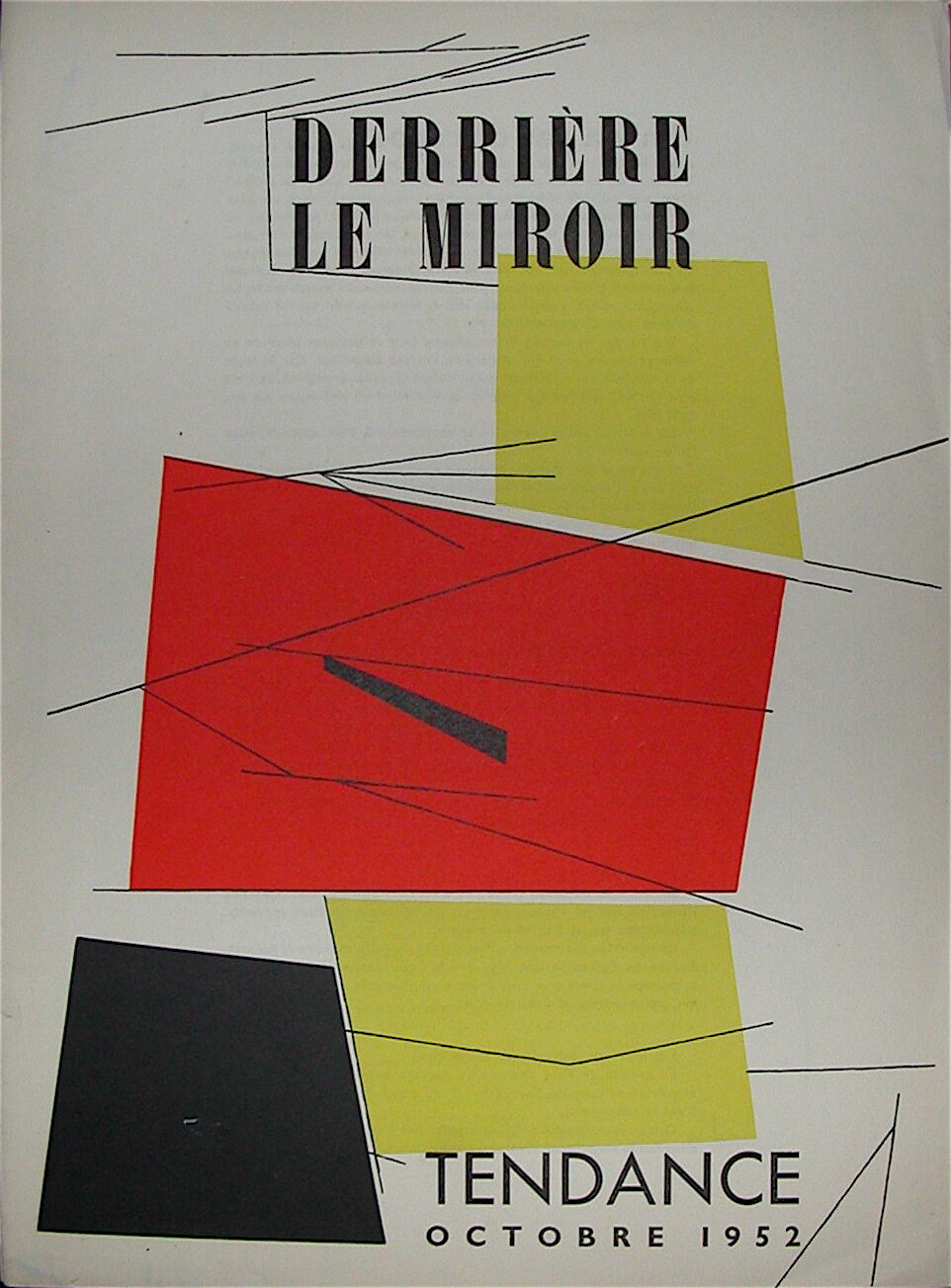
- Piet Mondrian 1914-1918, Magazine of art 45, V.
- Marcelle Cahn, Art d’Aujourd’hui, n°3-4, 3ème série, p 62
- Severini, Art d’Aujourd’hui, n°5, 3ème série, p29
- Les Américains à la Galerie de France, Art d’Aujourd’hui, / III.
- Paris – New York 1951, Modern artists in America, Wittenborn, New York
- Les mosaïques de Severini, Art d’aujourd’hui,
1953
- L’art de ce siècle, Cimaise 2,
- The best of the Cubists, Art Digest, III, New York
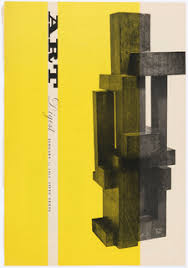
- L’Amérique à Paris, Preuves, VI
- Guide for July, Art Digest, VII, New York
- Note sur les rapports de l’art et de la société, Cimaise 4/5, VII
- La nouvelle installation du musée du Louvre, Preuves VIII
- The spirit blows where it will, Art Digest, XI, New York
- Theo van Doesburg, Art d’Aujourd’hui, n° 8, 4ème série, p1.
- Islande, Art d’Aujourd’hui, n°7, 4ème série, p 16 et 17.
- L’Aubette de Strasbourg, Art d’Aujourd’hui n°8, 4ème série, p 10 à 13.
- All’s fair, Surveys of today’s art at two Midwestern Universities, Art Digest, III.
- Mondrian parmi les gratte-ciels, Cimaise 3, IV
- Reichel à la Galerie Jeanne Bucher, Preuves,
- Contrasts and Varieties, Art Digest, VI.
- Americans in town, Art Digest, V.
- Klee chez Berggruen, Preuves,
- Paris Round-up, Art Digest, 15. IV.
- Réalités Nouvelles, Art Digest, VIII
- Eaux-fortes à la Hune, Art d’aujourd’hui 7, X.
- Wostan, Art d’aujourd’hui 7, X.
- Nishinoma, Art d’aujourd’hui 7, X.
- Jean Lombard, Art d’aujourd’hui 7, X.
- The Louvre’s new installations, Art Digest, 15. IX.
- Allemagne, Art d’aujourd’hui, n°6, 4ème série, 1953, p 1
- Le premier séjour de Mondrian à Paris 1912-14, Preuves, X.
- Paris, Art Digest, 15, III/9, VI/10, VIII
- Le Corbusier, Art Digest, 15. XII.
- Breuil, Art d’aujourd’hui, n°8, 4ème série, p30
- Lapicque, Art d’aujourd’hui, n°8, 4ème série, p 29
- Mary Webb, Art d’aujourd’hui, n°8, 4ème série, p 30.
- Kolos Vari, Art d’aujourd’hui, XII.
- Agam, Art d’aujourd’hui, n°8, 4ème série, p32
- Le Corbusier, Art d’aujourd’hui, n°8, 4ème série, p26.
- Un musée dans les bois, Art d’Aujourd’hui, n°8, 4ème série, p1
1954
- Epitaphe à Picabia, Preuves,
- The neglect of Mondrian, Art Digest, 15.II, New York
- Ensor, Preuves, V.
- Algèbres et géométries, Cimaise 6, V.
- A Tasmanian in Paris, Art Digest 28, IV, New York
- Profile of Jean Arp, Art DigestVII, New York
- Mondrian indésirable, Art d’aujourd’hui n°1, 5ème série p1
- Mondrian peintre figuratif, XXème siècle, 4
- Complément à la Scandinavie, Art d’aujourd’hui n°1, 5ème série, p13 à 15.
- Léon Zack, Art d’aujourd’hui, n° 2/3, 5ème série, p 61
- René Legrand, Art d’aujourd’hui n°2/3, 5ème série, p 62
- René Legrand, Art d’aujourd’hui, n°4, 5ème série, p31
- Roberta Gonzales, Art d’aujourd’hui, n°2/3, 5ème série, p63
- Huguette Bertrand, Art d’aujourd’hui 2/3, 5ème série, p 63
- Rossiné, Art d’aujourd’hui n°2/3, 5ème série, p64
- Francis Bott, Art d’aujourd’hui n°2/3, 5ème série, p65
- La synthèse des arts, est-elle possible ? Art d’aujourd’hui, n° 4/5, 5ème série.
- Staritsky, Art d’aujourd’hui n°4/5, 5ème série, p 60
- Maria Manton, Art d’aujourd’hui, n°4/5,5ème série, p 60
- Kayler, Art d’aujourd’hui, n°4/5,5ème série, p 60
- Dumitresco, Art d’aujourd’hui n°4/5, 5ème série, p62
- Schöffer, Art d’aujourd’hui n°4/5, 5ème série, p 64
- Le salon des réalités nouvelles, Art d’aujourd’hui n°6, 5ème série, p29
- Barta, Art d’aujourd’hui, n°6, 5ème série, p 32
- Baumeister, Art d’aujourd’hui, n°1, 5ème série, p 30
- Art sacré, Art d’aujourd’hui, 7, 5ème série, p 9 à 12
- Le commerce de l’art, Art d’aujourd’hui, n°7, 5ème série, p17
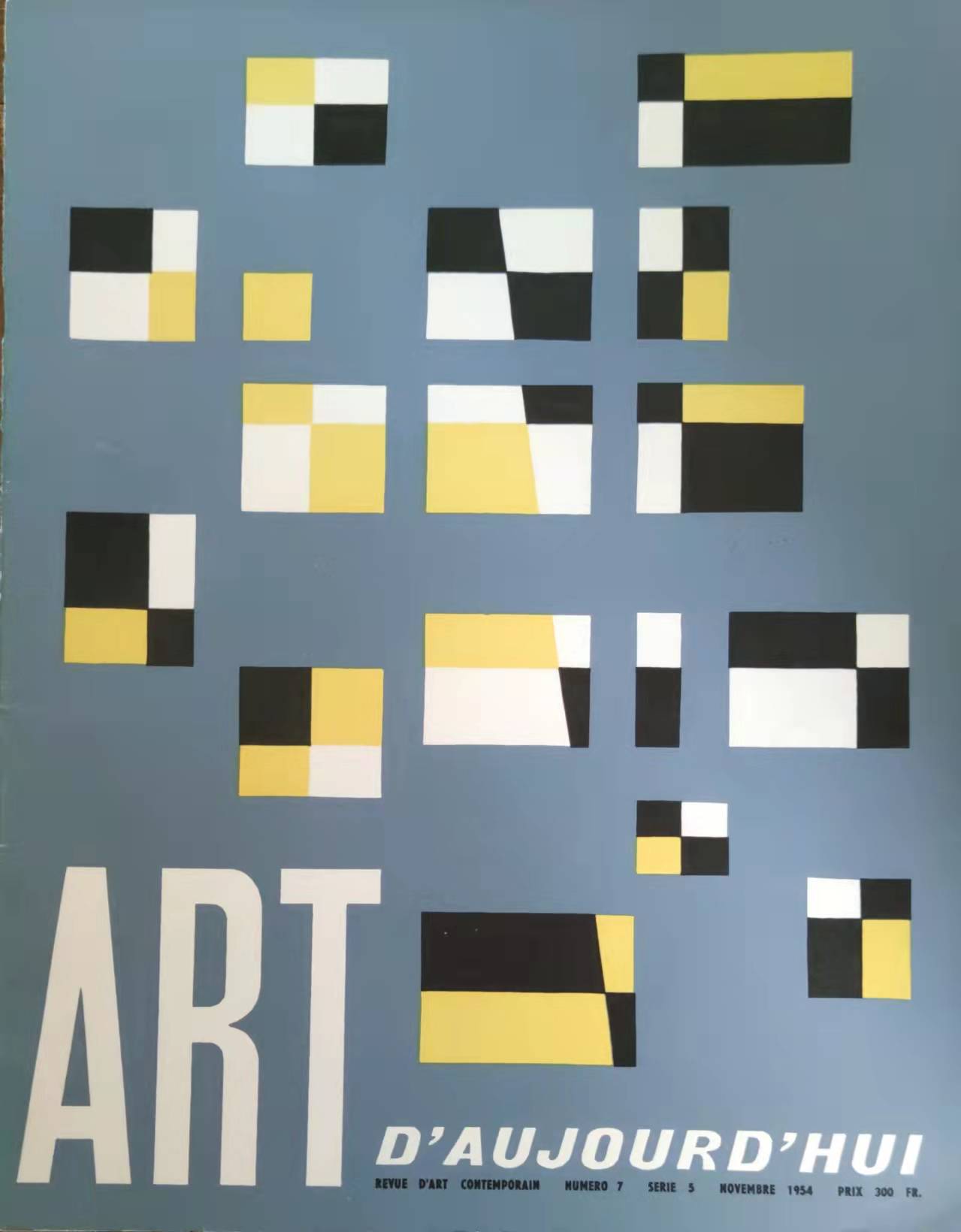
- Henri Matisse (nécrologie), Art d’aujourd’hui, n°7, 5ème série, p23
- Georges Mathieu, Art d’aujourd’hui, n°7, 5ème série, p 30
- Ecole de Paris, 1954 Galerie Charpentier, Art d’aujourd’hui 7
- La calligraphie Japonaise, Art d’aujourd’hui, n°8, 5ème série, p13 et 14
- Paule Vézelay, Art d’aujourd’hui, n°8, 5ème série, p12
- ‘Le Matisse de Barr’, XXe siècle 4
- Capogrossi, XXe siècle 4
- French Art for Caracas, report on the Galleries, Art Digest, 15.I.
- Giacometti à la Galerie Maeght, Preuves 41, VII.
- Collages and Emile Bernard, Art Digest, 1.VII.
- Un Quatuor de peintres, Preuves, IX.
- Giacometti and Sartre, Art Digest, 10.X.
- Léger, Art d’aujourd’hui, n°8, 5ème série, p31.
- Alechinsky, Art d’aujourd’hui, n°8, 5ème série, p31
- Picasso, Art Digest, 13.XII.
- Caracas, Art d’Aujourd’hui, n°7, 5ème série, p 28 et 29
- Collage, Art d’Aujourd’hui, n°2-3, p1.
- Deuxième album de sérigraphie, Art d’aujourd’hui, n°7,5ème série, p 28 et 29
- Maison à Strasbourg en 1927, Art d’aujourd’hui, n°4-5, 5ème série, p 1
- L’art et la manière, Art d’aujourd’hui, n°7, 5ème série, p 18 et 19
1955
- Hans Hartung, Art Digest, 1.III, New York
- Report from Holland (Mondrian in The Hague 5 American in Amsterdam), Art Digest, 15. IV. New York
- Jeunes peintres au musée de l’Art moderne, Preuves, XII.
- Humanisme de Mondrian (texte de la conférence du même titre), Aujourd’hui, Art et Architecture, n°
- Paul Klee ou la création ininterrompue, Preuves, III.
- Art Moderne, ancien et nouveau, Amsterdam Aujourd’hui, Art et Architecture, n°4
- Au temps de l’avant-garde, L’œil 11
- Le Style et le cri en 1955, Aujourd’hui, Art et Architecture, n°3
- Matière à discussion, XXe siècle 5
- Klee et Villon, Preuves
- Baumeister, Art d’aujourd’hui, 5
- The New Season is Open, Art Digest, 15.I.
- The Galerie Rive Droite, Art Digest, 1.III.
- Paris Galleries, Art Digest, 1. IV.
- Paris, Art Digest, 1. IV.
- Paris, Art Digest, 15.VII.
- Mondrian, Wetenschap en Samenleving, VII
- Une demeure pour l’esprit, Art d’aujourd’hui, 2
- Hofmann, Art d’aujourd’hui, 2
- Calligraphy as expression, exhibition at Fried Gall, Art Digest 29, V.
1956
- Un musée militant, L’Œil 14
- De Stijl, L’œil, 21
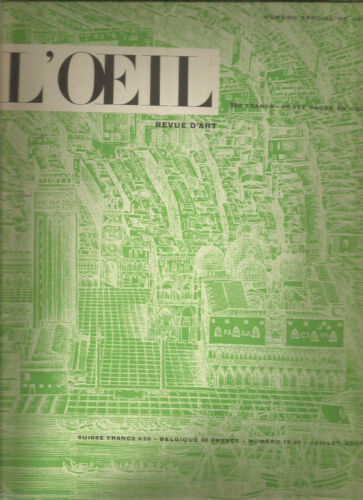
- Le futurisme…. Hier, L’Œil, 14
- Le Collage Dadaïste, XXe siècle, 6
- Arte Abstracto 1955 en Paris, Compas, 4, Vénézuela
1957
- Mondrian, Art d’aujourd’hui, 11
- L’œuvre figurative de Mondrian, Apollo LXV
- Yesterday, today, tomorrow, The world of abstract art, Wittenborn, New York
- Le retour de Mondrian ou les cendres brûlantes, Art d’aujourd’hui, I.
- 50 ans de peinture abstraite, Combat-Art, 17.VI.
- Hier, Aujourd’hui, Demain, Art d’aujourd’hui, 13.VI.
- Jean Arp, L’Œil 28
- Piet Mondrian in New York, Werk 3
- Piet Mondrian et le nouveau réalisme, XXe siècle 9
- L’Internationale Dada, L’Œil 2, IV.
- L’Amateur critique : le critique en 50 ans de la peinture abstraite, Combat-Art, 17.VI.
- Delaunay te Gambais in 1950, Museumjournaal, XI.
1958
- Synchronies (S. Macdonald-Wright et Morgan Russel), L’Oeil 37
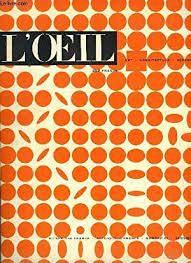
- Mondrian, décors, Art d’aujourd’hui, 17.
- Regardons mieux la sculpture, Art d’aujourd’hui, 19, IX.
- La sculpture suisse à Berne, Art d’aujourd’hui, 19
1959
- Le choix d’un critique, L’œil 49
- Peintures construites, L’œil 58 X.
- Sens et permanence de la peinture construite, Quadrum 8
- Arguments pour la Sculpture, Courrier de la chambre spéciale des arts et des lettres, I., Luxembourg
- Notizen über die idée der konstruktion, Kunstbrief 5, IV, Frankfurt
- Promotion de la sculpture, Cimaise, VI.
- Gledajmo bolje skulpturn, Covjek I proctor 85, 15.IV, Zagreb
- Sculpture et Architecture, Habiter, XI., Bruxelles
1960
- Pleidooi voor de beeldhouwkunst, Streven, V, Belgique
- La Mostra Larionov e Gontcharova (avec G. Apollinaire), 1 4 Soli 5/6, Torino
1961
- Mondrian inactuel (texte de la conférence du même titre), Quadrum 12
- L’art en Allemagne après la guerre, Istan, Orient-Occident 5, VI.
- Beeldhouwkunst en Bouwkunst, Sanirama 1, VII, Paris/Anvers
- Reliefs construits, XXe siècle 23, V.
1962
- La notion d’architecture dans la peinture contemporaine (texte de la conférence du mem titre), Bulletin Musée Royal des Beaux-Arts, Bruxelles
- De Stijl, XXe siècle 19, VI.
- Art Construit, XXe siècle, 24.VI.
- La Sculpture de Gisiger, Cinquième Saison 16
1963
- Que sera l’art dans 20 ans (réponse à l’enquête), Arts-Spectacles, 9.I, Paris
- Mondrian, Enciclopedia Universale d’Arte. vol. IX.
- Het begrip architectuur in de hedendaagse schilderkunst, De Vlaamse Gids
1966
- Mondrian et la pensée de Schoenmaekers, Werk 53, IX.
- Perspectives sur Dada, années vingt, Cahiers de l’association pour l’étude de Dada et du Surréalisme n°1.
- Victor Servranckx ‘Opus 47’, Openbaar Kunstbezit in Vlaanderen
1968
- Otto Greis, Badischer Kunstverein, Karlsruhe
1970
- De Stijl, Cimaise Spécial De Stijl, XI/
- Interview M.S. avec J.J. Levêque, Cimaise,
- Barros, XXe siècle 34, VI.
1972
- Promenade dans Geer van Velde, L’art vivant, VI/ VII.
- Après la cour des miracles, La Tour de Feu 14, VI.
- Le témoignage de M.S. : Mondrian, peintre figuratif : le peintre de la “nouvelle réalité”, XXe siècle 38, VI.
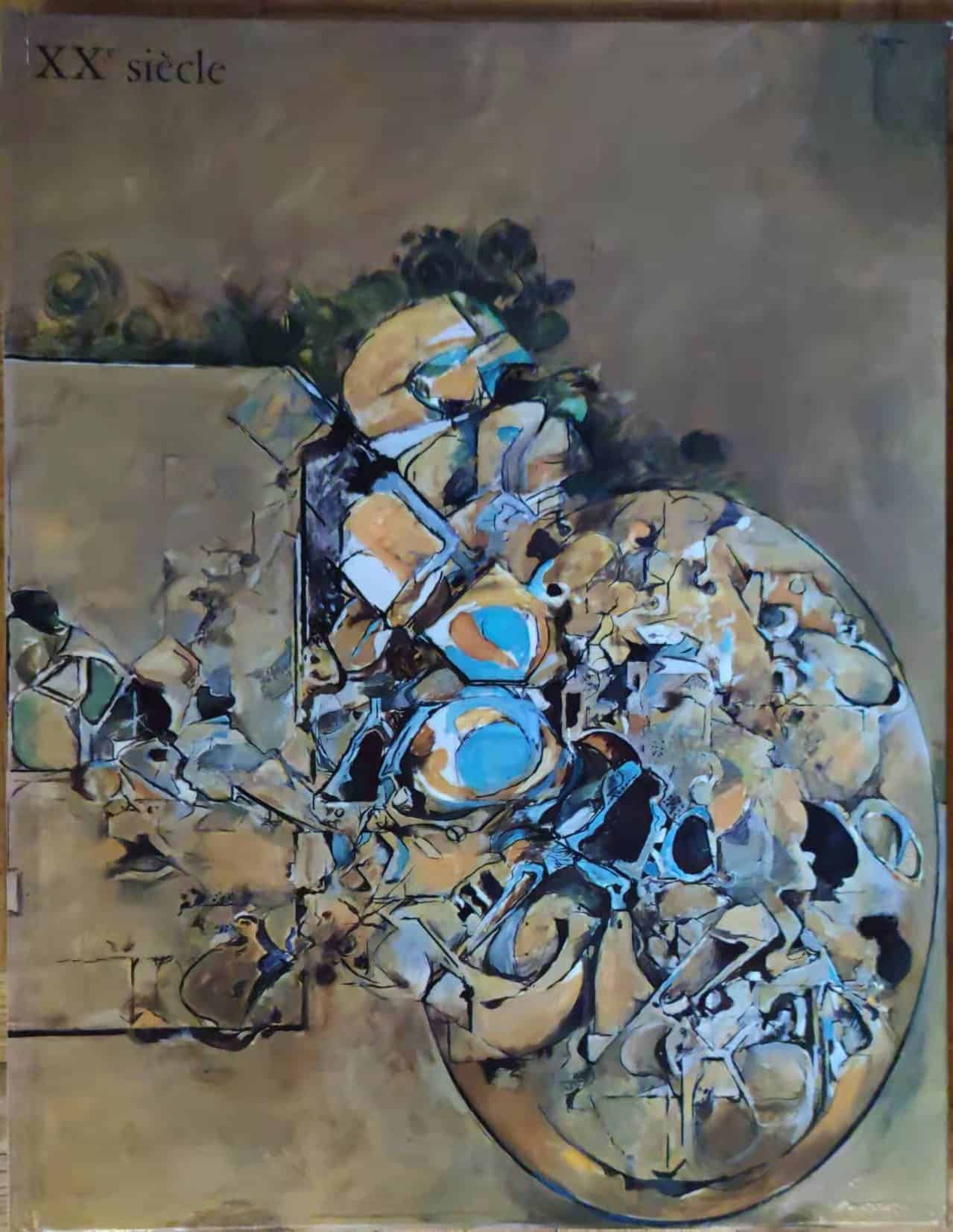
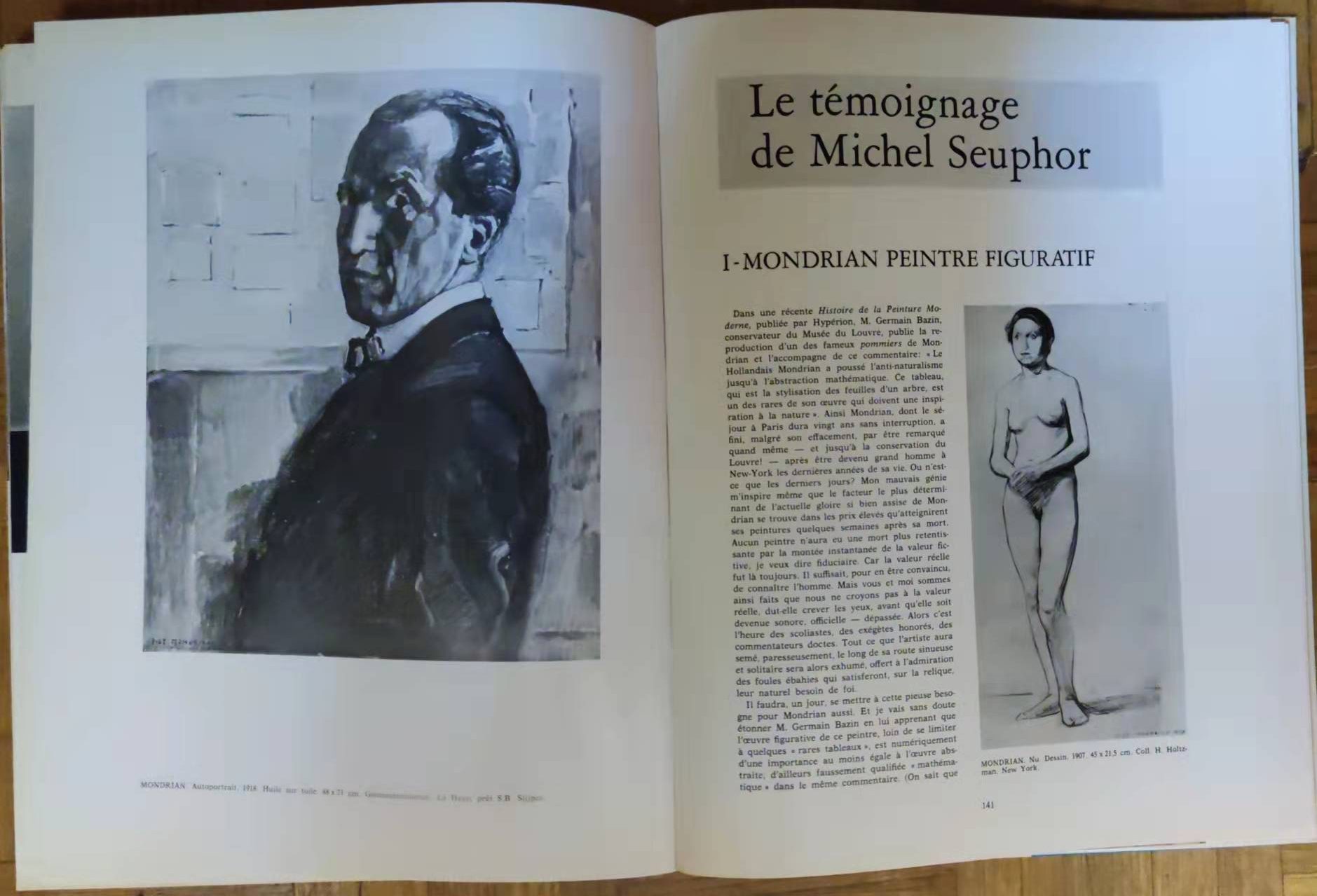
1973
- Souvenirs en pizzicato (memories in pizzicato), XXe siècle 40, vol. 35, VI.
- La tendenza alla ripetizione dei segni semptici nell’ arte contemporanea (texte de la conférence sur la tendance à la répétition des signes géométriques simples dans l’art contemporain), Arte a Società, X, Roma
- Exit Fritz Glarner, XXe siècle, 40
1974
- Notes sur la critique de l’art, Construire 44, X, Lausanne
1975
- Les artistes et les autres (notes sur le spectateur), Construire 16, IV, Lausanne
- Interview avec Martine Palmé, Les Nouvelles Littéraires. 17-23
- Le Silence et la ligne (interview enregistre par Sylvio Acatos), Construire 51, XII, Lausanne
- Témoignage, Torrès Garcia construction et symboles, MNAM Paris.
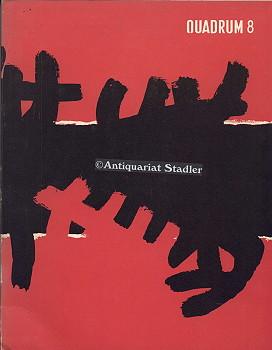
1976
- Europe-Amérique ou le jeu des libertés, Construire 26, Lausanne
- La conquête des Delaunay, Construire 30, Lausanne
1980
- Entretien avec Anna Erede « Orpheus within » Resurgence, p 24 et 25
1984
- Penser, c’est être libre (1943), L’Hippocampe, n3, 1984, Paris.
1991
- Le Peintre, le poète, Poésie présente, n 78, 1991.
1994
- Der Nil ist grün, Ingeborg Bosch, Treffpunkt Kunst, Saarlouis, 1994.
1996
- Paul Van Ostaijen, Interview with Michel Seuphor par Henri-Floris Jespers. Kunst & Cultuur, 96-03, mars 1996.
ARTICLES PUBLISHED IN ART MAGAZINES
(list established from the bibliography of the Monographie Seuphor de Mercator Fonds, 1976)
1922
- Derde kongres voor modern kunst. Brugge 5 en 6 oogst 1922. Het Overzicht, numéro 11-12. Anvers, 1922
- De Natuur, Zij, De Mens, Hij. Het Overzicht, numéro 14, décembre 1922
- Toneel. Het Overzicht, numéro 14, décembre 1922
1923
- Bij de Ontwerpen van Dr Berlage. Het Overzicht, numéro 15, Mars-Avril 1923
- Toneelkronijk, Het Overzicht, numéro 16, May-Juin 1923
- Parijsse Letterkundigen. Het Overzicht, numéro 17, septembre 1923
1924
- Over Kunst in 12 punt, Het Overzicht, numéro 20, Janvier 1924
- Hollandse Dichters van 1923, Het Overzicht, numéro 20, Janvier 1924
- Kronijk uit Parijs. Het Overzicht, numéro 21, avril 1924
1930
- Pour la défense d’une architecture (Manifeste), Cercle et Carré, 1, Paris, 1930.
- Poétique nouvelle, Cercle et Carré, 3, Paris, 1930.
1936
- Le poète et son temps, Les cahiers du journal des poètes, série Enquêtes, n°16, p 51 à 55
1937
- Christen-calvinist (article sur Mondrian), Opbouwen,
1947
- Le dessin suit son idée, dessin de Survage, Les Bibliophiles alésiens
- Cubistes et abstraits sont les hôtes du Palais des Papes, Cévennes (Alès), VIll.
- Peinture, Faune et Flore à Monaco, Cévennes (Alès), IX.
- Picasso à Antibes, Cévennes (Alès), 22.
1948
- L’exposition des arguments, Saisie motivée des principaux peintres de ce 1. De Matisse à Miro, 2. De Dufy à Lurat, 3. Ensor et notes, Les Bibliophiles alésiens
- La grande nouveauté de la musique, Les Bibliophiles alésiens
- Claire et Yvan Goll, L’Aube,I.

- La destinée de Piet Mondrian, L’Aube, 1.
- “Mon Faust” de Valery, L’Aube, VI.
- Lucien Fugrihe, L’Aube, VII.
- Braque, Picasso et Sophie Taeuber-Arp, L’Aube, VIII.
- Les Réalités Nouvelles n’admettent pas … , L’Aube, 4. VIII.
- Artaud et van Gogh, L’Aube, 22. IX.
- En 1648 naquit, dans l’atelier de Rembrandt … L’Aube, 2. IX.
- Le tricentenaire de l’Emmaüs de Rembrandt, L’Aube, IX.
- Le Christ à Emmaüs, Arts, X.
- Jeunesse de Picabia, Arts, 19.
- Revue “Courrier”, 10 no’s (juillet 1947 – décembre. 1948) (textes de e. M. Seuphor, R.A. Benoit, R. Toulouse, Max Jacob, Survage, Jean Arp, Kandinsky, Lurat, Francis Picabia), Les Bibliophiles alésiens
- Les Arts en province, 5 numéros, Les Bibliophiles alésiens
1949
- Les révolutions sont des ballons d’essai, Derrière le miroir,
- Piet Mondrian et les origines du néoplasticisme, Art d’Aujourd’hui, n°5 1ères série,2 pages.
- Promenade autour de Vieira da Silva, Cahiers d’art
- Les Jobards, Cévennes, 11.
- Les débuts de l’art abstrait, Amis de l’art 8
- George Koskas, Derrière le miroir 22, X.

- Le mur, Art d’Aujourd’hui, n°1, 1ère série n.p
- Bazaine, Art d’Aujourd’hui n° 6, XII
1950
- Sophie Taeuber-Arp, Jean Arp, Art d’Aujourd’hui, n° 10/11, 1ère série juin 1950 p 28 à 33
- L’Orphisme, Art d’Aujourd’hui n°7/8, 1ère série, p25 et 26.
- Henri Davring, Art d’Aujourd’hui n°9, 1ère série, p 23
- Leo Maillet, Art d’Aujourd’hui n°10/11, 1ère série, p24
- Schöffer, Art d’Aujourd’hui n°10/11,1ère série, p 24
- Les Muses fonctionnaires, Art d’Aujourd’hui, n°1, 2ème série, p 19.
- Suprématisme et néoplasticisme, Art d’Aujourd’hui n°7/8, p 22 à 24.
- Les Sonnets de Jean Cassou, L’Aube, 17.
- Painting in France, Magazine of Art 43
- Mondrian, Art d’Aujourd’hui, n°6, 1ère série, n.p
1951
- Temps héroïques et survivance de l’art abstrait, Spazio, , Roma
- Paris-New York, Art d’Aujourd’hui, n°6, 2ème série, numéro spécial sur La peinture aux Etats-Unis. P 4 à 15.


- Le peintre Van der Leck, Werk, , Winthertur
- Véhémences confrontées, Art d’Aujourd’hui 2e no. 5, IV. / V.
- Espace animé, Art d’Aujourd’hui, n°5, 2ème série, 2ème de couverture.
- Robert Delaunay, Art d’Aujourd’hui, n°8, 2ème série p12-13
- Exposition “De Stijl”, Museum Amsterdam, Art d’aujourd’hui, n°8, 2ème série, p 26
- Anthoons, Art d’Aujourd’hui, n°8, 2ème série, p 32
- Lapicque, Art d’Aujourd’hui, n°7, 2ème série, p 32
- Pink, Art d’Aujourd’hui, n°5, 3ème série, p 29
1952
- Le vide actif, XXe siècle n°2
- Histoire sommaire du Tableau-poème, XXe siècle, n°3, p 21à 25.
- II n’y a pas de repos, Derrière le miroir, X.

- Piet Mondrian 1914-1918, Magazine of art 45, V.
- Marcelle Cahn, Art d’Aujourd’hui, n°3-4, 3ème série, p 62
- Severini, Art d’Aujourd’hui, n°5, 3ème série, p29
- Les Américains à la Galerie de France, Art d’Aujourd’hui, / III.
- Paris – New York 1951, Modern artists in America, Wittenborn, New York
- Les mosaïques de Severini, Art d’aujourd’hui,
1953
- L’art de ce siècle, Cimaise 2,
- The best of the Cubists, Art Digest, III, New York

- L’Amérique à Paris, Preuves, VI
- Guide for July, Art Digest, VII, New York
- Note sur les rapports de l’art et de la société, Cimaise 4/5, VII
- La nouvelle installation du musée du Louvre, Preuves VIII
- The spirit blows where it will, Art Digest, XI, New York
- Theo van Doesburg, Art d’Aujourd’hui, n° 8, 4ème série, p1.
- Islande, Art d’Aujourd’hui, n°7, 4ème série, p 16 et 17.
- L’Aubette de Strasbourg, Art d’Aujourd’hui n°8, 4ème série, p 10 à 13.
- All’s fair, Surveys of today’s art at two Midwestern Universities, Art Digest, III.
- Mondrian parmi les gratte-ciels, Cimaise 3, IV
- Reichel à la Galerie Jeanne Bucher, Preuves,
- Contrasts and Varieties, Art Digest, VI.
- Americans in town, Art Digest, V.
- Klee chez Berggruen, Preuves,
- Paris Round-up, Art Digest, 15. IV.
- Réalités Nouvelles, Art Digest, VIII
- Eaux-fortes à la Hune, Art d’aujourd’hui 7, X.
- Wostan, Art d’aujourd’hui 7, X.
- Nishinoma, Art d’aujourd’hui 7, X.
- Jean Lombard, Art d’aujourd’hui 7, X.
- The Louvre’s new installations, Art Digest, 15. IX.
- Allemagne, Art d’aujourd’hui, n°6, 4ème série, 1953, p 1
- Le premier séjour de Mondrian à Paris 1912-14, Preuves, X.
- Paris, Art Digest, 15, III/9, VI/10, VIII
- Le Corbusier, Art Digest, 15. XII.
- Breuil, Art d’aujourd’hui, n°8, 4ème série, p30
- Lapicque, Art d’aujourd’hui, n°8, 4ème série, p 29
- Mary Webb, Art d’aujourd’hui, n°8, 4ème série, p 30.
- Kolos Vari, Art d’aujourd’hui, XII.
- Agam, Art d’aujourd’hui, n°8, 4ème série, p32
- Le Corbusier, Art d’aujourd’hui, n°8, 4ème série, p26.
- Un musée dans les bois, Art d’Aujourd’hui, n°8, 4ème série, p1
1954
- Epitaphe à Picabia, Preuves,
- The neglect of Mondrian, Art Digest, 15.II, New York
- Ensor, Preuves, V.
- Algèbres et géométries, Cimaise 6, V.
- A Tasmanian in Paris, Art Digest 28, IV, New York
- Profile of Jean Arp, Art DigestVII, New York
- Mondrian indésirable, Art d’aujourd’hui n°1, 5ème série p1
- Mondrian peintre figuratif, XXème siècle, 4
- Complément à la Scandinavie, Art d’aujourd’hui n°1, 5ème série, p13 à 15.
- Léon Zack, Art d’aujourd’hui, n° 2/3, 5ème série, p 61
- René Legrand, Art d’aujourd’hui n°2/3, 5ème série, p 62
- René Legrand, Art d’aujourd’hui, n°4, 5ème série, p31
- Roberta Gonzales, Art d’aujourd’hui, n°2/3, 5ème série, p63
- Huguette Bertrand, Art d’aujourd’hui 2/3, 5ème série, p 63
- Rossiné, Art d’aujourd’hui n°2/3, 5ème série, p64
- Francis Bott, Art d’aujourd’hui n°2/3, 5ème série, p65
- La synthèse des arts, est-elle possible ? Art d’aujourd’hui, n° 4/5, 5ème série.
- Staritsky, Art d’aujourd’hui n°4/5, 5ème série, p 60
- Maria Manton, Art d’aujourd’hui, n°4/5,5ème série, p 60
- Kayler, Art d’aujourd’hui, n°4/5,5ème série, p 60
- Dumitresco, Art d’aujourd’hui n°4/5, 5ème série, p62
- Schöffer, Art d’aujourd’hui n°4/5, 5ème série, p 64
- Le salon des réalités nouvelles, Art d’aujourd’hui n°6, 5ème série, p29
- Barta, Art d’aujourd’hui, n°6, 5ème série, p 32
- Baumeister, Art d’aujourd’hui, n°1, 5ème série, p 30
- Art sacré, Art d’aujourd’hui, 7, 5ème série, p 9 à 12
- Le commerce de l’art, Art d’aujourd’hui, n°7, 5ème série, p17

- Henri Matisse (nécrologie), Art d’aujourd’hui, n°7, 5ème série, p23
- Georges Mathieu, Art d’aujourd’hui, n°7, 5ème série, p 30
- Ecole de Paris, 1954 Galerie Charpentier, Art d’aujourd’hui 7
- La calligraphie Japonaise, Art d’aujourd’hui, n°8, 5ème série, p13 et 14
- Paule Vézelay, Art d’aujourd’hui, n°8, 5ème série, p12
- ‘Le Matisse de Barr’, XXe siècle 4
- Capogrossi, XXe siècle 4
- French Art for Caracas, report on the Galleries, Art Digest, 15.I.
- Giacometti à la Galerie Maeght, Preuves 41, VII.
- Collages and Emile Bernard, Art Digest, 1.VII.
- Un Quatuor de peintres, Preuves, IX.
- Giacometti and Sartre, Art Digest, 10.X.
- Léger, Art d’aujourd’hui, n°8, 5ème série, p31.
- Alechinsky, Art d’aujourd’hui, n°8, 5ème série, p31
- Picasso, Art Digest, 13.XII.
- Caracas, Art d’Aujourd’hui, n°7, 5ème série, p 28 et 29
- Collage, Art d’Aujourd’hui, n°2-3, p1.
- Deuxième album de sérigraphie, Art d’aujourd’hui, n°7,5ème série, p 28 et 29
- Maison à Strasbourg en 1927, Art d’aujourd’hui, n°4-5, 5ème série, p 1
- L’art et la manière, Art d’aujourd’hui, n°7, 5ème série, p 18 et 19
1955
- Hans Hartung, Art Digest, 1.III, New York
- Report from Holland (Mondrian in The Hague 5 American in Amsterdam), Art Digest, 15. IV. New York
- Jeunes peintres au musée de l’Art moderne, Preuves, XII.
- Humanisme de Mondrian (texte de la conférence du même titre), Aujourd’hui, Art et Architecture, n°
- Paul Klee ou la création ininterrompue, Preuves, III.
- Art Moderne, ancien et nouveau, Amsterdam Aujourd’hui, Art et Architecture, n°4
- Au temps de l’avant-garde, L’œil 11
- Le Style et le cri en 1955, Aujourd’hui, Art et Architecture, n°3
- Matière à discussion, XXe siècle 5
- Klee et Villon, Preuves
- Baumeister, Art d’aujourd’hui, 5
- The New Season is Open, Art Digest, 15.I.
- The Galerie Rive Droite, Art Digest, 1.III.
- Paris Galleries, Art Digest, 1. IV.
- Paris, Art Digest, 1. IV.
- Paris, Art Digest, 15.VII.
- Mondrian, Wetenschap en Samenleving, VII
- Une demeure pour l’esprit, Art d’aujourd’hui, 2
- Hofmann, Art d’aujourd’hui, 2
- Calligraphy as expression, exhibition at Fried Gall, Art Digest 29, V.
1956
- Un musée militant, L’Œil 14
- De Stijl, L’œil, 21

- Le futurisme…. Hier, L’Œil, 14
- Le Collage Dadaïste, XXe siècle, 6
- Arte Abstracto 1955 en Paris, Compas, 4, Vénézuela
1957
- Mondrian, Art d’aujourd’hui, 11
- L’œuvre figurative de Mondrian, Apollo LXV
- Yesterday, today, tomorrow, The world of abstract art, Wittenborn, New York
- Le retour de Mondrian ou les cendres brûlantes, Art d’aujourd’hui, I.
- 50 ans de peinture abstraite, Combat-Art, 17.VI.
- Hier, Aujourd’hui, Demain, Art d’aujourd’hui, 13.VI.
- Jean Arp, L’Œil 28
- Piet Mondrian in New York, Werk 3
- Piet Mondrian et le nouveau réalisme, XXe siècle 9
- L’Internationale Dada, L’Œil 2, IV.
- L’Amateur critique : le critique en 50 ans de la peinture abstraite, Combat-Art, 17.VI.
- Delaunay te Gambais in 1950, Museumjournaal, XI.
1958
- Synchronies (S. Macdonald-Wright et Morgan Russel), L’Oeil 37

- Mondrian, décors, Art d’aujourd’hui, 17.
- Regardons mieux la sculpture, Art d’aujourd’hui, 19, IX.
- La sculpture suisse à Berne, Art d’aujourd’hui, 19
1959
- Le choix d’un critique, L’œil 49
- Peintures construites, L’œil 58 X.
- Sens et permanence de la peinture construite, Quadrum 8
- Arguments pour la Sculpture, Courrier de la chambre spéciale des arts et des lettres, I., Luxembourg
- Notizen über die idée der konstruktion, Kunstbrief 5, IV, Frankfurt
- Promotion de la sculpture, Cimaise, VI.
- Gledajmo bolje skulpturn, Covjek I proctor 85, 15.IV, Zagreb
- Sculpture et Architecture, Habiter, XI., Bruxelles
1960
- Pleidooi voor de beeldhouwkunst, Streven, V, Belgique
- La Mostra Larionov e Gontcharova (avec G. Apollinaire), 1 4 Soli 5/6, Torino
1961
- Mondrian inactuel (texte de la conférence du même titre), Quadrum 12
- L’art en Allemagne après la guerre, Istan, Orient-Occident 5, VI.
- Beeldhouwkunst en Bouwkunst, Sanirama 1, VII, Paris/Anvers
- Reliefs construits, XXe siècle 23, V.
1962
- La notion d’architecture dans la peinture contemporaine (texte de la conférence du mem titre), Bulletin Musée Royal des Beaux-Arts, Bruxelles
- De Stijl, XXe siècle 19, VI.
- Art Construit, XXe siècle, 24.VI.
- La Sculpture de Gisiger, Cinquième Saison 16
1963
- Que sera l’art dans 20 ans (réponse à l’enquête), Arts-Spectacles, 9.I, Paris
- Mondrian, Enciclopedia Universale d’Arte. vol. IX.
- Het begrip architectuur in de hedendaagse schilderkunst, De Vlaamse Gids
1966
- Mondrian et la pensée de Schoenmaekers, Werk 53, IX.
- Perspectives sur Dada, années vingt, Cahiers de l’association pour l’étude de Dada et du Surréalisme n°1.
- Victor Servranckx ‘Opus 47’, Openbaar Kunstbezit in Vlaanderen
1968
- Otto Greis, Badischer Kunstverein, Karlsruhe
1970
- De Stijl, Cimaise Spécial De Stijl, XI/
- Interview M.S. avec J.J. Levêque, Cimaise,
- Barros, XXe siècle 34, VI.
1972
- Promenade dans Geer van Velde, L’art vivant, VI/ VII.
- Après la cour des miracles, La Tour de Feu 14, VI.
- Le témoignage de M.S. : Mondrian, peintre figuratif : le peintre de la “nouvelle réalité”, XXe siècle 38, VI.


1973
- Souvenirs en pizzicato (memories in pizzicato), XXe siècle 40, vol. 35, VI.
- La tendenza alla ripetizione dei segni semptici nell’ arte contemporanea (texte de la conférence sur la tendance à la répétition des signes géométriques simples dans l’art contemporain), Arte a Società, X, Roma
- Exit Fritz Glarner, XXe siècle, 40
1974
- Notes sur la critique de l’art, Construire 44, X, Lausanne
1975
- Les artistes et les autres (notes sur le spectateur), Construire 16, IV, Lausanne
- Interview avec Martine Palmé, Les Nouvelles Littéraires. 17-23
- Le Silence et la ligne (interview enregistre par Sylvio Acatos), Construire 51, XII, Lausanne
- Témoignage, Torrès Garcia construction et symboles, MNAM Paris.

1976
- Europe-Amérique ou le jeu des libertés, Construire 26, Lausanne
- La conquête des Delaunay, Construire 30, Lausanne
1980
- Entretien avec Anna Erede « Orpheus within » Resurgence, p 24 et 25
1984
- Penser, c’est être libre (1943), L’Hippocampe, n3, 1984, Paris.
1991
- Le Peintre, le poète, Poésie présente, n 78, 1991.
1994
- Der Nil ist grün, Ingeborg Bosch, Treffpunkt Kunst, Saarlouis, 1994.
1996
- Paul Van Ostaijen, Interview with Michel Seuphor par Henri-Floris Jespers. Kunst & Cultuur, 96-03, mars 1996.
INTRODUCTION OR CONTRIBUTIONS TO EXHIBITION CATALOGS
(non-exhaustive list extracted from the Monographie Seuphor de Mercator Fonds, 1976)
1946
- Piet Mondrian : réflexions et souvenirs, Stedelijk Museum, Amsterdam
1947
- Le chevalet et le mur, “Sur quatre murs”, Galerie Maeght, Paris, “Derrière le Miroir”,
1948
- Peinture fraiche (cat. Picabia), Galerie Des Deux Iles
- Souvenirs des temps héroïques (cat. Le Rayonnisme), Galerie Des Deux Iles
- Un Quatuor (S. Delaunay, Tauber, A. Magnelli, J. Arp), Galerie Des Deux Iles
1949
- Grandeur de la petitesse ( Expo. Survage), Galerie Des Deux Iles
- Henri Davring, Galerie Des Deux Iles
- Vieira da Silva, Galerie Pierre
- Guitou Knoop, Galerie Pierre
- Eloquence de la ligne (cat. Severini, Picabia, S. Tauber, Hartung, Soulages, etc.), Galerie Des Deux Iles
- La fin de tout ( Expo. Point, Picabia), Galerie Des Deux Iles
- D’un art qui coïncide avec le temps (cat. ), musée de Nîmes
- Peinture de M. Berard (dessins de Arp, Picabia, Survage etc.), Musée d’Alès
- Vieira da Silva, Galerie Pierre
- Francis Bott, Galerie Des Deux Iles
- Rebus, 491, Catalogue-journal de l’exposition Picabia, Galerie Drouin,
1950
- Willy Anthoons, Galerie Des Deux Iles
- Wet paint ( Picabia, Pinacotheca), New York
- Jean Coppel, Galerie Colette Allendy
- Arp and Taeuber-Arp, Galerie Sidney Janis, New York
- Préface en trois temps (expo. Jeanne Coppel), Galerie Colette Allendy
- Henri Davring (Davringhausen), Galerie Des Deux Iles
- Hans Richter, Galerie Des Deux Iles
- Leo Maillet, Galerie Des Deux Iles
- Charles-Richard, Beate et Tom Hulbeck (Hülsenbeck), Galerie Des Deux Iles
1951
- Willy Anthoons, Galerie P.I.A.W., Liege
- Aldo Fleischmann, Galerie Colette Allendy
- De Stijl, Galerie Sidney Janis, New York
- Arcadie d’Arp, Galerie La Hune
1952
- H.N. Werkman, Galerie La Hune
- Nicolas Schöffer, Galerie Mai
- Picabia, Galerie Colette Allendy
- Hülsenbeck, Die New Yorker Kantaten, Galerie Berggruen
- Aurélie Nemours, Galerie Mesure
- Aldo Fleischmann, Galerie Lutz und Meyer, Stuttgart
- Hans Richter, Galerie Mai
- Lutka Pink, Galerie Jeanne Casrel
- Charlotte Calmis, Galerie Arnaud
1953
- Capogrossi, Galerie IL Naviglio, Milano
- Aurelie Nemours, Galerie Colette Allendy
- Braque graveur, Galerie Berggruen
- Braque graveur, P.I.A.W., Liège
- Laubiès, Staritsky, Orix, Van Haardt, Galerie Apollo
- Quatre et Quatre, Galerie Colette Allendy
- Nina Negri and Marc du Plantier, Circle and Square Gallery, New York
- Downing, Debré, van Haardt , Studio Paul Facchetti, Roma
- Arp, Sophie Taeuber-Arp, Liège
1954
- Lee Hersch, Galerie Arnaud
- Willy Anthoons, Galerie Colette Allendy
- Willy Baumeister, Galerie Jeanne Bûcher
- Tryggvadottir, Galerie Colette Allendy
- Propositions sans position, Brancusi et Arp (exposition sept pionniers de la sculpture moderne), Yverdon
- Jean Arp, Biennale de Venise, Venezia
- Lagage, French Art Gallery, Los Angeles
1955
- Hosiasson, Galerie Du Haut Pavé
- Vasarely, Galerie Denise René
- Henri Davring (Davringhausen), Galerie Suzanne de Coninck
- Frank Maliner, Galerie Colette Allendy.
1956
- Macdonald-Wright, Gal Arnaud
- 2 peintres américains, Alcopley et Buffie Johnson, Gal Bing
- Michel, Galerie Du Haut Pavé
1957
- Piet Mondrian, œuvres figuratives des collections parisiennes, Galerie Cordier
- 50 ans de peinture abstraite, Gal Creuze
- Willy Anthoons, Palais des Beaux Art, Bruxelles
- Jean Gorin, Galerie Colette Allendy
- Mondrian (préface album), éd Galerie Denise René
1958
- « 1914 », préface a 12 eaux fortes de jean Arp (album : 1 rue Gabrielle), éd XXe siècle
- Marlow Moss, The Hanover Gallery, London
- Jeune art constructif allemande, Galerie Denise René
- Hadju, Gal Knoedler, New York
- El arte abstracto en Europa, Galerie Color Luz, Habana
- Arp, S Taueber, Seuphor (cinq poèmes inédits), Gal Der Spiegel, Köln
- Willy Anthoons, A.I.A.W., Liege
- Néjad (peintures), Galerie La Cour d’Ingres
1959
- Agam, Galerie Drian, London
- Repli sur la réserve (école de Paris), Galerie Charpentier
- Hommage de Nicolaas Warm, Galerie Creuze
- Yougoslavie constructif chez Denise René, Galerie Denise René
- Orix, Galerie
1960
- Kassak, Galerie Denise René
- Henri Nouveau, Galerie de France
- Di Teana, Sculpture en acier, Gal Denise René
- Arp et Mondrian, Galerie Sidney Janis, New York
- The idea of Construction, Construction and Geometry in Painting, Galerie Chalette, New York
- Kosice, Galerie Denise René, Paris, Galerie Drian, London
- Penalba, Galerie Gerson, New York
- Luc Peire, Galerie Hautefeuille
- Boris Kleint, Plastische Bilder, Galerie Franck, Frankfurt
- Abner, Galerie Denise René
- Rodin, Musée d’Ixelles, Bruxelles
- Gorin et la plastique pure, musée de l’Art Wallon, Liège
1961
- Bruno Munari, Galerie Danese, Milano
- Roger-Francois Thépot, Galerie Hautefeuille
1962
- Inediti dal carnet de poche de M. Seuphor, Galerie Lorenzelli, Milano
- Bonfanti, Galerie Lorenzelli, Milano
- Antonino Virduzzo, cat. Biennale de Venise, Venezia
- Subirachs, Galerie Mesure
- Futuristes, Abstraits, Dadaïstes, Galerie A. Schwarz, Milano
- Willy Anthoons, Galerie Ariel
- Fleischmann, Pauna Gallery
- Jeanne Coppel, Galerie Hybler, Kobenhavn
- Loos, Galerie Des Beaux-Arts
1963
- Gottfried Honegger, Galerie Gimpel und Hanover, Zürich
- Leo Breuer, Museum Hagen/Centre Co-Mo, Paris
- Remarques en marge de la double identité, Galerie Denise René
- Les vieux amis, une lyromaine pour Marcel Janco (dans le catalogue Janco), Galerie Denise René
- Thépot, Galerie Librairie La Prouve, Bruxelles
1964
- Pour Mémoire, cat. Hard Edge, Galerie Denise René
- Carla Prina, Galerie Ateneo, Madrid
- Jules Engel, Galerie Robbles, Los Angeles
- Marcelle Cahn, Galerie Bellechasse
- Charchoune, Galerie Chimène, Saint Etienne
- York Wilson, Roberts Gallery, Toronto
1965
- Larionov et Gontcharova, Galerie A. Schwarz, Milano Carlo Nangeroni, Galerie Lorenzelli, Milano
- Thépot, Galerie Roberts, Toronto
- Gorin et la plastique pure, Musée des Beaux-Arts, Nantes
- Penalba, Galerie Creuzevault
- Jules Engel, Galerie Zéro, Verona
1966
- Le système et la règle, cat. Musée de Nantes
- Jean Gorin, Galerie Yvon Lambert
- L’Architecture graphique de Francis Deswarte, Galerie René Métras, Barcelona
1967
- Einleinutg zu einem Konstruktivistenfest, Galerie Denise René – Hans Mayer, Krefeld
- Beryl Barr-Sharrar, Gal L. Durand
- Honegger : Kunsthaus Zürich
1968
- Di Salvatore, Galerie Thommen, Basel
- Harold Cousins, Galerie Ad Libitum, Antwerpen
1969
- Augusto Barros, Galerie De Beaume
- Mondrian, musée de l’Orangerie
- Contreras-Brunet e Romano Maria Zanotti, Studio d’arte moderna, Via Marghuta, Roma
- Contreras-Brunet, Centre Co-Mo, Paris
- Francois, G. Legardeur, J. Ricardon, Gal Demeuge, Besançon
- Thépot, Galerie Moos ltd, Toronto
1970
- Bram Bogart, Biennale de Venise, Venezia
- Aurelie Nemours, Gal Lorenzelli, Bergamo
- Carlo Nangeroni, Gal du Club 44, La Chaux-de-Fonds
- Bacci, M. Cusumano, R. Rizzato, Galerie B. Thommen, Bâle
1971
- Adalberto Mecarelli, Galerie Christian Stein, Torino
- Luc Peire, Studio Exagon, Merelbeke
- Carla Prina, Galerie Pro Arte Kasper, Morges
- Carlo Ciussi, Galerie Martano, Torino
1972
- Le Sceptre, Galerie Gmurzynska-Bargera, Köln
- To set the compass (exp. Geometric abstraction 1926-1942), Dallas Museum
- Contreras-Brunet, Biennale de Venise, Venezia
- Engel-Pak, Vente Hôtel Drouot, V.
1973
- Jean Ricardon, Galerie Nouvelles Images, Den Haag
- Le cercle et le carré, Galerie Pictogramma, Roma
- Contreras-Brunet, Galerie Delle Trinità, Roma
- De Stijl—Cercle et Carré, Galerie Gmurzynska, Köln
- Orix, Marcel Peeters Centrum, Antwerpen
- Vincent Batbedat, Maison de la culture de Saint Etienne
- Miro Cusumano, Galerie Beniamino, San Remo
- Honegger, Galerie Denise René
- Thépot, Galerie Nouvelles Images, Den Haag
1975
- Vincent Batbedat, musée de Chartres
- Entretien avec Bernard Blistène, Galerie Attali
- Otto van Rees, Centraal Museum, Utrecht, Gemeentemuseum, Den Haag
- Torres-Garcia, Musée municipal de la ville de Paris
- L’art Libre est la conscience du temps (expo 60 ans d’art abstrait), Maison de la culture, Reims
- Staritsky, Galerie C. Ratié
- Marcelle Cahn, Galerie Denise René
- Contreras-Brunet, Galerie Nouvelles Images, Den Haag
1994
- Der Nil ist griin, Ingeborg Bosch, Treffpunkt Kunst, Saarlouis, 1994.
INTRODUCTION OR CONTRIBUTIONS TO EXHIBITION CATALOGS
(non-exhaustive list extracted from the Monographie Seuphor de Mercator Fonds, 1976)
1946
- Piet Mondrian : réflexions et souvenirs, Stedelijk Museum, Amsterdam
1947
- Le chevalet et le mur, “Sur quatre murs”, Galerie Maeght, Paris, “Derrière le Miroir”,
1948
- Peinture fraiche (cat. Picabia), Galerie Des Deux Iles
- Souvenirs des temps héroïques (cat. Le Rayonnisme), Galerie Des Deux Iles
- Un Quatuor (S. Delaunay, Tauber, A. Magnelli, J. Arp), Galerie Des Deux Iles
1949
- Grandeur de la petitesse ( Expo. Survage), Galerie Des Deux Iles
- Henri Davring, Galerie Des Deux Iles
- Vieira da Silva, Galerie Pierre
- Guitou Knoop, Galerie Pierre
- Eloquence de la ligne (cat. Severini, Picabia, S. Tauber, Hartung, Soulages, etc.), Galerie Des Deux Iles
- La fin de tout ( Expo. Point, Picabia), Galerie Des Deux Iles
- D’un art qui coïncide avec le temps (cat. ), musée de Nîmes
- Peinture de M. Berard (dessins de Arp, Picabia, Survage etc.), Musée d’Alès
- Vieira da Silva, Galerie Pierre
- Francis Bott, Galerie Des Deux Iles
- Rebus, 491, Catalogue-journal de l’exposition Picabia, Galerie Drouin,
1950
- Willy Anthoons, Galerie Des Deux Iles
- Wet paint ( Picabia, Pinacotheca), New York
- Jean Coppel, Galerie Colette Allendy
- Arp and Taeuber-Arp, Galerie Sidney Janis, New York
- Préface en trois temps (expo. Jeanne Coppel), Galerie Colette Allendy
- Henri Davring (Davringhausen), Galerie Des Deux Iles
- Hans Richter, Galerie Des Deux Iles
- Leo Maillet, Galerie Des Deux Iles
- Charles-Richard, Beate et Tom Hulbeck (Hülsenbeck), Galerie Des Deux Iles
1951
- Willy Anthoons, Galerie P.I.A.W., Liege
- Aldo Fleischmann, Galerie Colette Allendy
- De Stijl, Galerie Sidney Janis, New York
- Arcadie d’Arp, Galerie La Hune
1952
- H.N. Werkman, Galerie La Hune
- Nicolas Schöffer, Galerie Mai
- Picabia, Galerie Colette Allendy
- Hülsenbeck, Die New Yorker Kantaten, Galerie Berggruen
- Aurélie Nemours, Galerie Mesure
- Aldo Fleischmann, Galerie Lutz und Meyer, Stuttgart
- Hans Richter, Galerie Mai
- Lutka Pink, Galerie Jeanne Casrel
- Charlotte Calmis, Galerie Arnaud
1953
- Capogrossi, Galerie IL Naviglio, Milano
- Aurelie Nemours, Galerie Colette Allendy
- Braque graveur, Galerie Berggruen
- Braque graveur, P.I.A.W., Liège
- Laubiès, Staritsky, Orix, Van Haardt, Galerie Apollo
- Quatre et Quatre, Galerie Colette Allendy
- Nina Negri and Marc du Plantier, Circle and Square Gallery, New York
- Downing, Debré, van Haardt , Studio Paul Facchetti, Roma
- Arp, Sophie Taeuber-Arp, Liège
1954
- Lee Hersch, Galerie Arnaud
- Willy Anthoons, Galerie Colette Allendy
- Willy Baumeister, Galerie Jeanne Bûcher
- Tryggvadottir, Galerie Colette Allendy
- Propositions sans position, Brancusi et Arp (exposition sept pionniers de la sculpture moderne), Yverdon
- Jean Arp, Biennale de Venise, Venezia
- Lagage, French Art Gallery, Los Angeles
1955
- Hosiasson, Galerie Du Haut Pavé
- Vasarely, Galerie Denise René
- Henri Davring (Davringhausen), Galerie Suzanne de Coninck
- Frank Maliner, Galerie Colette Allendy.
1956
- Macdonald-Wright, Gal Arnaud
- 2 peintres américains, Alcopley et Buffie Johnson, Gal Bing
- Michel, Galerie Du Haut Pavé
1957
- Piet Mondrian, œuvres figuratives des collections parisiennes, Galerie Cordier
- 50 ans de peinture abstraite, Gal Creuze
- Willy Anthoons, Palais des Beaux Art, Bruxelles
- Jean Gorin, Galerie Colette Allendy
- Mondrian (préface album), éd Galerie Denise René
1958
- « 1914 », préface a 12 eaux fortes de jean Arp (album : 1 rue Gabrielle), éd XXe siècle
- Marlow Moss, The Hanover Gallery, London
- Jeune art constructif allemande, Galerie Denise René
- Hadju, Gal Knoedler, New York
- El arte abstracto en Europa, Galerie Color Luz, Habana
- Arp, S Taueber, Seuphor (cinq poèmes inédits), Gal Der Spiegel, Köln
- Willy Anthoons, A.I.A.W., Liege
- Néjad (peintures), Galerie La Cour d’Ingres
1959
- Agam, Galerie Drian, London
- Repli sur la réserve (école de Paris), Galerie Charpentier
- Hommage de Nicolaas Warm, Galerie Creuze
- Yougoslavie constructif chez Denise René, Galerie Denise René
- Orix, Galerie
1960
- Kassak, Galerie Denise René
- Henri Nouveau, Galerie de France
- Di Teana, Sculpture en acier, Gal Denise René
- Arp et Mondrian, Galerie Sidney Janis, New York
- The idea of Construction, Construction and Geometry in Painting, Galerie Chalette, New York
- Kosice, Galerie Denise René, Paris, Galerie Drian, London
- Penalba, Galerie Gerson, New York
- Luc Peire, Galerie Hautefeuille
- Boris Kleint, Plastische Bilder, Galerie Franck, Frankfurt
- Abner, Galerie Denise René
- Rodin, Musée d’Ixelles, Bruxelles
- Gorin et la plastique pure, musée de l’Art Wallon, Liège
1961
- Bruno Munari, Galerie Danese, Milano
- Roger-Francois Thépot, Galerie Hautefeuille
1962
- Inediti dal carnet de poche de M. Seuphor, Galerie Lorenzelli, Milano
- Bonfanti, Galerie Lorenzelli, Milano
- Antonino Virduzzo, cat. Biennale de Venise, Venezia
- Subirachs, Galerie Mesure
- Futuristes, Abstraits, Dadaïstes, Galerie A. Schwarz, Milano
- Willy Anthoons, Galerie Ariel
- Fleischmann, Pauna Gallery
- Jeanne Coppel, Galerie Hybler, Kobenhavn
- Loos, Galerie Des Beaux-Arts
1963
- Gottfried Honegger, Galerie Gimpel und Hanover, Zürich
- Leo Breuer, Museum Hagen/Centre Co-Mo, Paris
- Remarques en marge de la double identité, Galerie Denise René
- Les vieux amis, une lyromaine pour Marcel Janco (dans le catalogue Janco), Galerie Denise René
- Thépot, Galerie Librairie La Prouve, Bruxelles
1964
- Pour Mémoire, cat. Hard Edge, Galerie Denise René
- Carla Prina, Galerie Ateneo, Madrid
- Jules Engel, Galerie Robbles, Los Angeles
- Marcelle Cahn, Galerie Bellechasse
- Charchoune, Galerie Chimène, Saint Etienne
- York Wilson, Roberts Gallery, Toronto
1965
- Larionov et Gontcharova, Galerie A. Schwarz, Milano Carlo Nangeroni, Galerie Lorenzelli, Milano
- Thépot, Galerie Roberts, Toronto
- Gorin et la plastique pure, Musée des Beaux-Arts, Nantes
- Penalba, Galerie Creuzevault
- Jules Engel, Galerie Zéro, Verona
1966
- Le système et la règle, cat. Musée de Nantes
- Jean Gorin, Galerie Yvon Lambert
- L’Architecture graphique de Francis Deswarte, Galerie René Métras, Barcelona
1967
- Einleinutg zu einem Konstruktivistenfest, Galerie Denise René – Hans Mayer, Krefeld
- Beryl Barr-Sharrar, Gal L. Durand
- Honegger : Kunsthaus Zürich
1968
- Di Salvatore, Galerie Thommen, Basel
- Harold Cousins, Galerie Ad Libitum, Antwerpen
1969
- Augusto Barros, Galerie De Beaume
- Mondrian, musée de l’Orangerie
- Contreras-Brunet e Romano Maria Zanotti, Studio d’arte moderna, Via Marghuta, Roma
- Contreras-Brunet, Centre Co-Mo, Paris
- Francois, G. Legardeur, J. Ricardon, Gal Demeuge, Besançon
- Thépot, Galerie Moos ltd, Toronto
1970
- Bram Bogart, Biennale de Venise, Venezia
- Aurelie Nemours, Gal Lorenzelli, Bergamo
- Carlo Nangeroni, Gal du Club 44, La Chaux-de-Fonds
- Bacci, M. Cusumano, R. Rizzato, Galerie B. Thommen, Bâle
1971
- Adalberto Mecarelli, Galerie Christian Stein, Torino
- Luc Peire, Studio Exagon, Merelbeke
- Carla Prina, Galerie Pro Arte Kasper, Morges
- Carlo Ciussi, Galerie Martano, Torino
1972
- Le Sceptre, Galerie Gmurzynska-Bargera, Köln
- To set the compass (exp. Geometric abstraction 1926-1942), Dallas Museum
- Contreras-Brunet, Biennale de Venise, Venezia
- Engel-Pak, Vente Hôtel Drouot, V.
1973
- Jean Ricardon, Galerie Nouvelles Images, Den Haag
- Le cercle et le carré, Galerie Pictogramma, Roma
- Contreras-Brunet, Galerie Delle Trinità, Roma
- De Stijl—Cercle et Carré, Galerie Gmurzynska, Köln
- Orix, Marcel Peeters Centrum, Antwerpen
- Vincent Batbedat, Maison de la culture de Saint Etienne
- Miro Cusumano, Galerie Beniamino, San Remo
- Honegger, Galerie Denise René
- Thépot, Galerie Nouvelles Images, Den Haag
1975
- Vincent Batbedat, musée de Chartres
- Entretien avec Bernard Blistène, Galerie Attali
- Otto van Rees, Centraal Museum, Utrecht, Gemeentemuseum, Den Haag
- Torres-Garcia, Musée municipal de la ville de Paris
- L’art Libre est la conscience du temps (expo 60 ans d’art abstrait), Maison de la culture, Reims
- Staritsky, Galerie C. Ratié
- Marcelle Cahn, Galerie Denise René
- Contreras-Brunet, Galerie Nouvelles Images, Den Haag
1994
- Der Nil ist griin, Ingeborg Bosch, Treffpunkt Kunst, Saarlouis, 1994.
